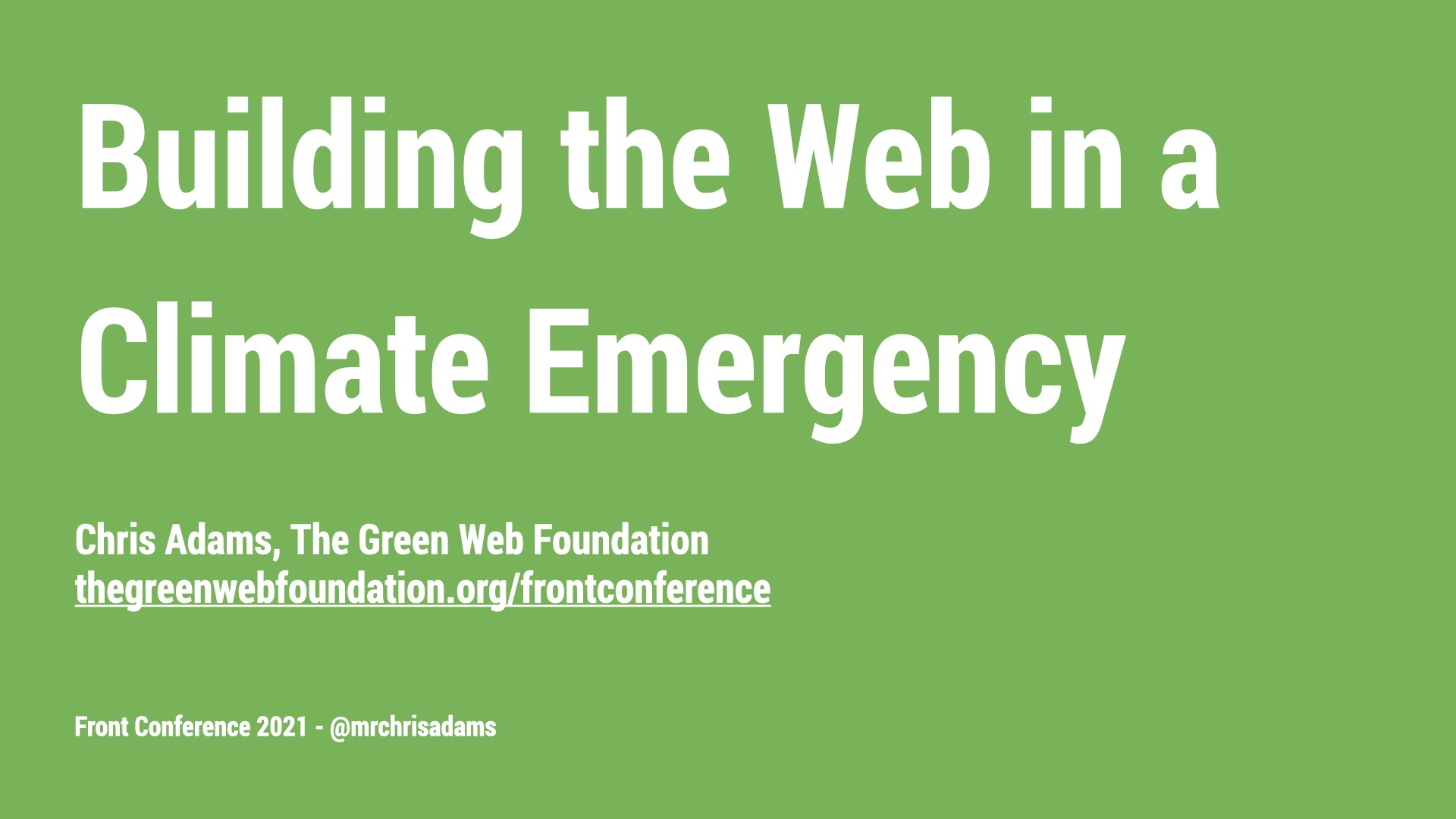
|
# |
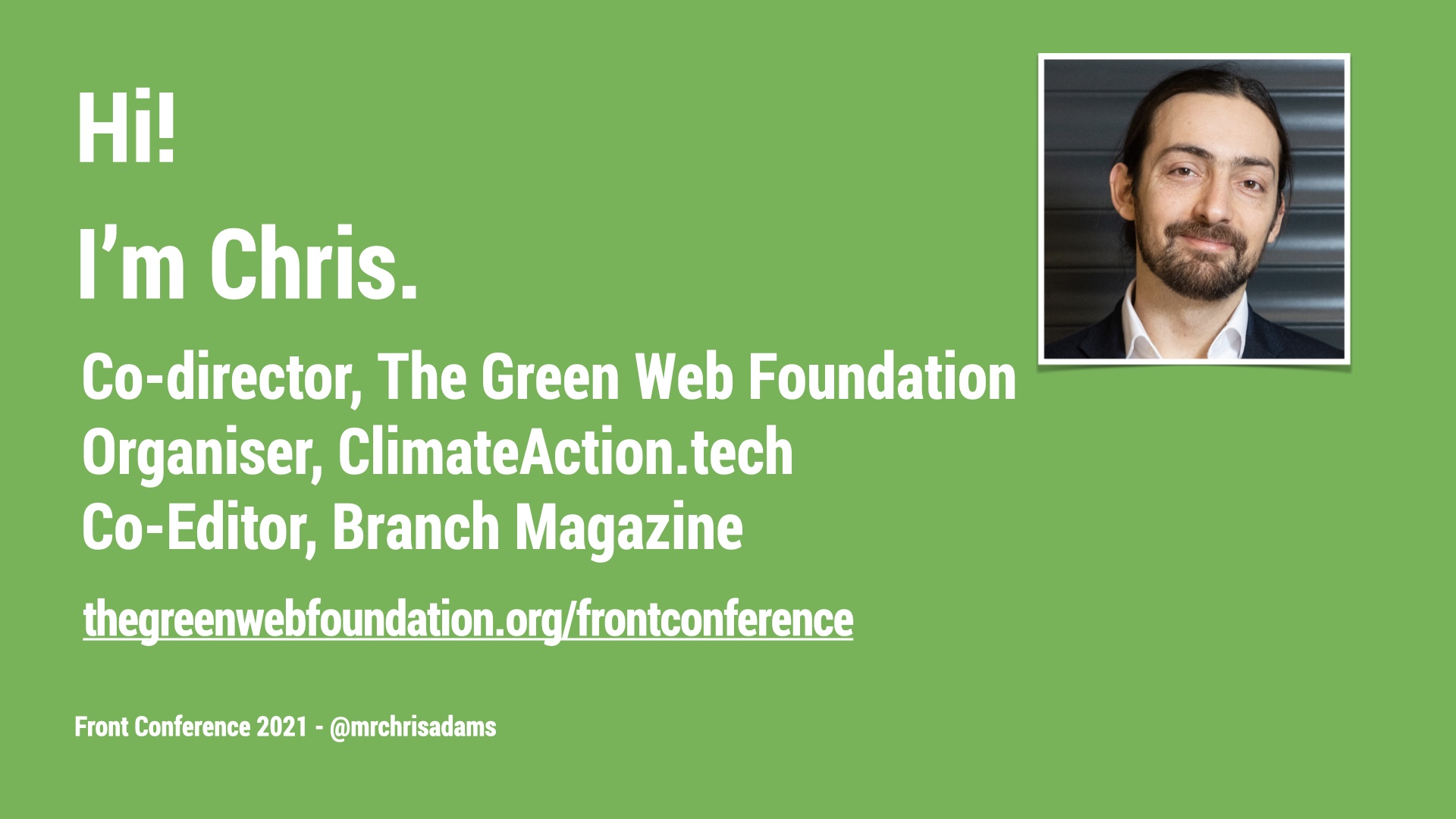
|
Hello there, Front conference. Thank you for having me here in Zurich. As the slide suggests, my name is Chris, and I am one of the directors of the green web foundation, an NGO that exists to work towards an entirely fossil free internet by 2030. I’ve spent the last 15 years working for a string of wacky environmental data themed startups, and the last three years helping run an online community, climateAction.tech. Which, as the name also suggests, is a community for climateAction amongst techies. I’ll try my best to talk clearly and slowly in the time I have with you, but if you miss anything I see, this deck should also be online at the link you see on the screen now, with a full transcript of what I say today. # |
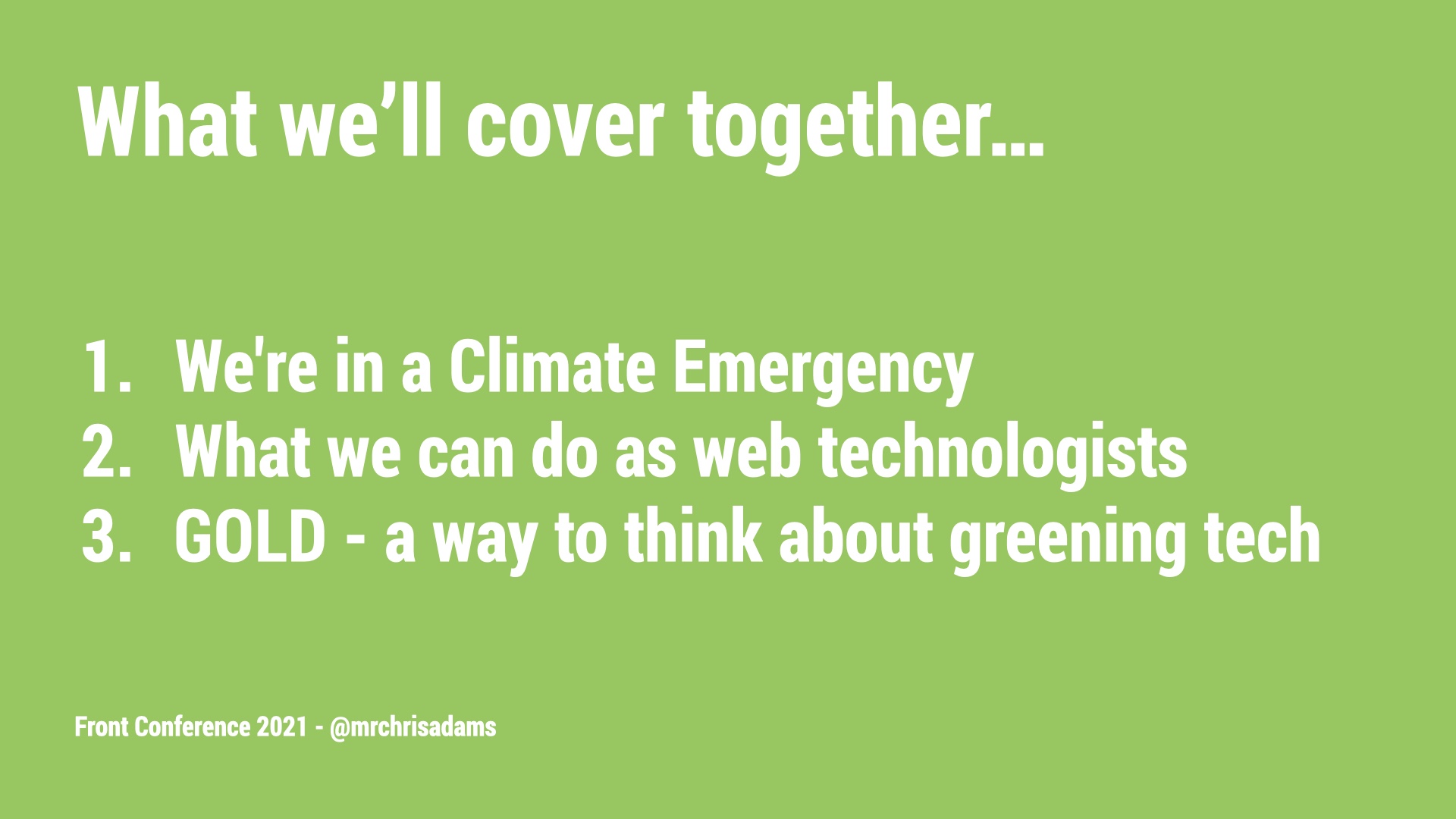
|
In the limited time I have with you, I’m going to try to cover these three topics. We’ll spend a bit of time talking about climate emergencies, how we got here, and how to handle the mental toll that being in one can have. Next we’ll talk about some of the levers we have as professionally mobile technologists. Finally, because I don’t always get to speak to an audience this knowledgeable, I want to ask for your help refining a model I am developing to integrate an awareness of climate into our work. # |
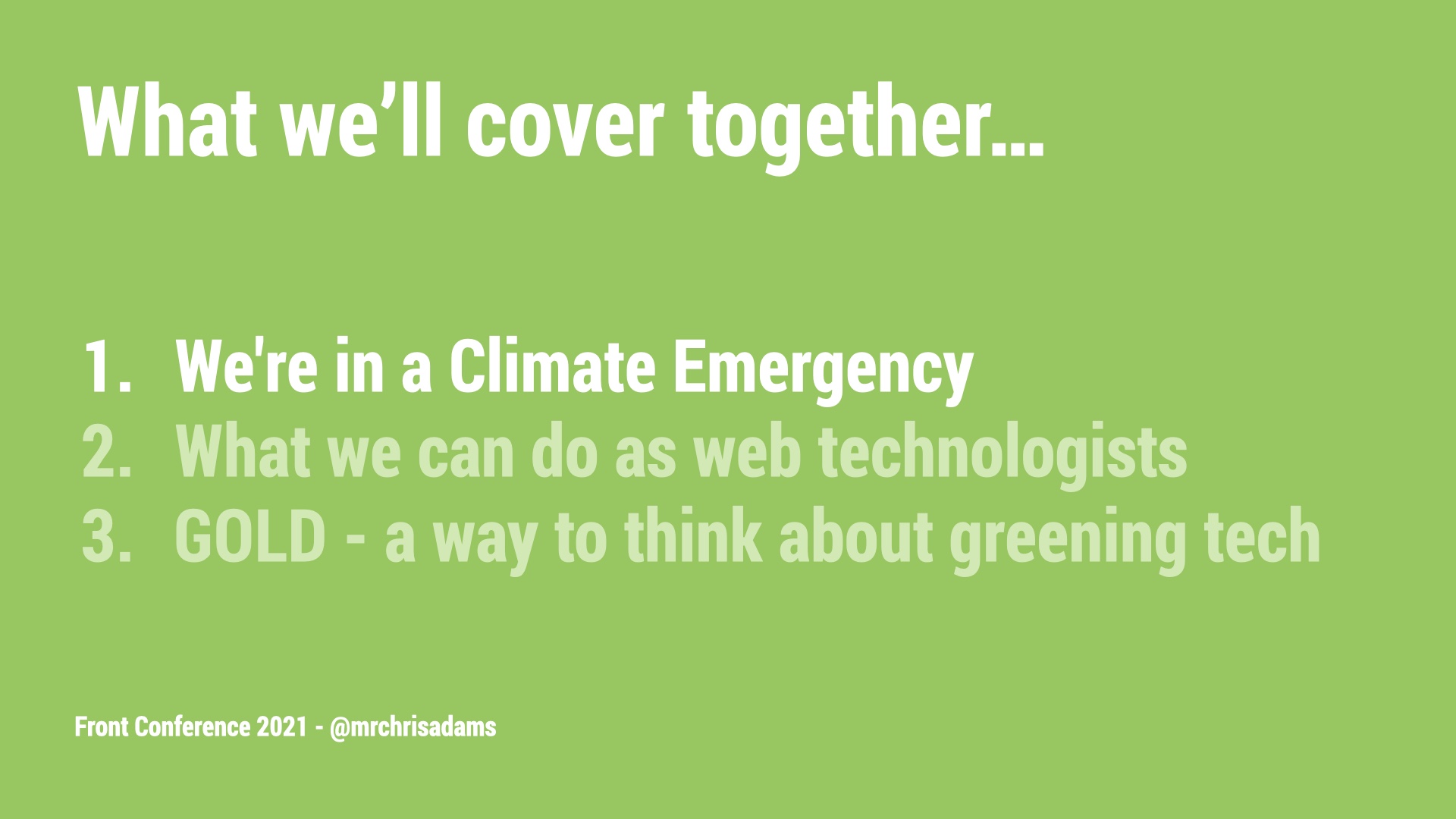
|
Are you sitting comfortably? OK, off we go! # |
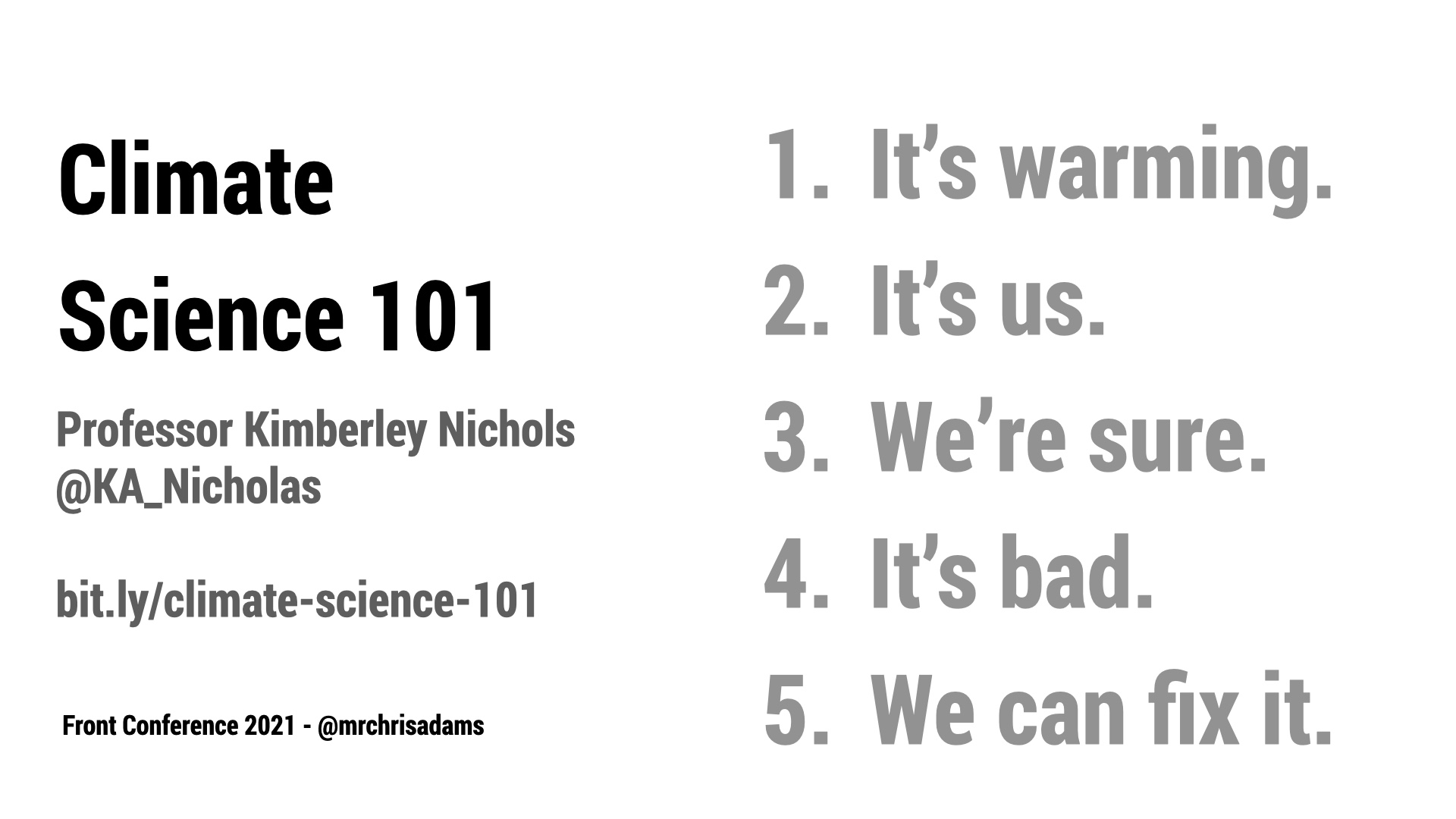
|
OK, this is your first tweetable slide. I’m not sure if we still take photos of slides at conferences, because it’s been ages since I’ve been to an actual conference. But the link you see here is to a thread on twitter from Professor Kimberley Nicholas, an actual climate scientist who I really respect. If you follow the link, you’ll see a thread explaining this mantra point by point, with a boatload of references. I also finished her book yesterday which I can highly recommend. Ayway, I’m sharing this as a TLDR with you, because previously when I’d give talks about the state of the climate, I’d usually spend a bunch of time trying to explain that climate is a problem, and show a bunch of stats and numbers. These days, you only need to turn on the news to see these climate impacts, like the sea being on fire, or videos about towns being washed away in climate related floods. These are spectacular, but not so useful for action. So I’ll hope you’ll be ok with me sharing this mantra instead. The earth is warming. Yes, it’s us. Yes, we’re sure. Yes, it’s bad. BUT we can fix it. https://bit.ly/climate-science-101 # |
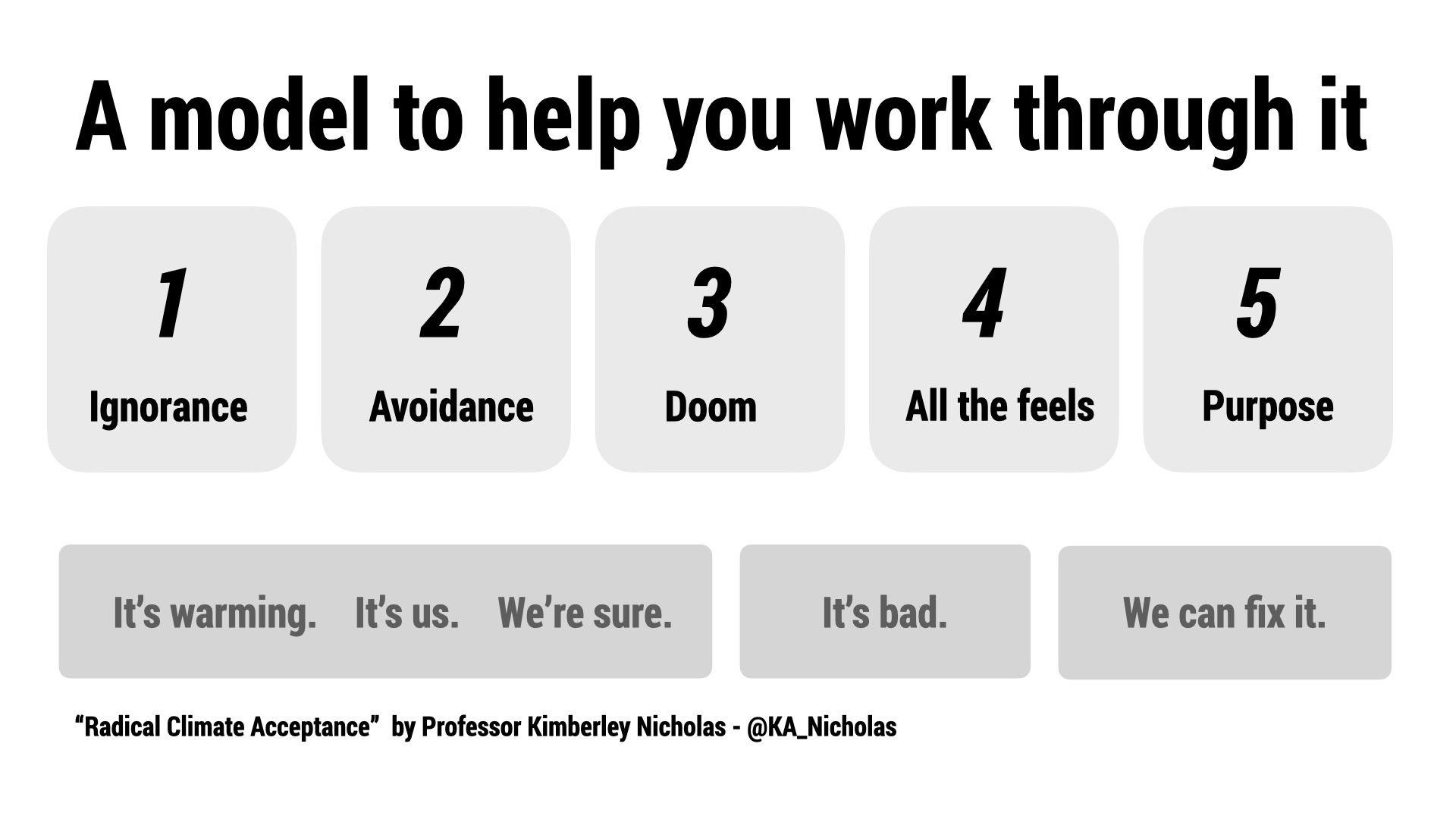
|
In addition, I’ve found this model she shares really helpful for how we internalise news about our changing climate. Has anyone here heard of the 5 cycles of grief before, when you hear bad news? Y’know… denial, bargaining, anger, depression, acceptance? This is a little bit like that. Engaging with the subject of our changing climate can be emotionally exhausting. But knowing there’s a process people work through, and stages you might recognise you’re in, or see others in is useful. # |
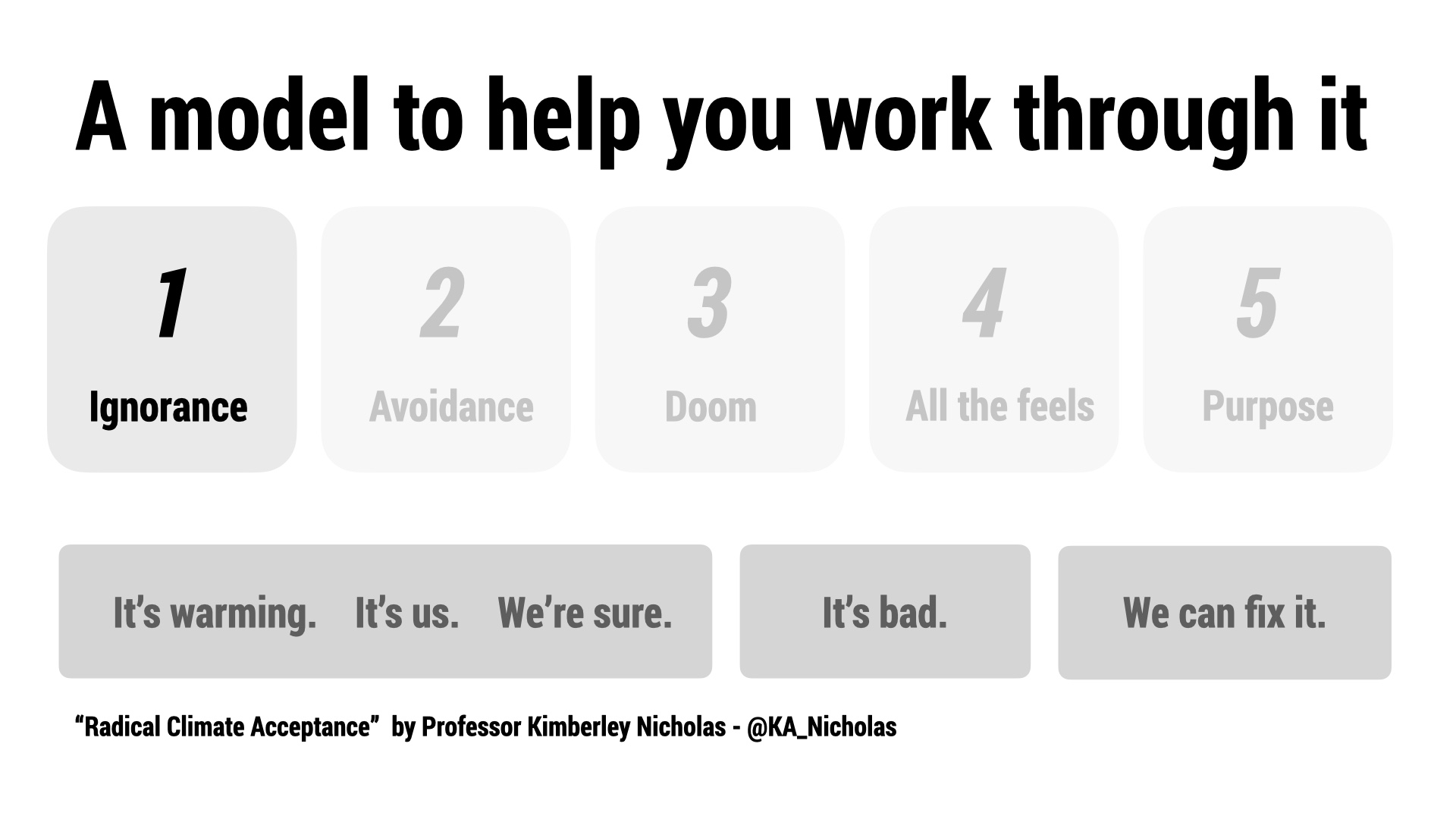
|
We might start with ignorance around the subject. There are various valid reasons this might be the case - not least because historically, climate has been a subject that’s been really poorly covered in the media. # |
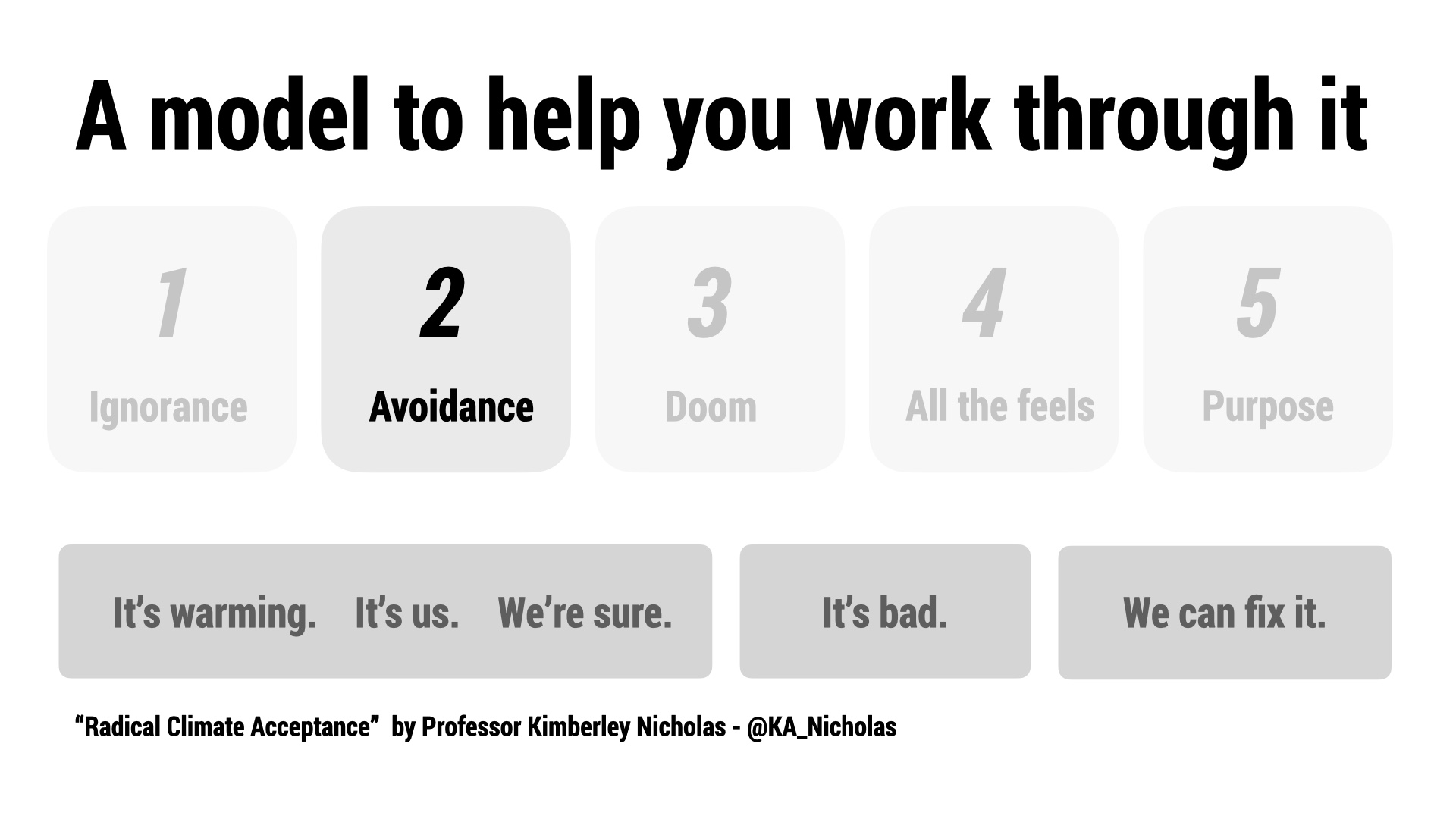
|
Next, when we have learned more about the changes, we might find them uncomfortable and distressing to think about. A lot of us might resort to avoidance. We might avoid talking about it with others, especially at work or family gatherings. # |
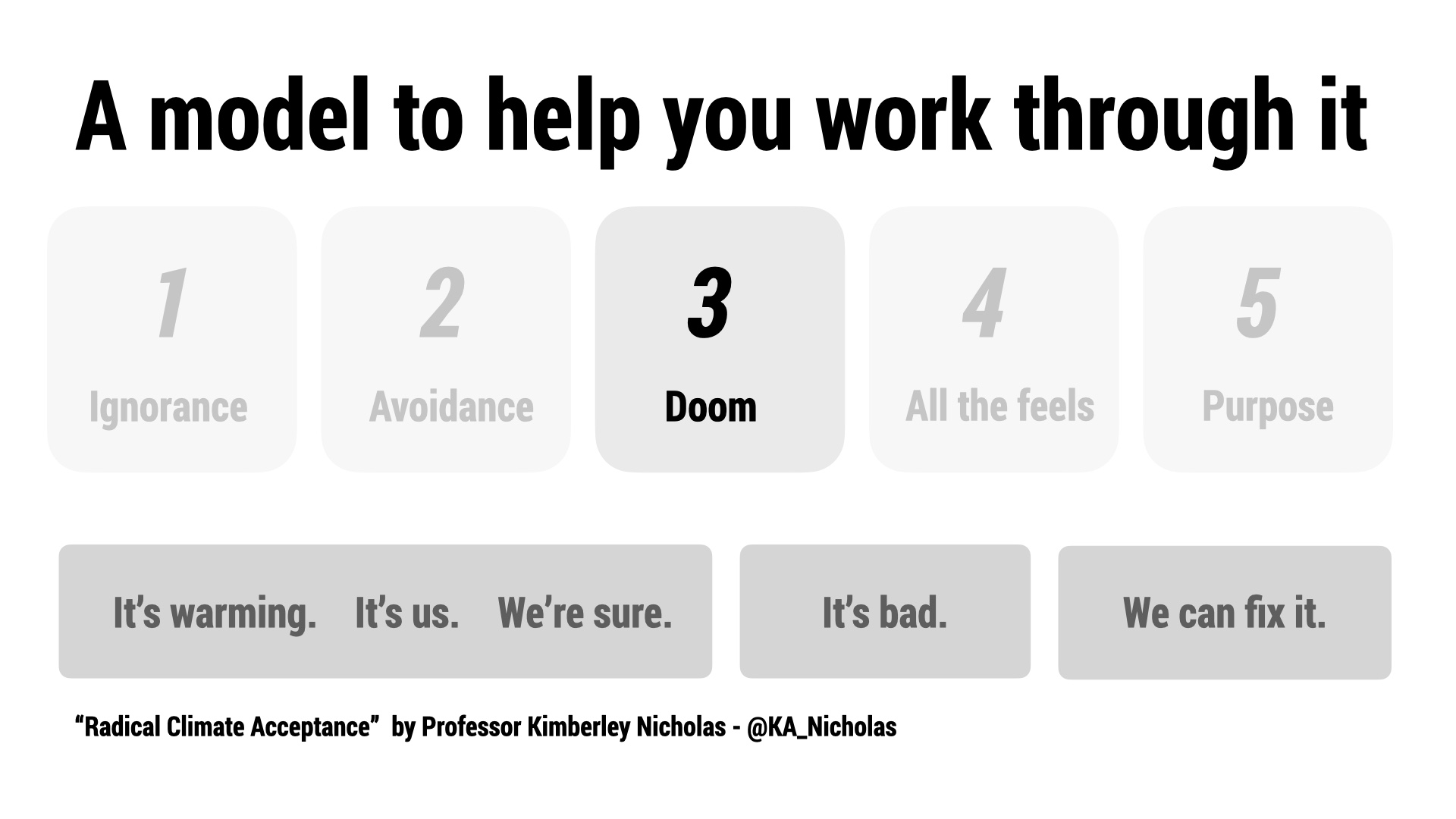
|
Next, when we do learn more, it’s easy to slip into a pretty depressed state, doom: “oh jeez, we’re done for. Why even try to change anything? Let’s just make the most of the time we DO have”. While I can see how we get into this state, it’s important to understand that is a form of denial and retreat. Broadly speaking, only certain groups, who are often white, and in the global north, get to be all OK DOOMER about climate, while not being all that exposed to the climate crisis like this. There are so many people who are exposed to these impacts already, and are still managing to keep doing their best to help each other, and find time to act on climate. I think that’s a better example to look to, if they can do it, and they’re already having a harder time than me, then it makes me think I can put time and effort into acting on climate too. # |
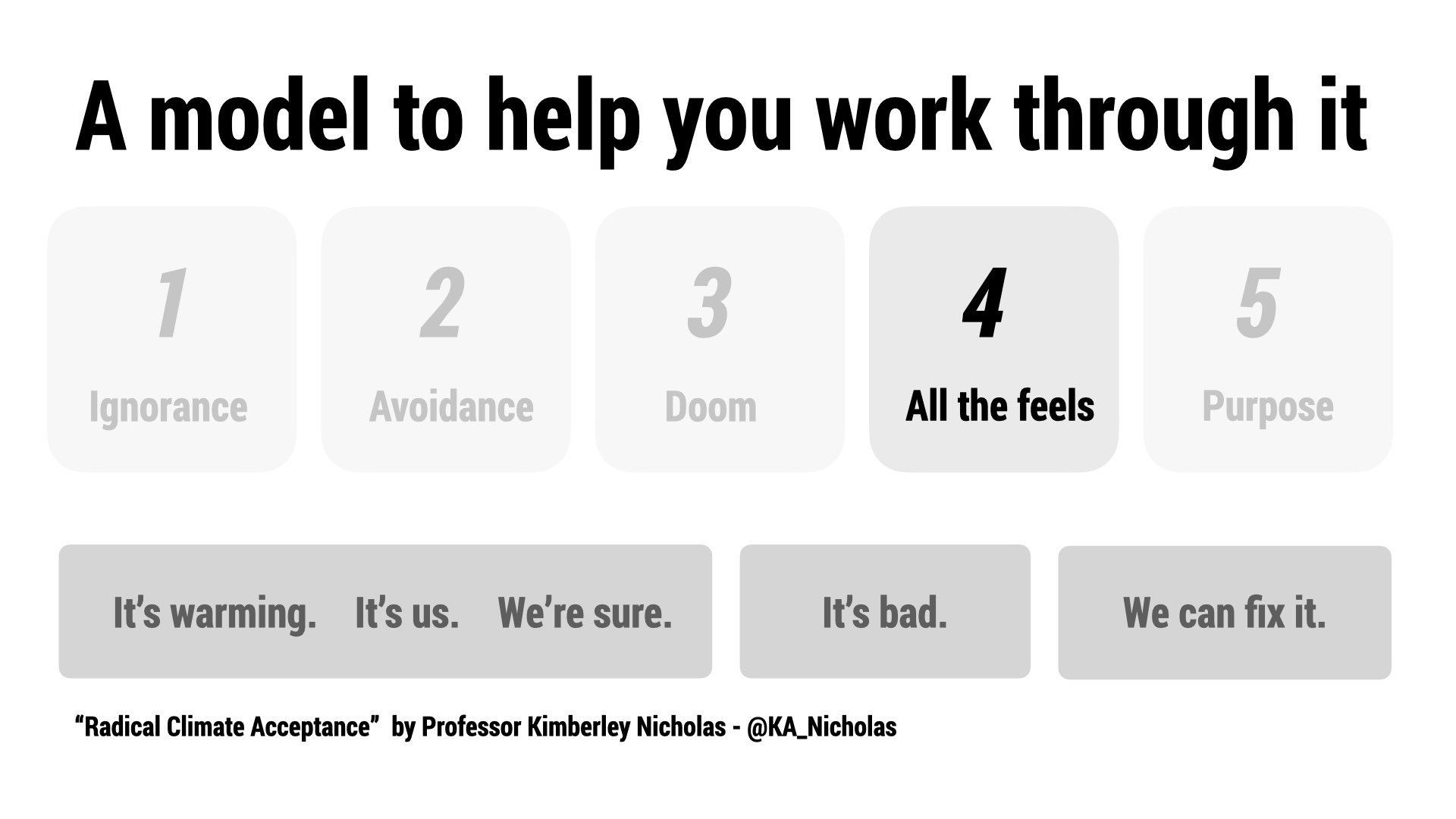
|
With help and support from others, you might get through to the next stage - all the feels. How do I talk to children about this? What kind of changes would we need to face the scale of the challenges before me? There’s so much to question! What kind of society do I dare hope for now? Does what I am learning about climate mean I am bad person? This is a pretty overwhelming stage, and we’re not really taught how to navigate this kind of uncertainty. I think it takes some bravery to face it all. It’s important to realise this as you go through this whole process - you don’t need to be perfect to starting acting or even engaging with the subject, but you do need to be brave. # |
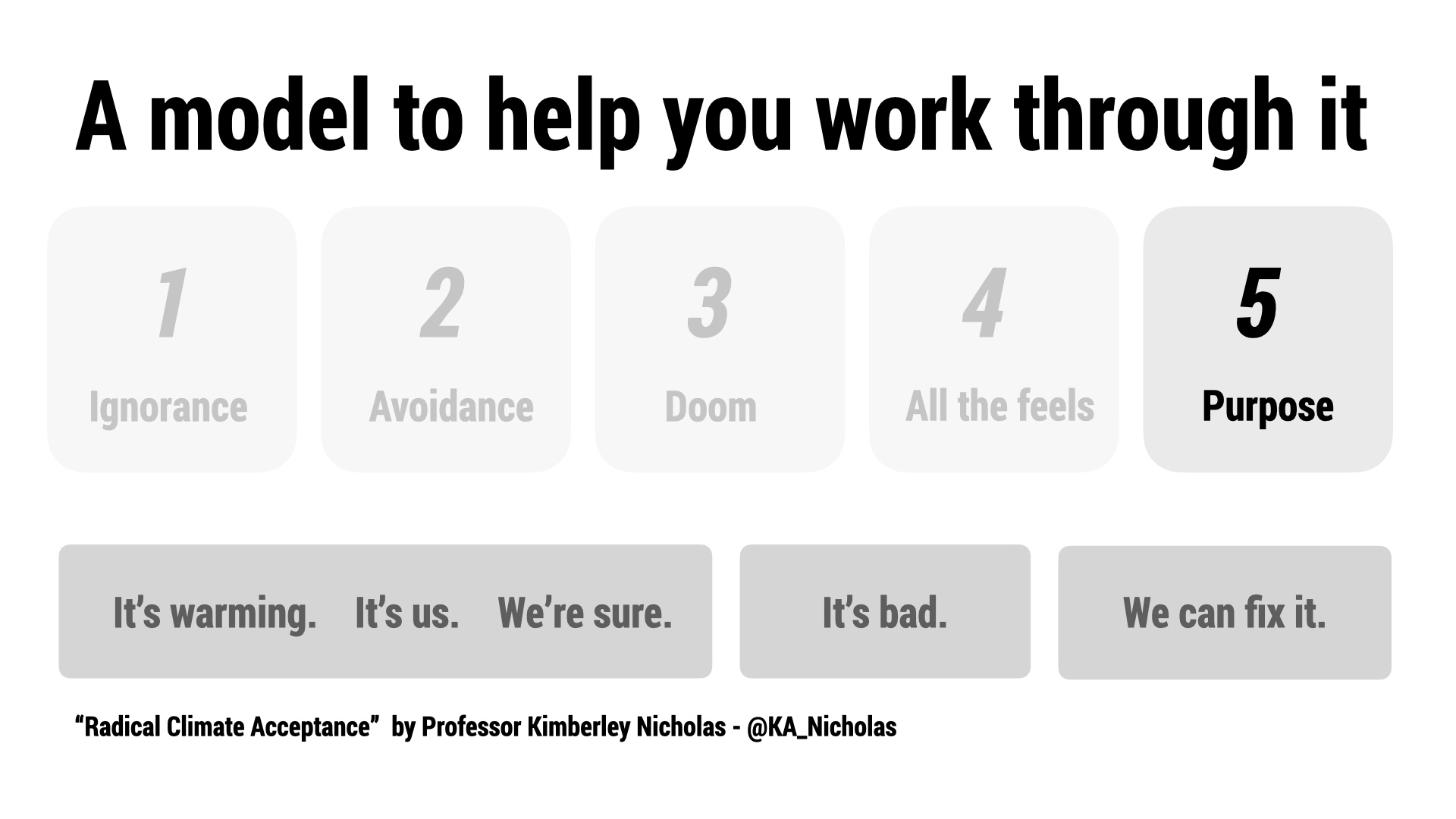
|
This all the feels step eventually gives way to purpose. You learn to harness the emotions you have, and you see the need for action. You decide to sound the alarm, and do something. # |
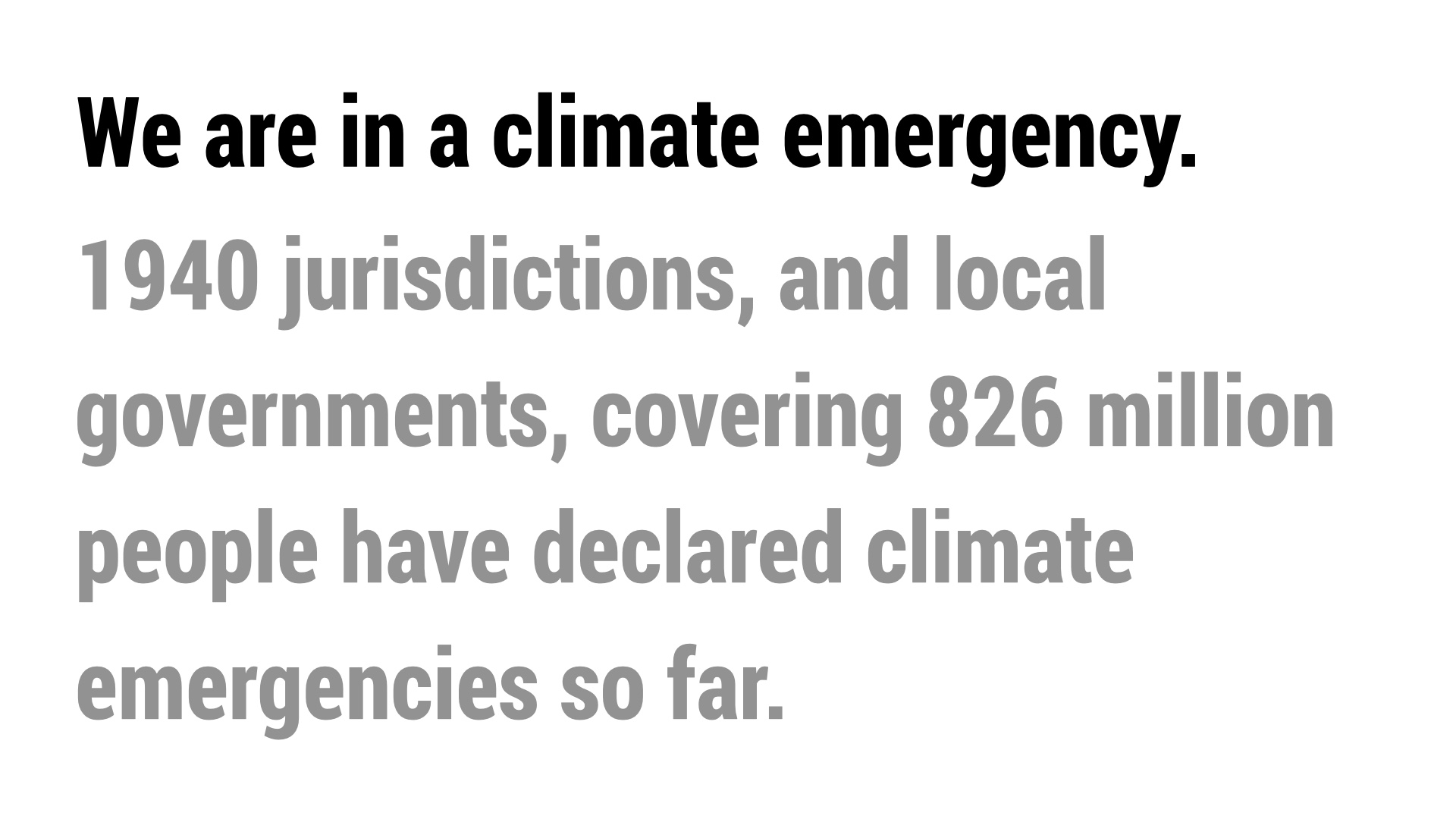
|
When you get here, you’ll find you’re in good company. Hundreds of governments, cities and companies are sounding the alarm, and declaring climate emergencies, and starting to act. You’re not alone. # |
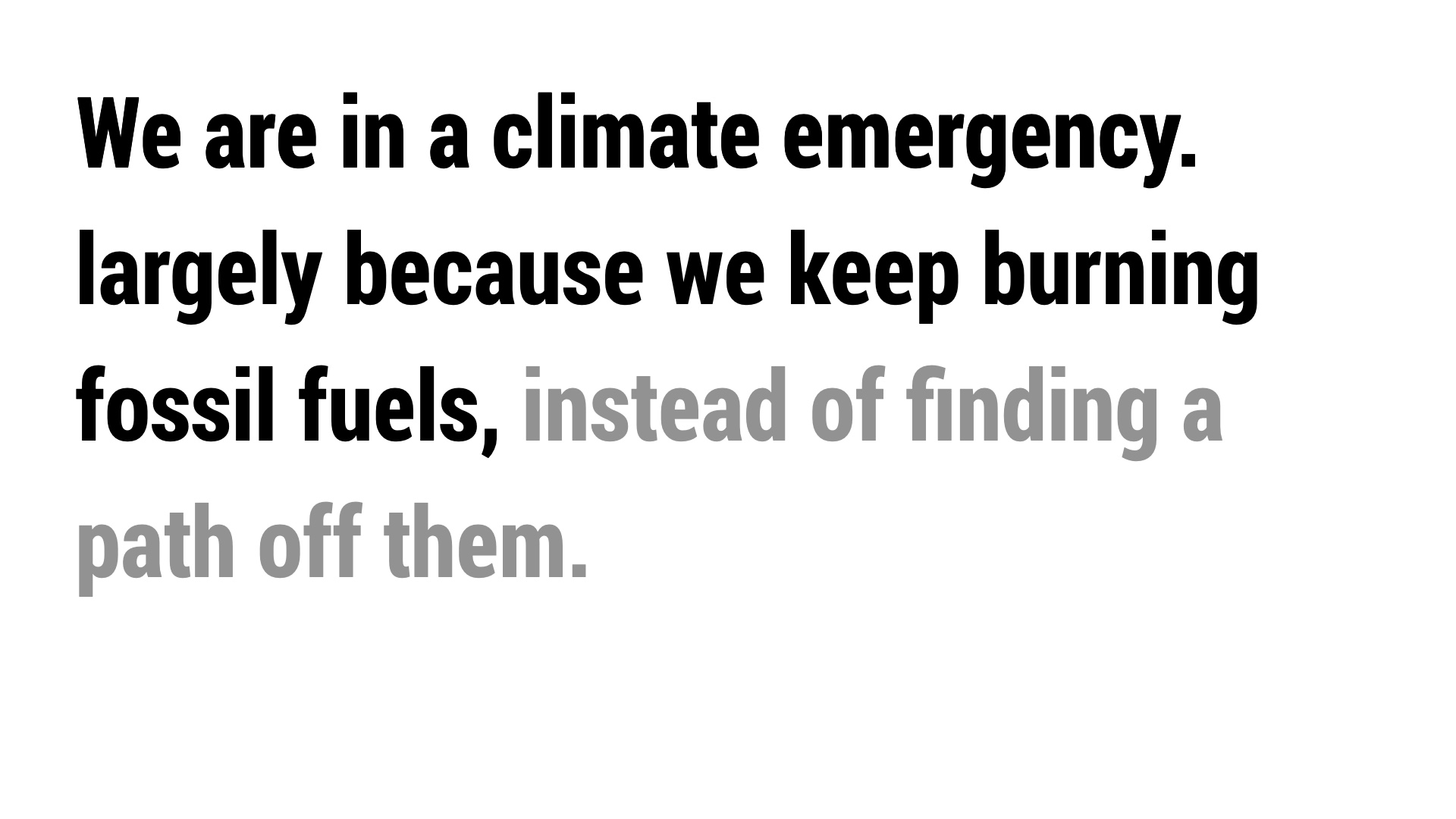
|
It’s important to know that one of the reasons we’re in an emergency, that we often forget, is that we’re here because we keep burning fossil fuels, instead of finding a way off. This isn’t an accident. # |
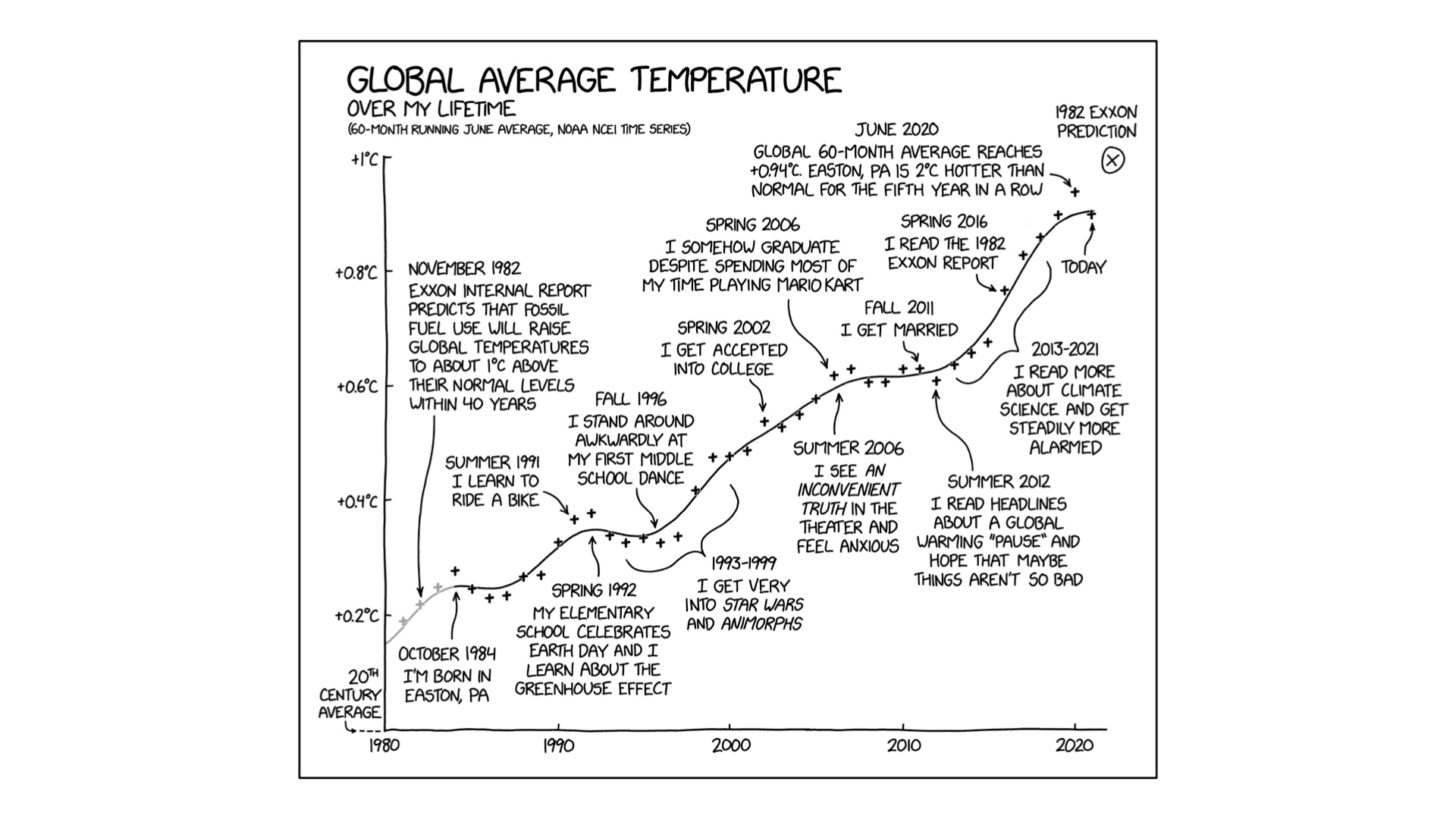
|
What’s a tech conference without an XKCD cartoon these days? This was released recently, and it’s helpful for understanding this “not an accident” point. Some groups have known about climate change for absolutely ages - longer than many of us have been alive. Check the date to the left of this chart, and then check the prediction one the top right. Some groups have decided that it’s better for business to delay action on climate, and sow doubt and uncertainty over the decades instead. XKCD cartoon: https://xkcd.com/2500/ # |
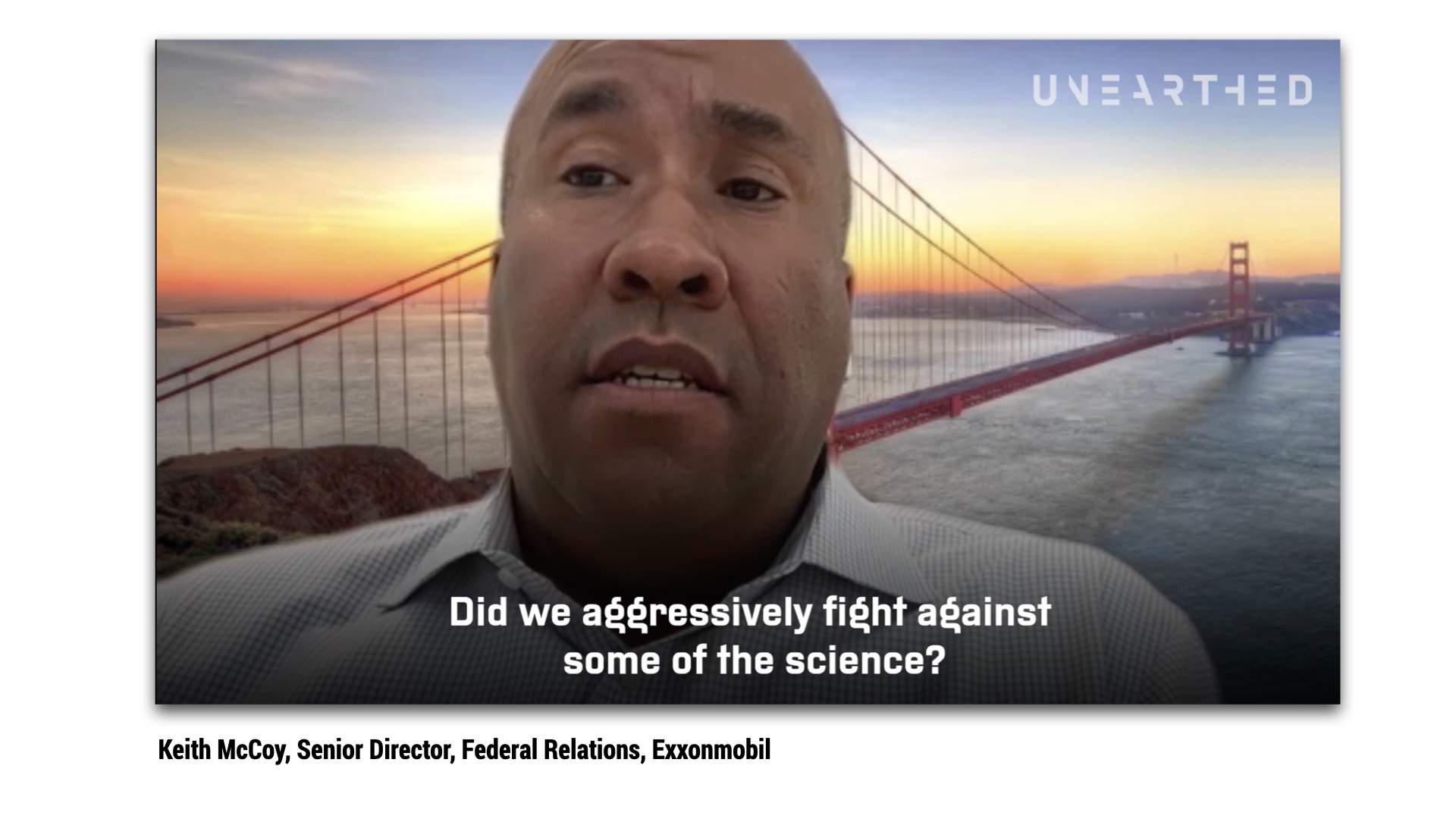
|
This hasn’t stopped. Earlier this year, Greenpeace caught out a senior employee at Exxon Mobil, posing as a group looking to hire him as a lobbyist. They basically ended up with an hour long, speed confession in high definition on a recorded zoom call, where he explained a bunch of the tactics they use, and what impact they’ve had. He even ended up on camera talking about what they’re doing right now, in 2021 to sabotage the political process and slow down action. OK, quiz time. I won’t try a playing this video, but what do you think the answer is to this rhetorical question here? Did they aggressively fight against some of the science on climate? For more, I’d really recommend the climate town channel, and the recent video about this - it’s funny, informative and definitely worth your time. Climate Town Video: https://www.youtube.com/watch?v=Evy2EgoveuE # |
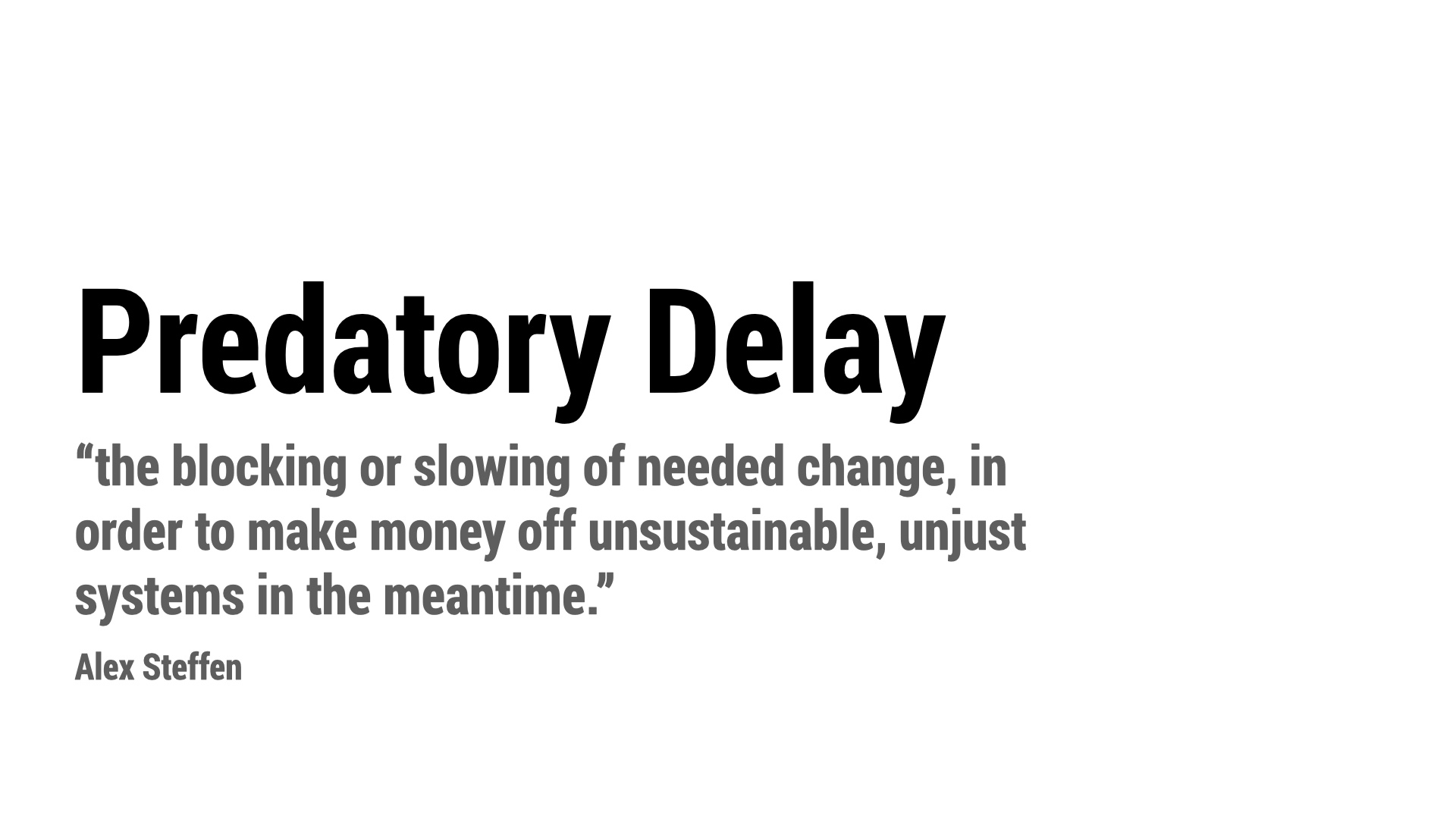
|
There’s a useful term for this kind of activity - a bit like how dark patterns became a useful term to talk about bad UX practices that work against the interests of our users, Predatory Delay is a term to describe this behaviour. The blocking of slowing of needed in change, to make money off unsustainable, in just systems in the meantime. # |
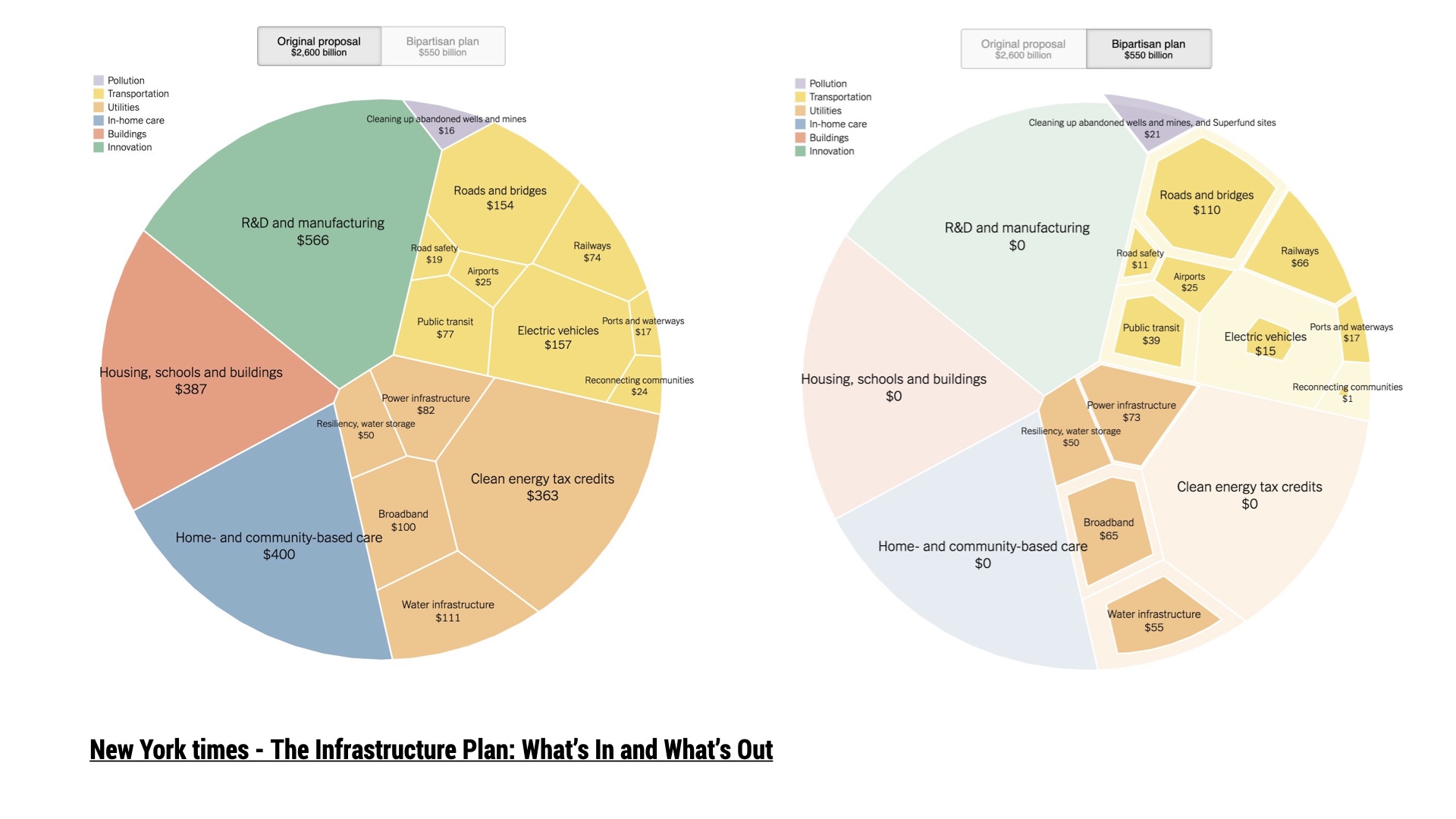
|
Predatory delay is what does this to climate Action. Earlier this year, the US government was going to pass a historic infrastructure bill. It was going to fund loads of investment in areas key for climate action. These would be good for humanity, but bad for fossil fuel companies. Almost 2.6 trillion dollars of funding for investment, research and development, and in general help to move to clean energy was proposed. But after loads of aggressive lobbying, well… what you see on the right gives an idea of what predatory delay looks like in the political process. New York Times - What’s in and what’s out: https://www.nytimes.com/interactive/2021/07/28/upshot/infrastructure-breakdown.html # |
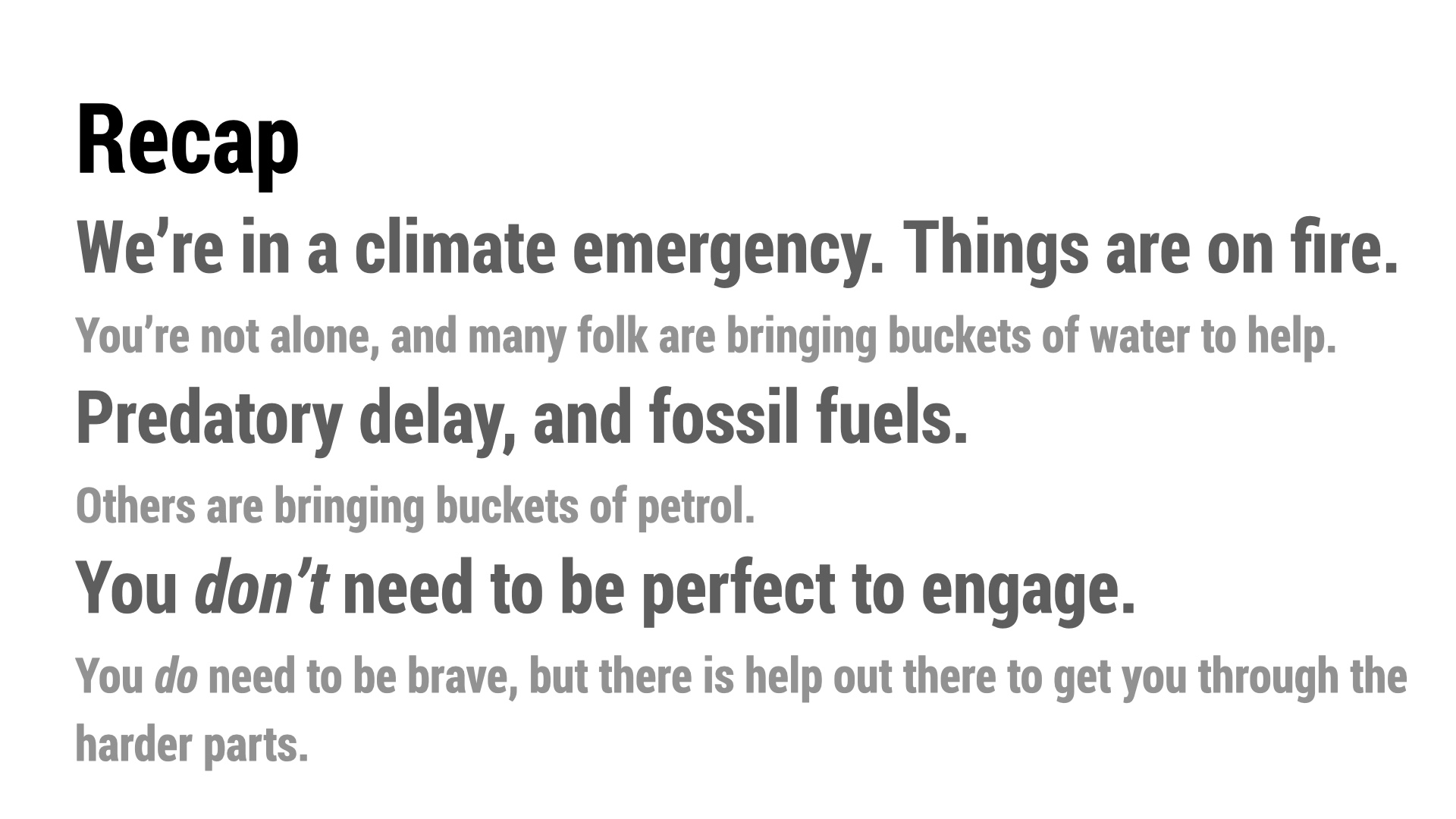
|
So here’s our recap. We’re in a climate emergency, and our house is on fire. You’re not alone in caring, and there is a growing movement for climate Action, who are working to put it out. Sadly, there are others that benefit from you staying disengaged, or stuck in a doom state, and they’re working to keep you there so they can still make tonnes of money. To continue our fire metaphor, they’re bringing buckets full of petrol instead of bringing buckets of water. You don’t need to be perfect to engage, and there’s help out there. # |
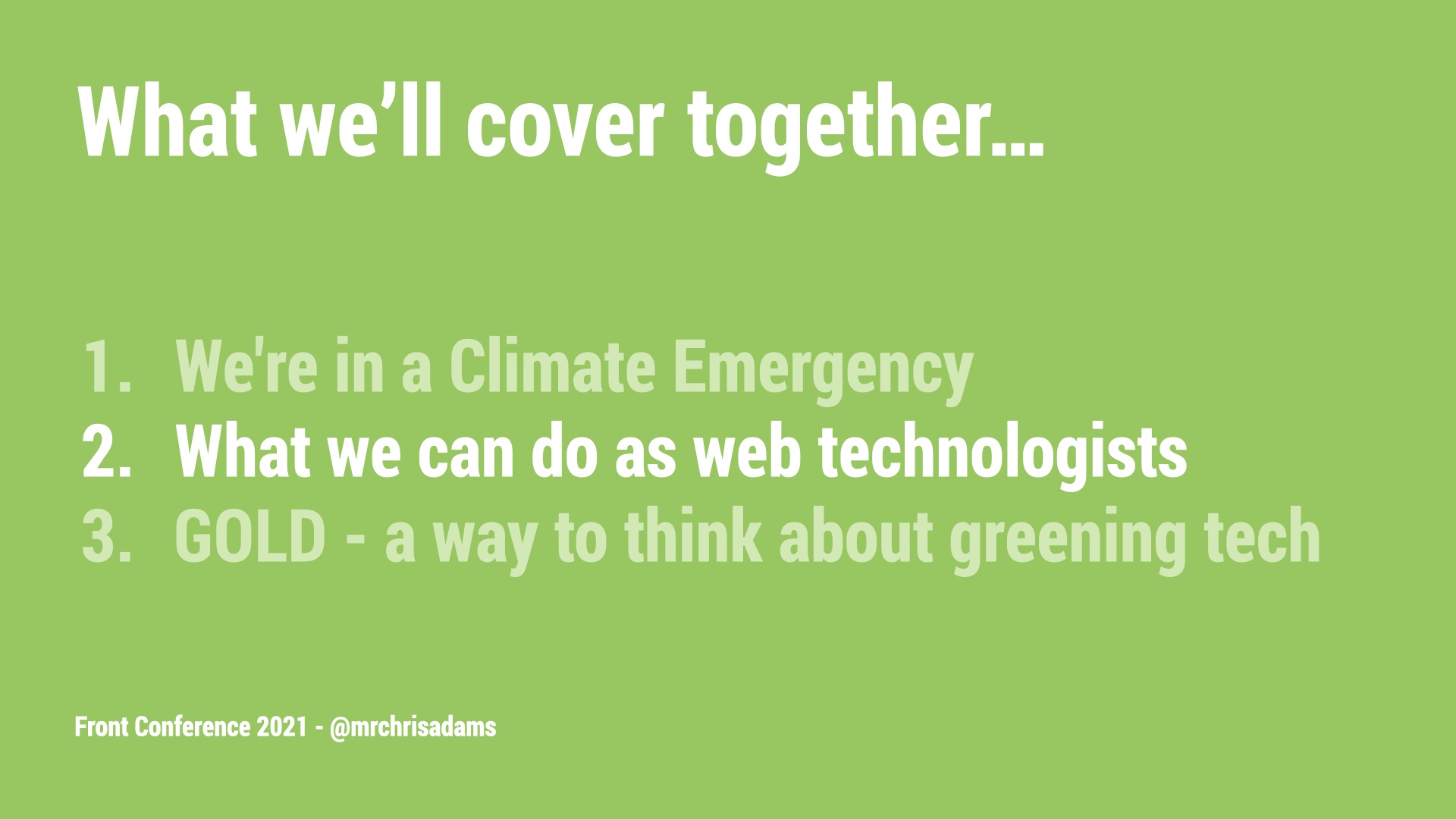
|
Ok, now we’ve figured out we need to do something, what can we do? What can techies do ? # |
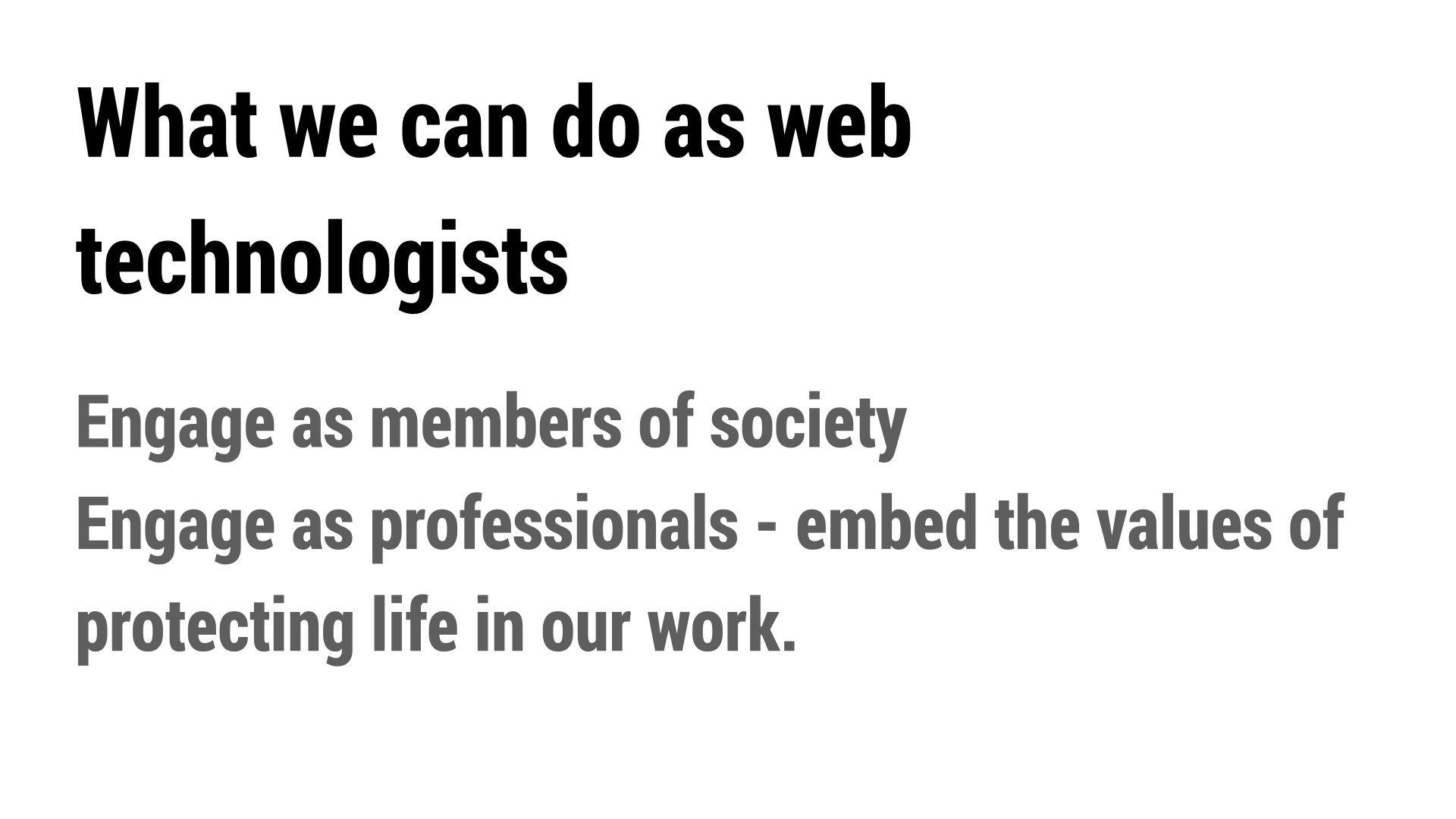
|
I think there’s two ways I’d suggest, in this order. First, I think we can engage as members of society - if you’re at this conference, you’re probably earning above median wages in your country and part of a professionally mobile group. You can do a lot in terms of offering your money, time and skills, and probably in that order. Secondly, I think it’s worth embedding the principles around climate Action in our work. I say this as I think we can point to examples of where we have seen similar ideas work on the web before. # |
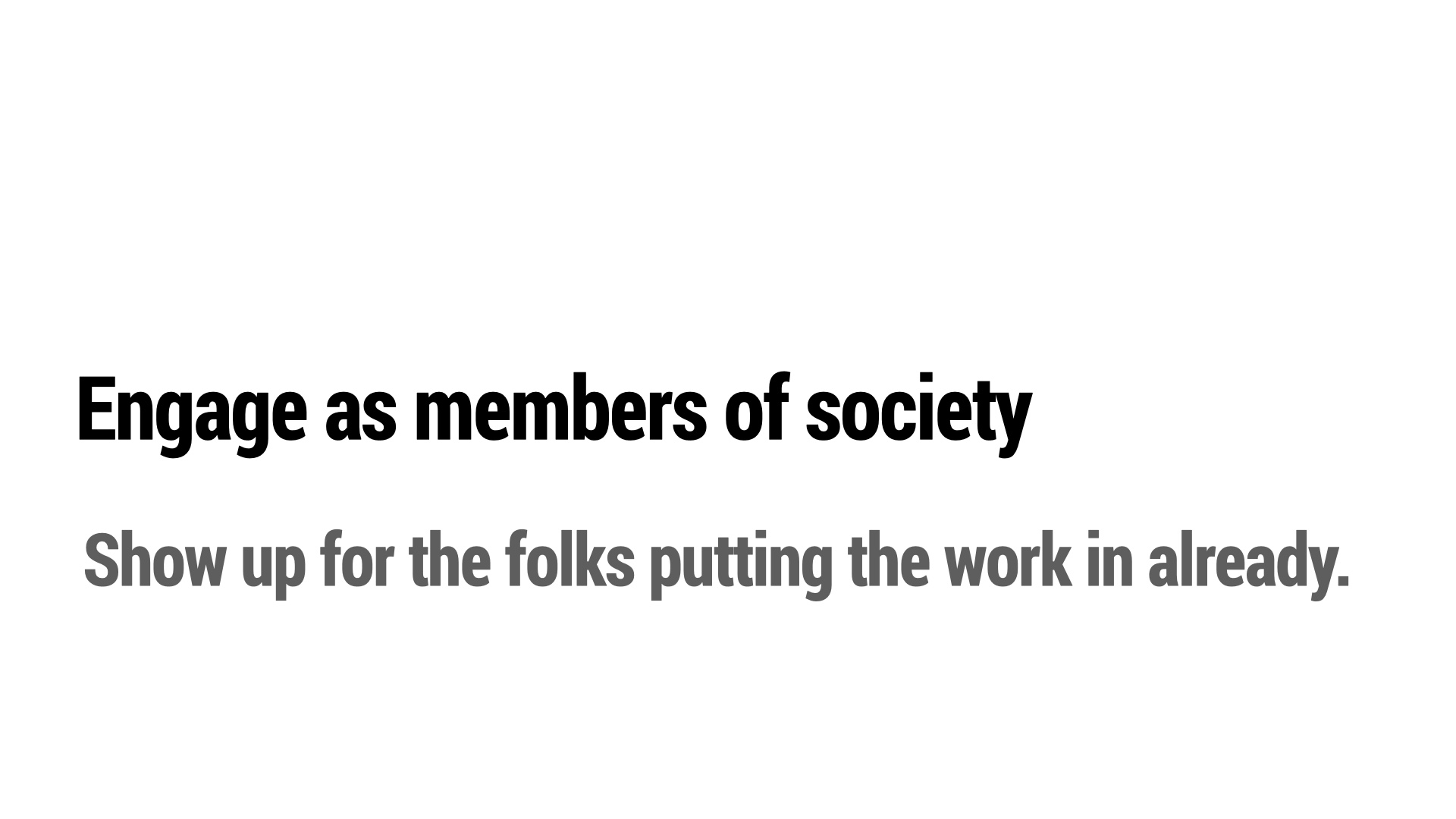
|
So, first of all, remember there’s a movement, and there are lots of people putting the work in because they’re scared and need your help. # |
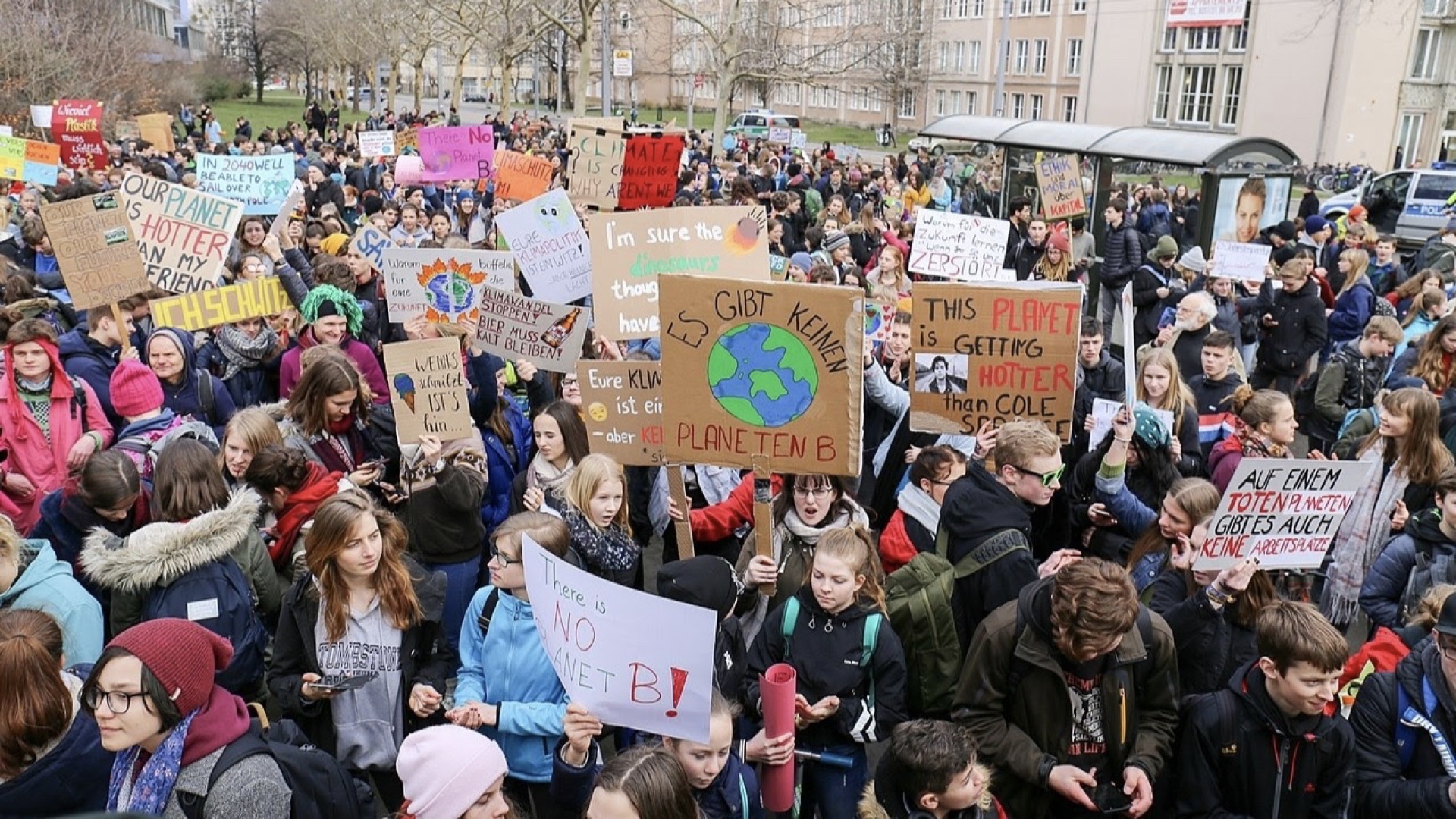
|
Fridays for future is an example - Fridays for future is a global movement of schoolchildren who every Friday protest for grown ups like us to work act on the climate crisis. They do this because most of them are too young to vote, and they don’t have the power get things changed by themselves. Kids like Greta and the folks you see here turning up each week have done so much to change perception. But they’s not all they’ve been doing. # |
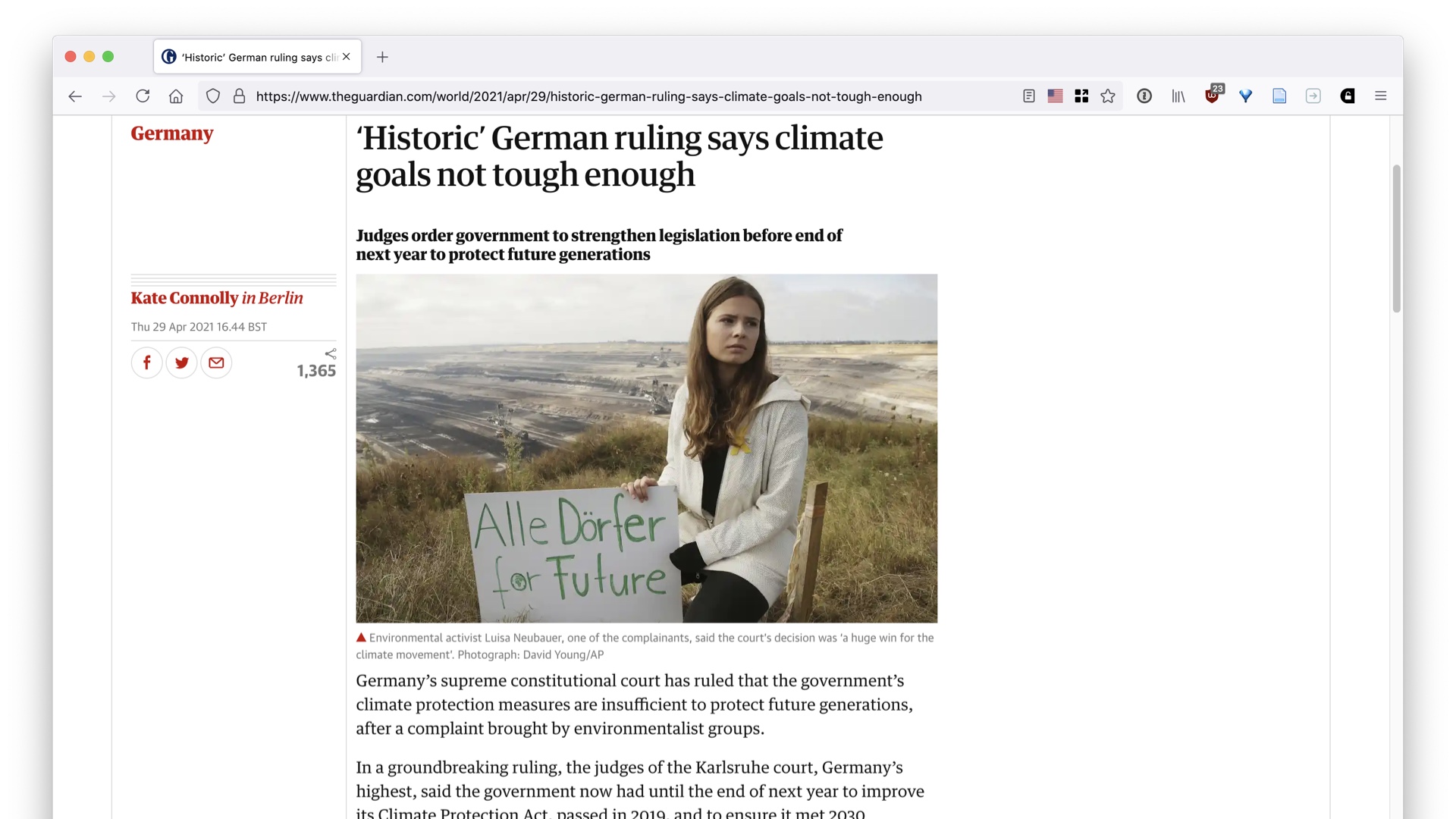
|
They’ve been able to change perception around climate enough to start influencing the public discourse, and it’s important to understand that they’ve been using the law to buttress these changes in how we feel about climate. They’re getting the actual laws changed too. This is Lisa Neubauer, a bit like the German equivalent to Greta - her and a group of children essentially argued earlier this year that government had a duty to care to children as citizens of the country. They argued that Government inaction was infringing their human rights, and they won a massive court case earlier this year. # |
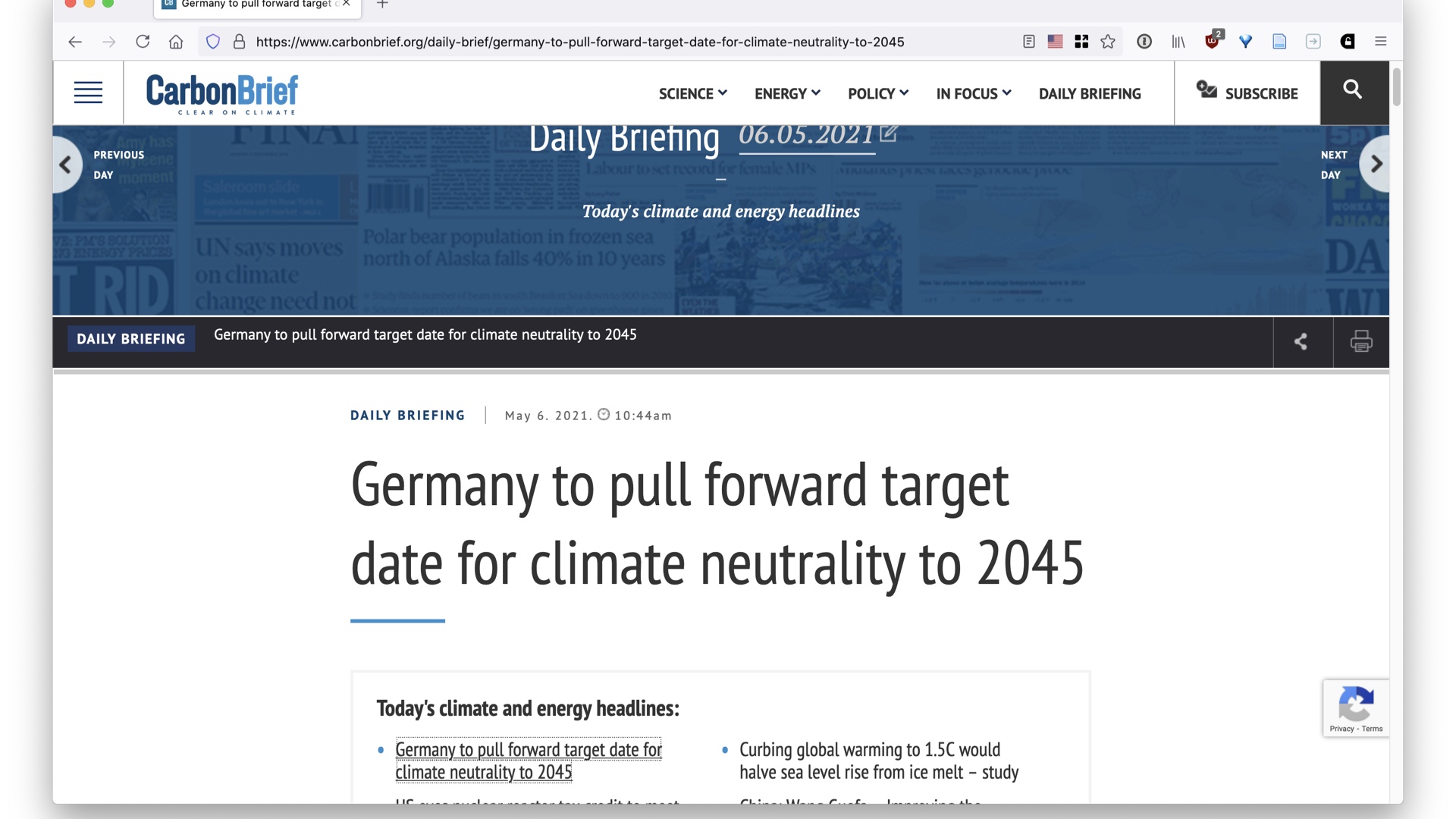
|
This had a huge impact - they got the law changed to compel the government to act with more urgency on climate. They got national targets of the fourth largest economy on earth brought 5 years ahead of to get to net zero! # |
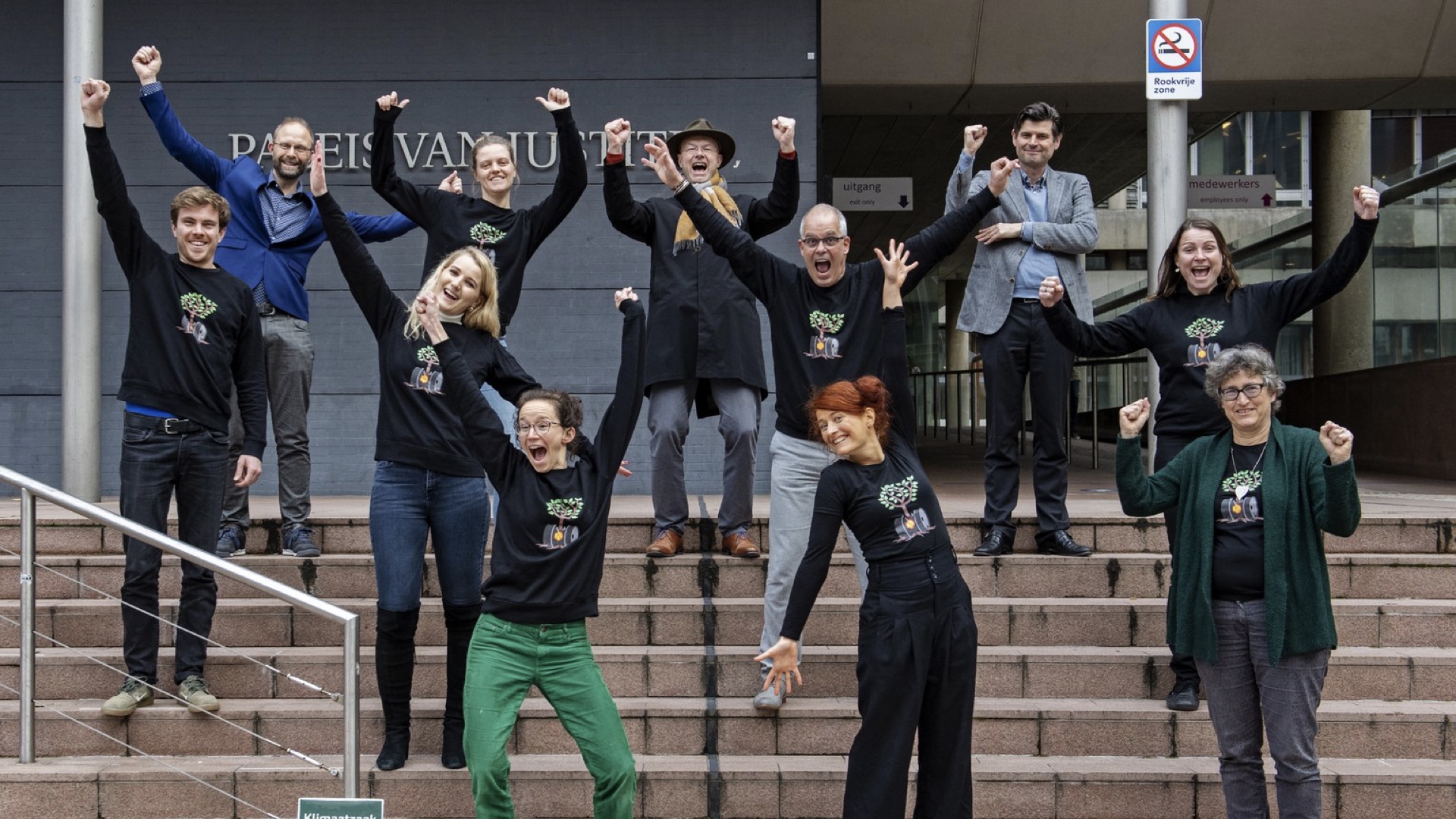
|
And you don’t just see this in Germany. I love this photo - it’s Milleudefense - to the Dutch equivalent of friends of the earth. This is what it looks like when bunch of normal people win a landmark lawsuit against a multinational oil company. They used a similar argument, that Shell Oil, through their actions, are violating the human rights of future generations of people in the Netherlands to live and have families. And in May this year, the supreme court in the Netherlands essentially said yes, that’s correct. It’s unjust for a company to be allowed to do that. The supreme court pretty much pointed to the science and pretty much said “sudo cut emissions” - ordering the company change their entire corporate strategy over the next ten years. We didn’t know we could even do this before, and this sets a massive precedent. We’re starting to see wins like this, but this late in the day, winning too slowly is the same as losing. More here: https://en.milieudefensie.nl/news/yeah-milieudefensie-wins-revolutionary-lawsuit-shell-forced-to-go-green # |
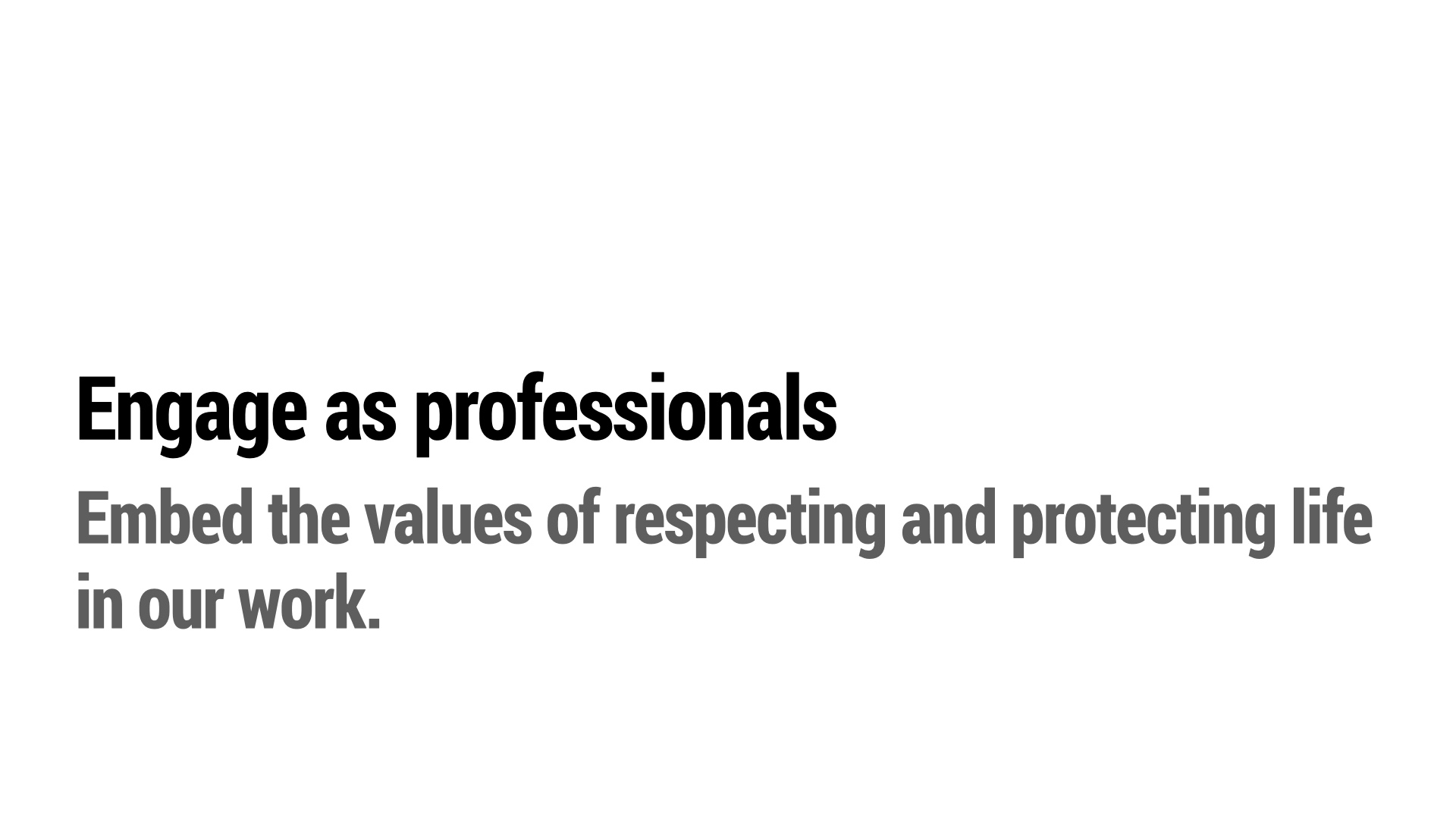
|
So one thing is to support these people already who are running up, protesting, and campaigning and working as hard as they are. The other is to embed the values of respect and protecting life in our work itself. I say that because we have had some success before here. # |
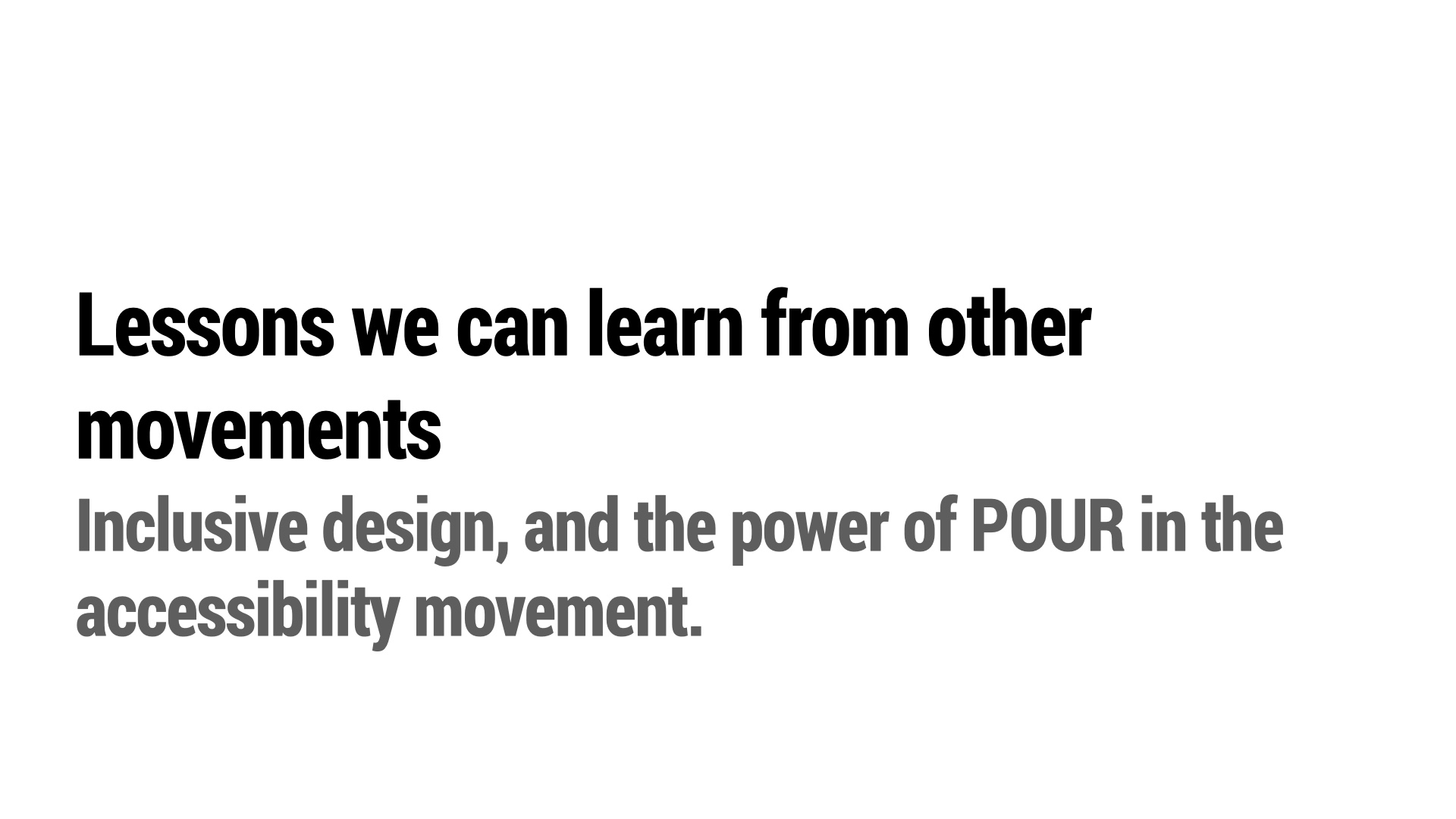
|
There’s still along way to do in the accessibility movement, but I’d argue that fact that we are even talking about accessibility as much as we do now is a positive sign. We have concepts like inclusive design that we didn’t have before, and increasingly, we talk about sites that are inaccessible as sites that are not good sites, or even sites that are broken. # |
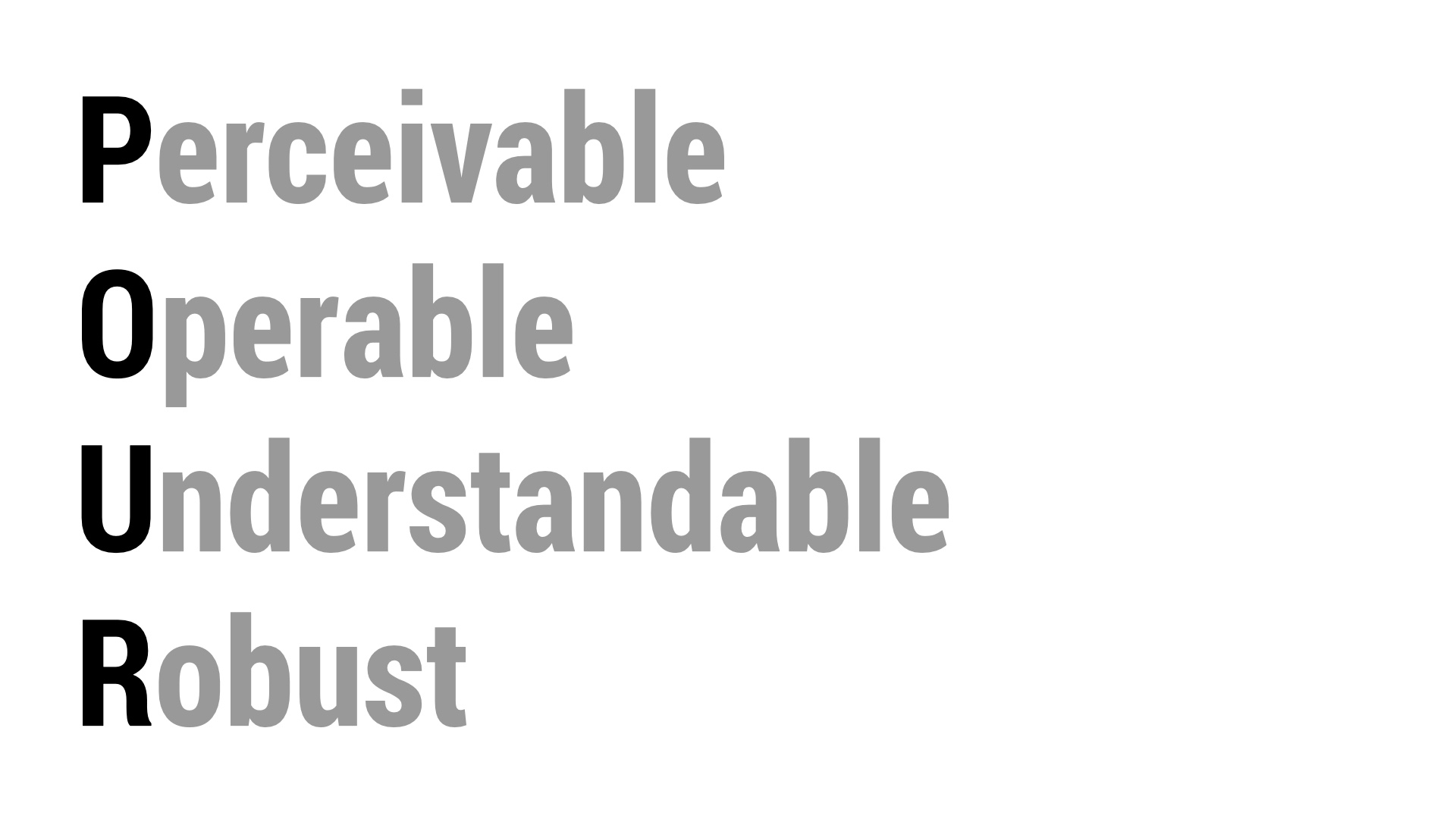
|
I think ideas like POUR have helped. For a site to be accessible it has to be: Perceivable: can I use the site without only being able to perceive the content with my eyes? Operable: can I use the site without only being able to use a mouse or touch screen? Understandable: can I make sense of the language without being an industry insider? Robust: can I still make use of the site in less than ideal conditions? POUR: https://www.w3.org/WAI/WCAG21/Understanding/intro#understanding-the-four-principles-of-accessibility # |
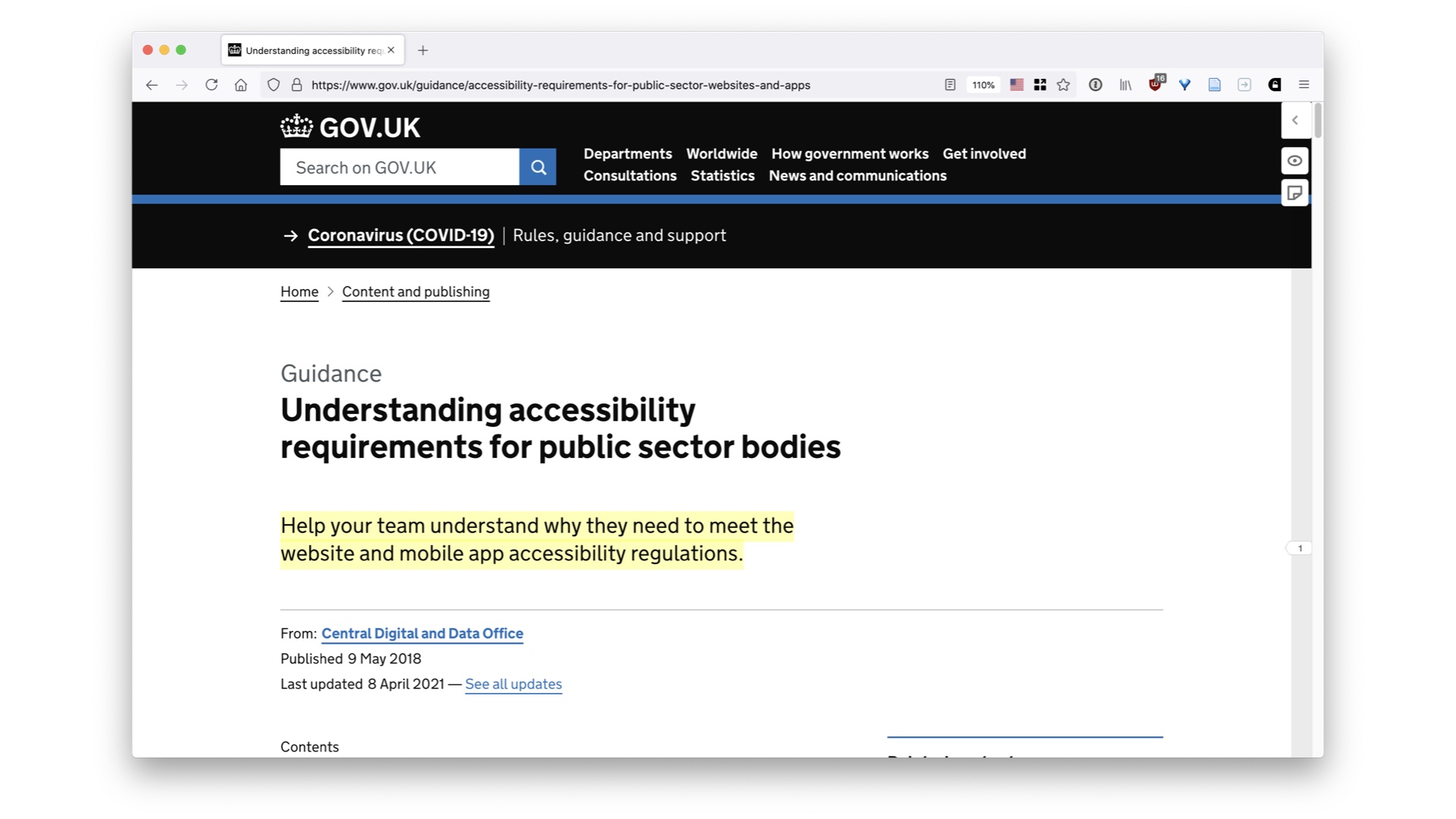
|
These form the web content authoring guidelines or the WCAG. Their existence makes it easier for people to write laws to make this the minimum standard people need to meet for a site to be considered working. GDS guidance: https://www.gov.uk/guidance/accessibility-requirements-for-public-sector-websites-and-apps # |
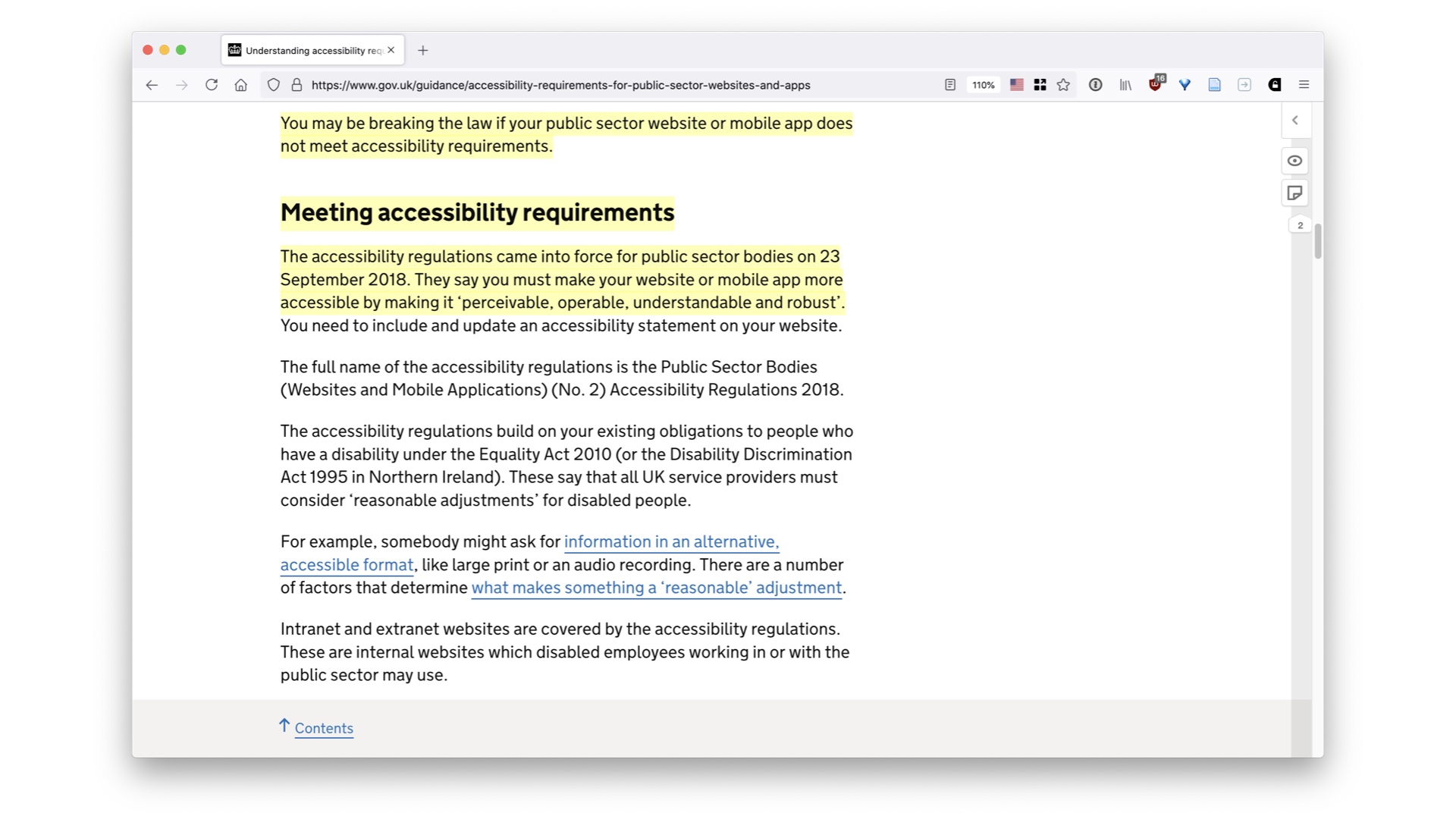
|
Having laws like make it easier to argue keep the web open to the greatest number of people. Having shorthand terms like POUR to refer to make it easier to assess and direct teams to keep sites inclusive. As an example, this is the guidance from the UK’s government digital service - they’re explicit about needing this now, and even refer to POUR. GDS guidance: https://www.gov.uk/guidance/accessibility-requirements-for-public-sector-websites-and-apps # |
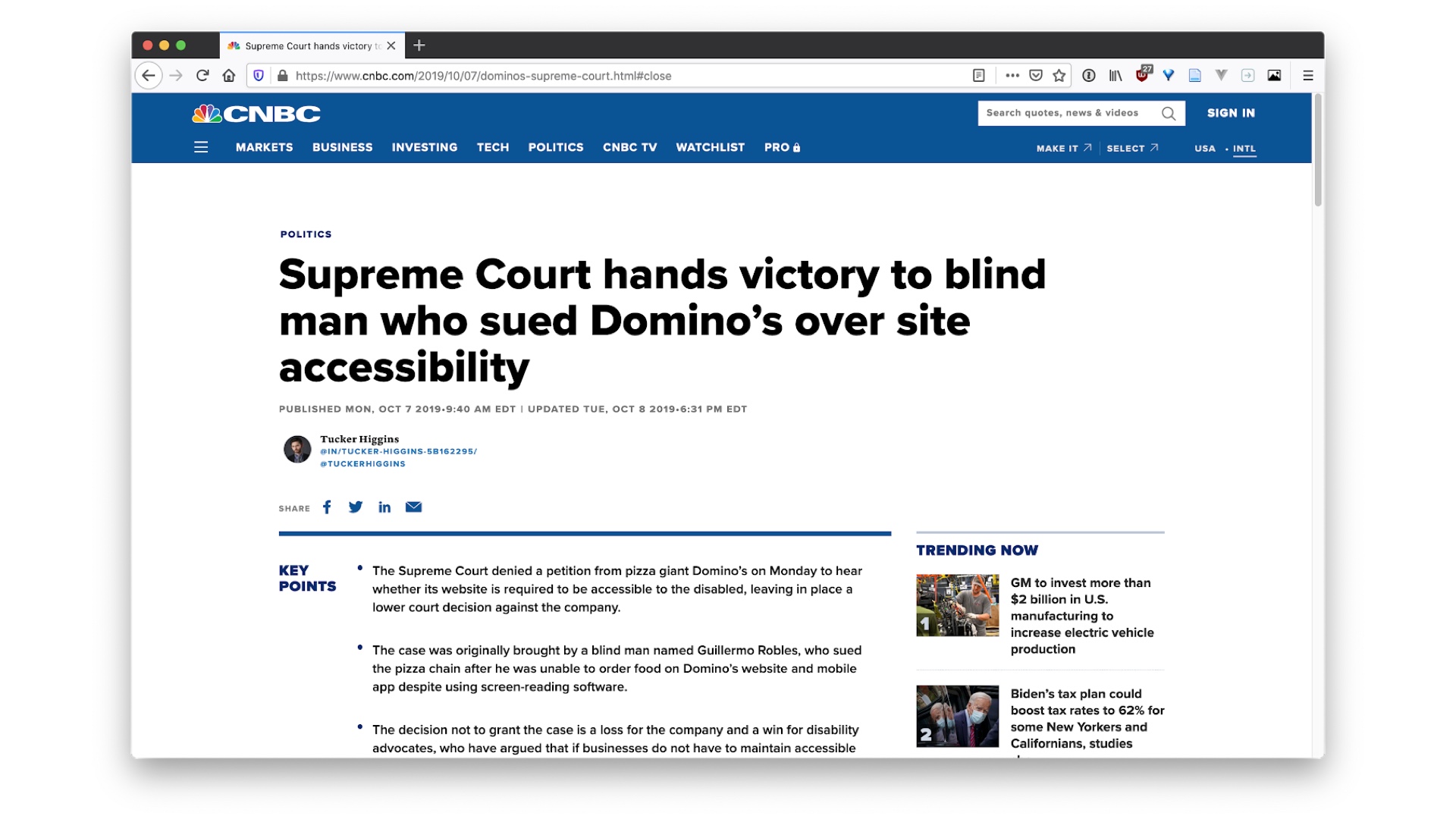
|
And increasingly, this spills over to the private sector too. Yes, there is still a long way to go, but there are levers available that were not there before. Having accessibility guidelines like this made it easier to argue that large companies make accessible products when spending money. For Amazon to win a 30m dollar contract with New York public library a few years back in 2015, they had to make the Kindle measurably more accessible, as an explicit condition of the winning. Dominos sued over site site accessibility: https://www.cnbc.com/2019/10/07/dominos-supreme-court.html Amazon contract tied to accessibility: https://www.edweek.org/teaching-learning/accessibility-concerns-delay-30m-amazon-e-book-contract-in-n-y-c/2015/08 # |
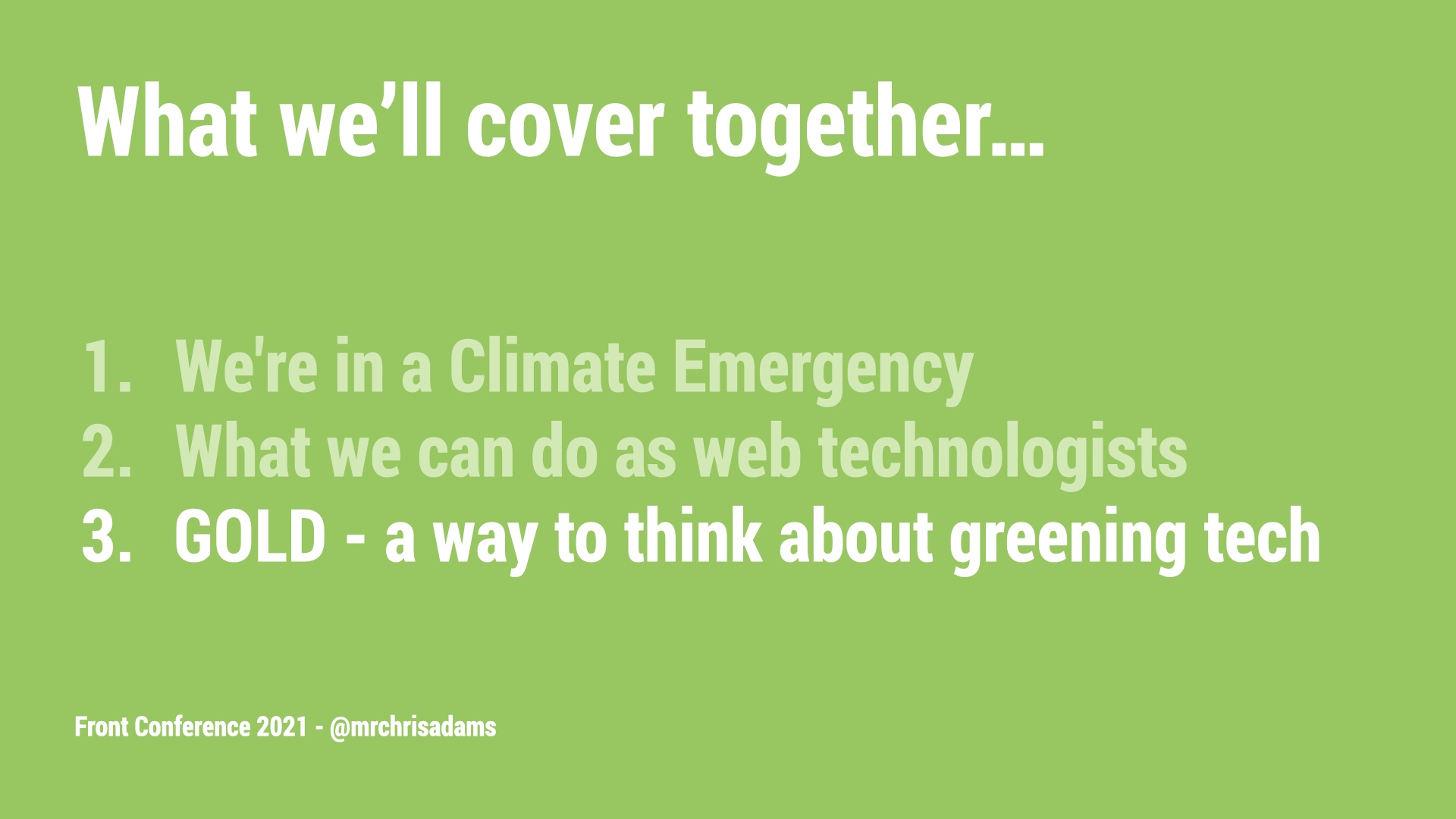
|
I see ideas like POUR as fundamentally about respecting people, and avoiding harm through thoughtless design decisions, and this is the framing I think can work for embedding similar sensibilities around climate into how we work. Inspired by POUR and the WCAG, I want to share a model, because I’m hoping someone will come forward and help me work this over the next 12 months. I think we need GOLD. # |
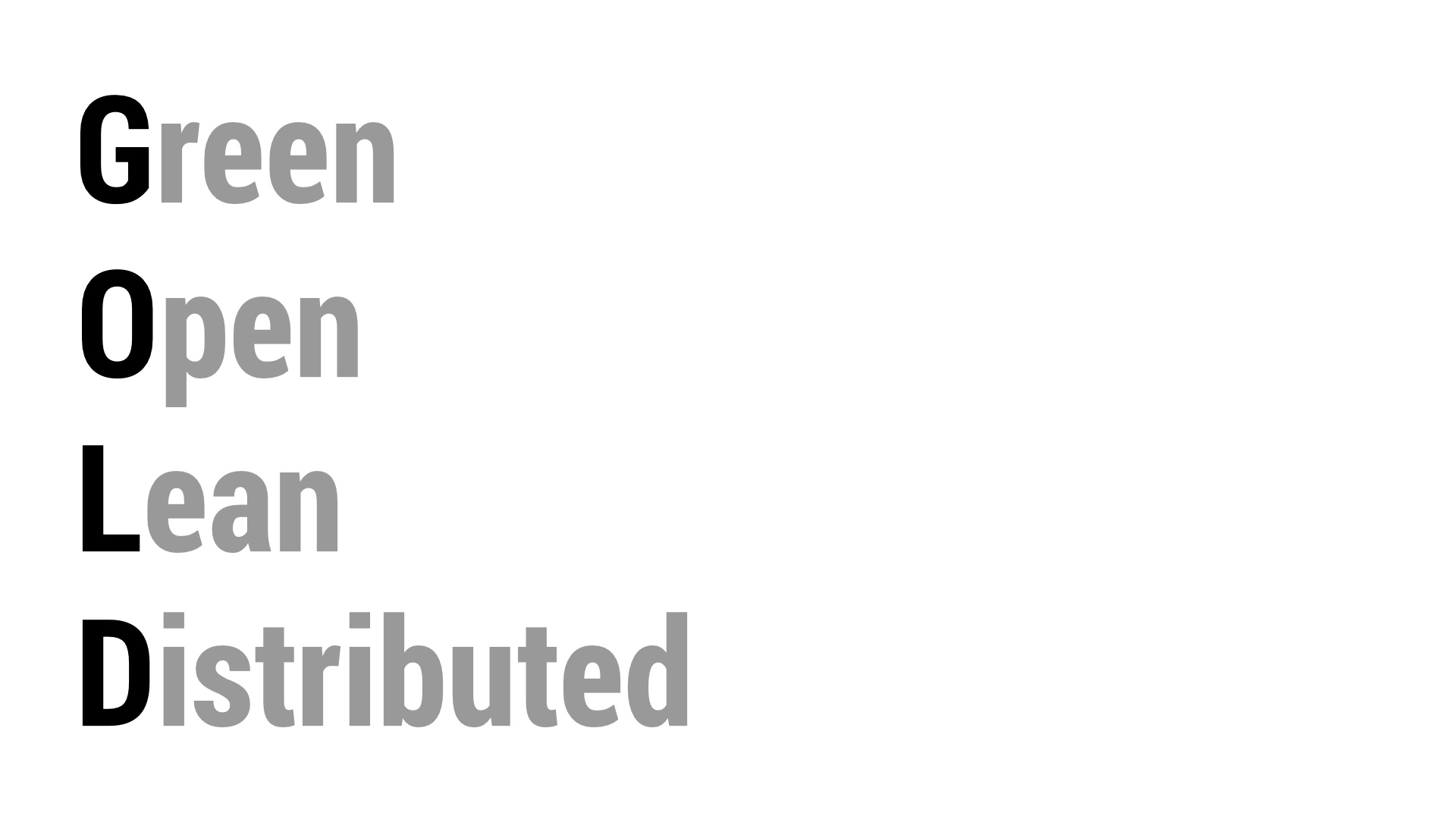
|
GOLD stands for Green Open Lean Distributed Let’s look at these in detail # |
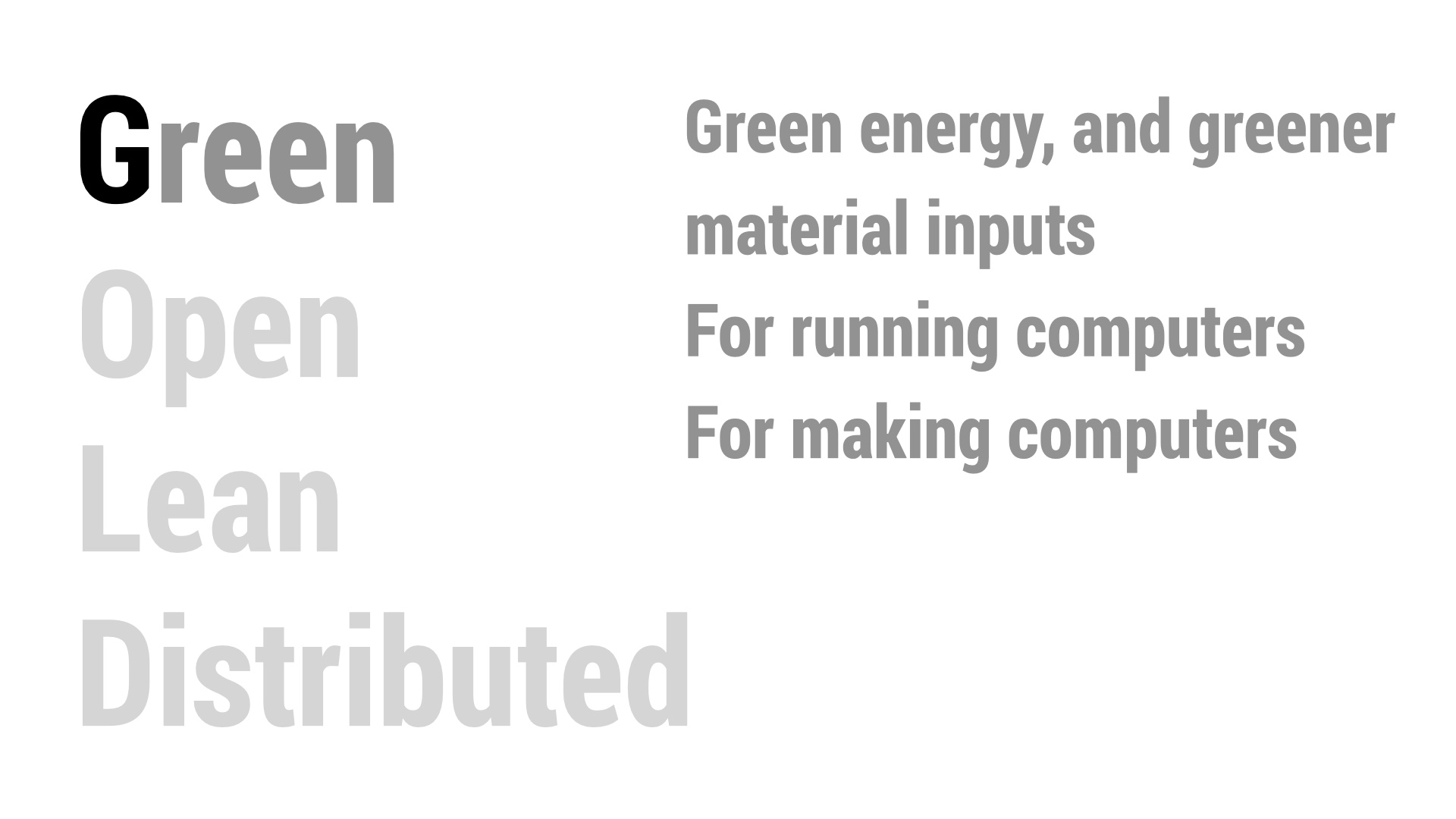
|
Green means green energy and green inputs. As we see, we need energy to run computers, but also for making computers. # |
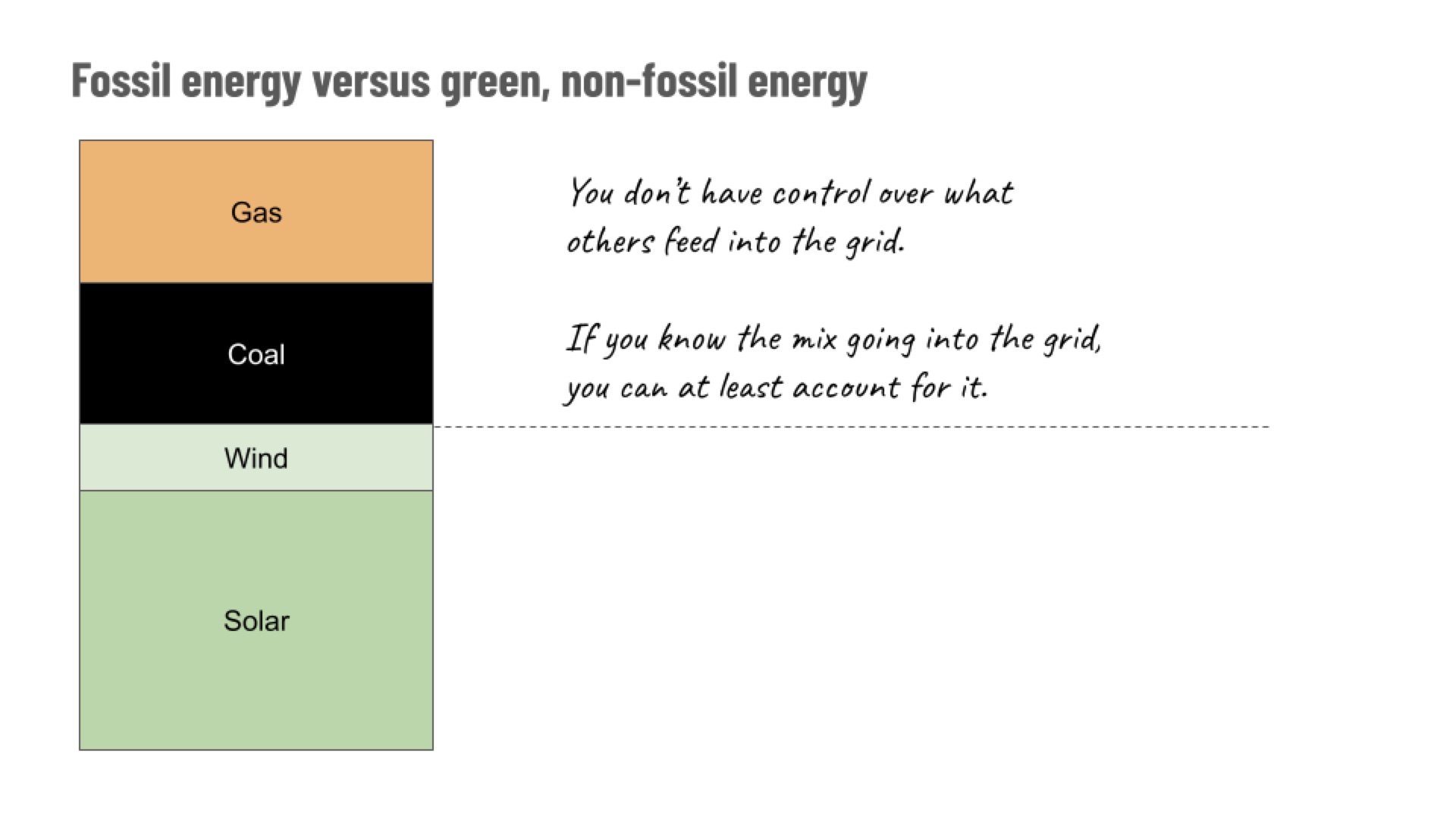
|
Every time we use the internet for example, even if we don’t mean to, we’re burning fossil fuels, because the internet if the biggest machine in the world and it largely runs on coal still. We really need to stop this - in 2021 we don’t need to build the web with fossil fuels, any more than we need to build houses with toxic material like asbestos. # |
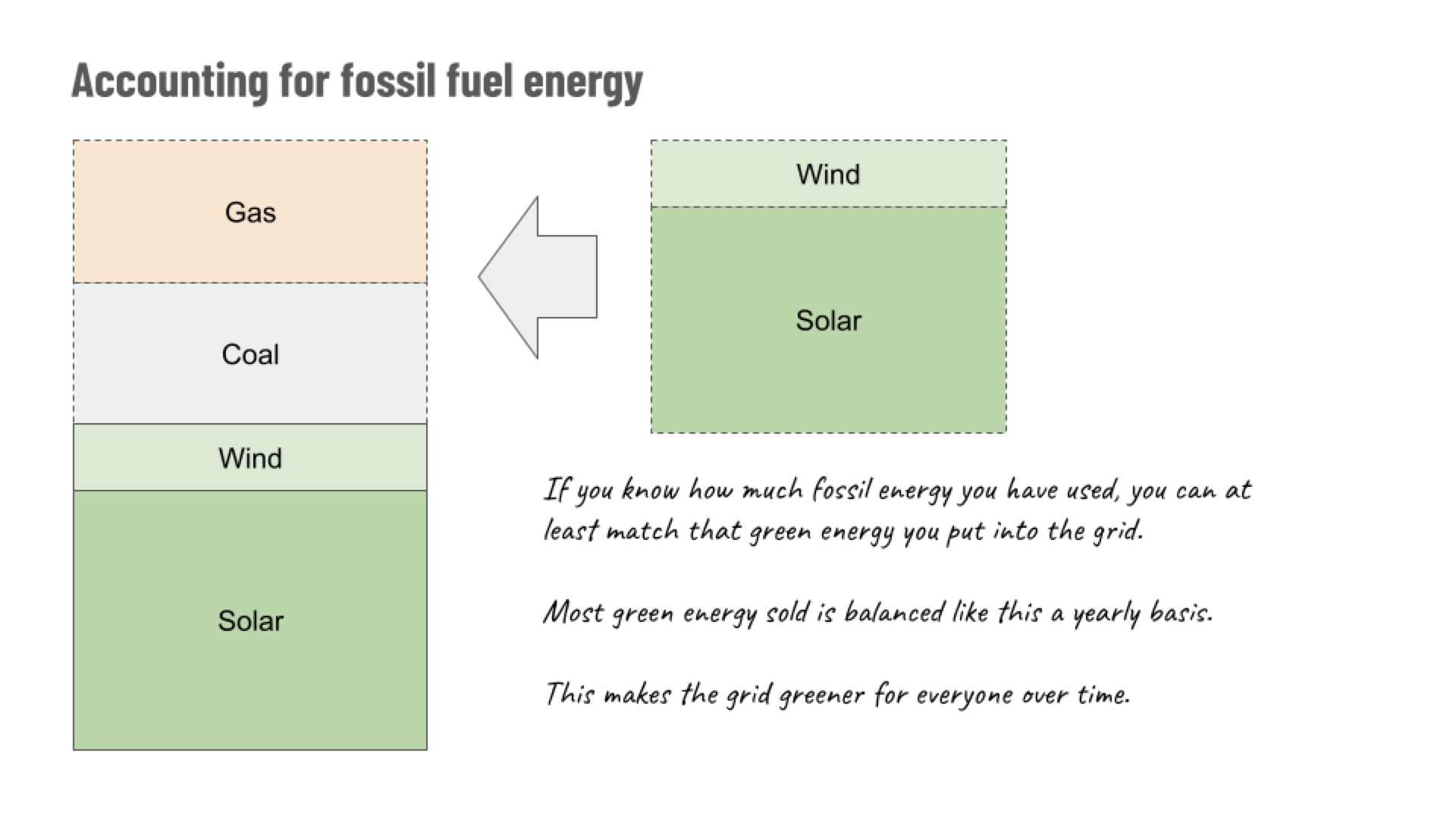
|
When we use websites or digital infrastructure using green energy, it doesn’t mean a website is always running on green power 24/7. What it currently means is that at least as much money is going into the grid as was used by the grid over a give time period - usually a year. Over time, this makes the entire energy grid greener for everyone. # |
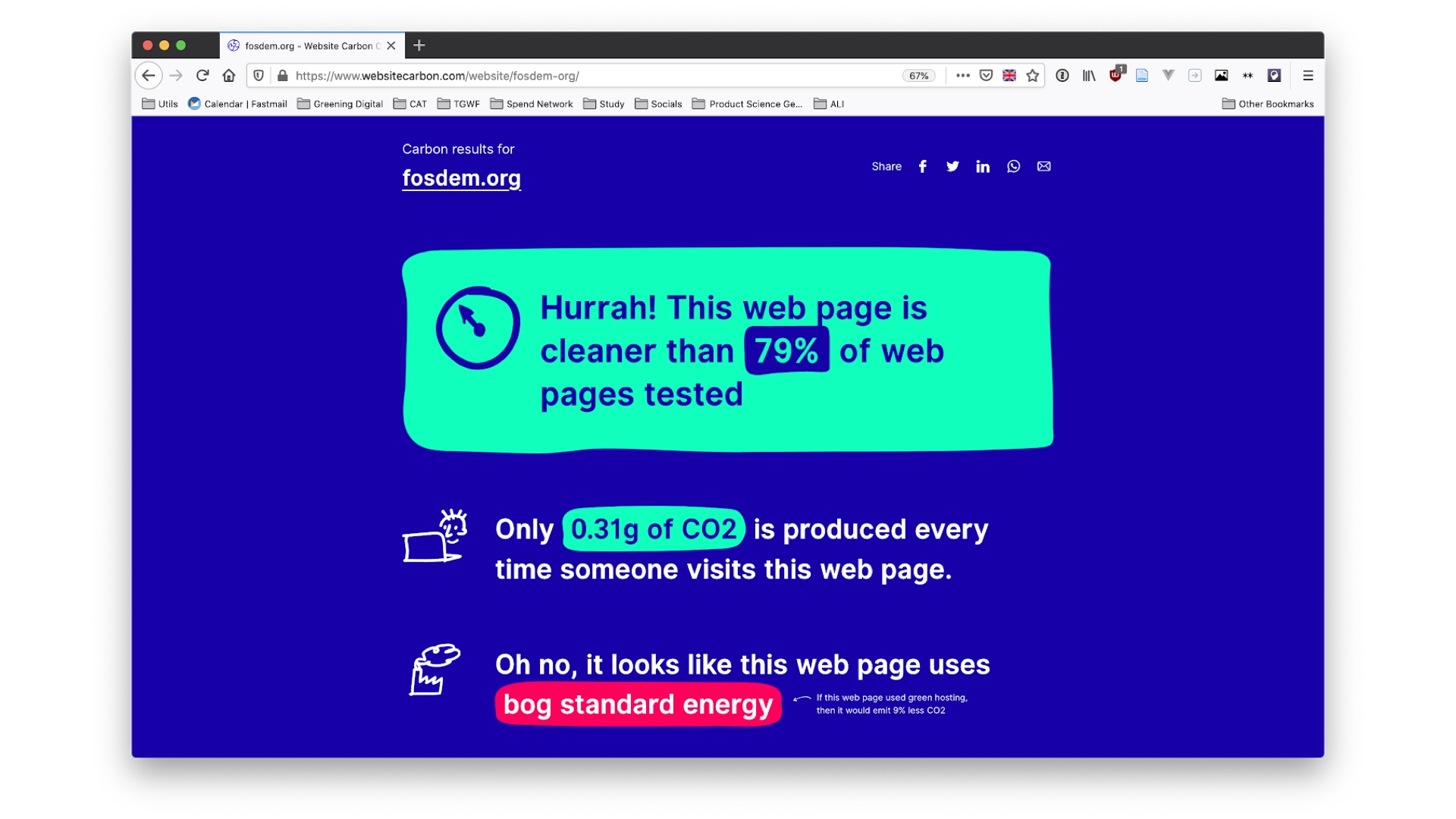
|
My NGO, the green web foundation provides free datasets listing which websites run on green energy, and we also expose this information over an API. This is what makes it possible for website carbon to see if you’re using bog standard energy, or green energy when they check your site for example. Website Carbon: https://www.websitecarbon.com/ The green web foundation API: https://www.thegreenwebfoundation.org/green-web-feed/ # |
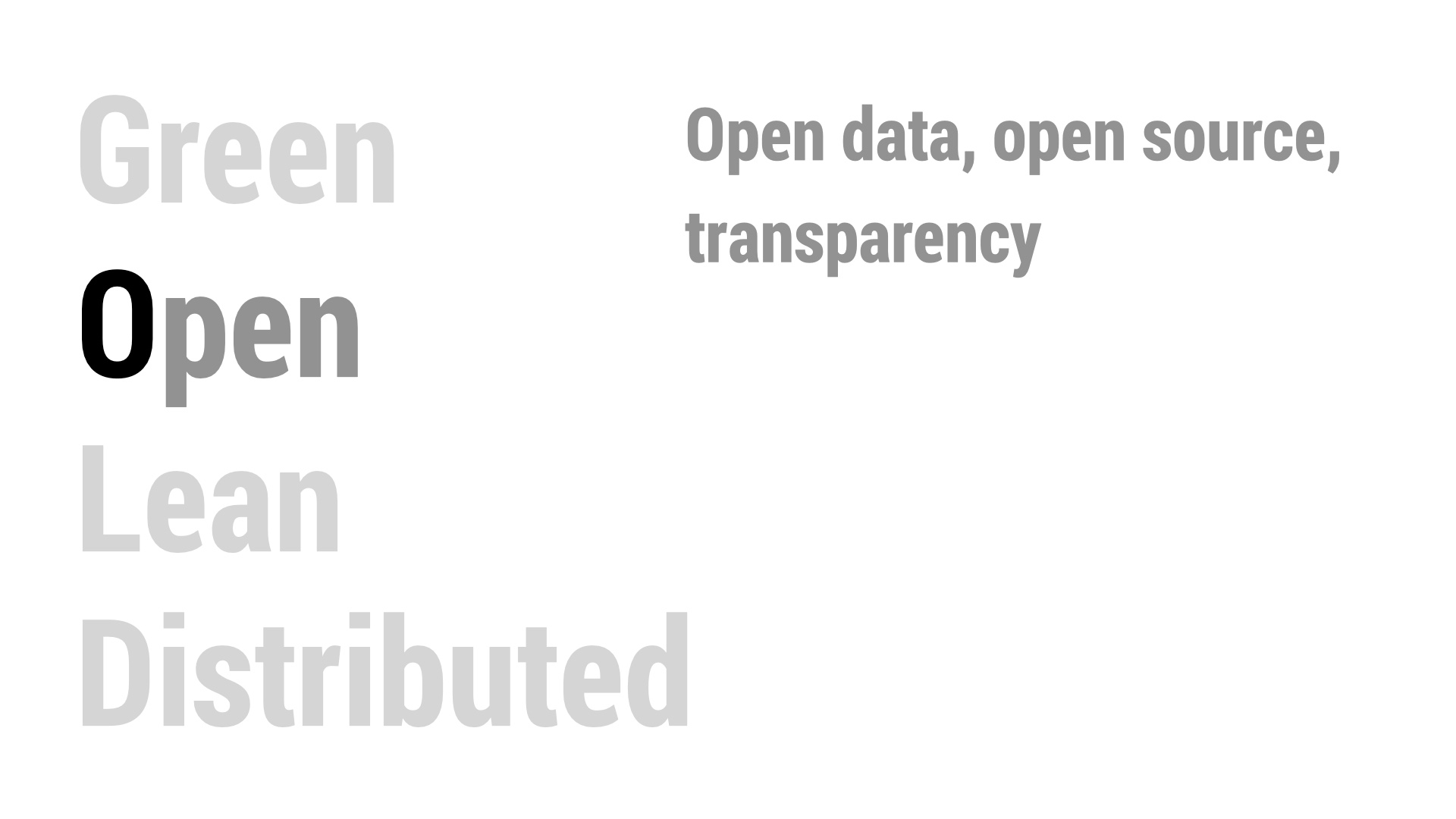
|
Open here is about an approach, as opposed to being about just open source # |
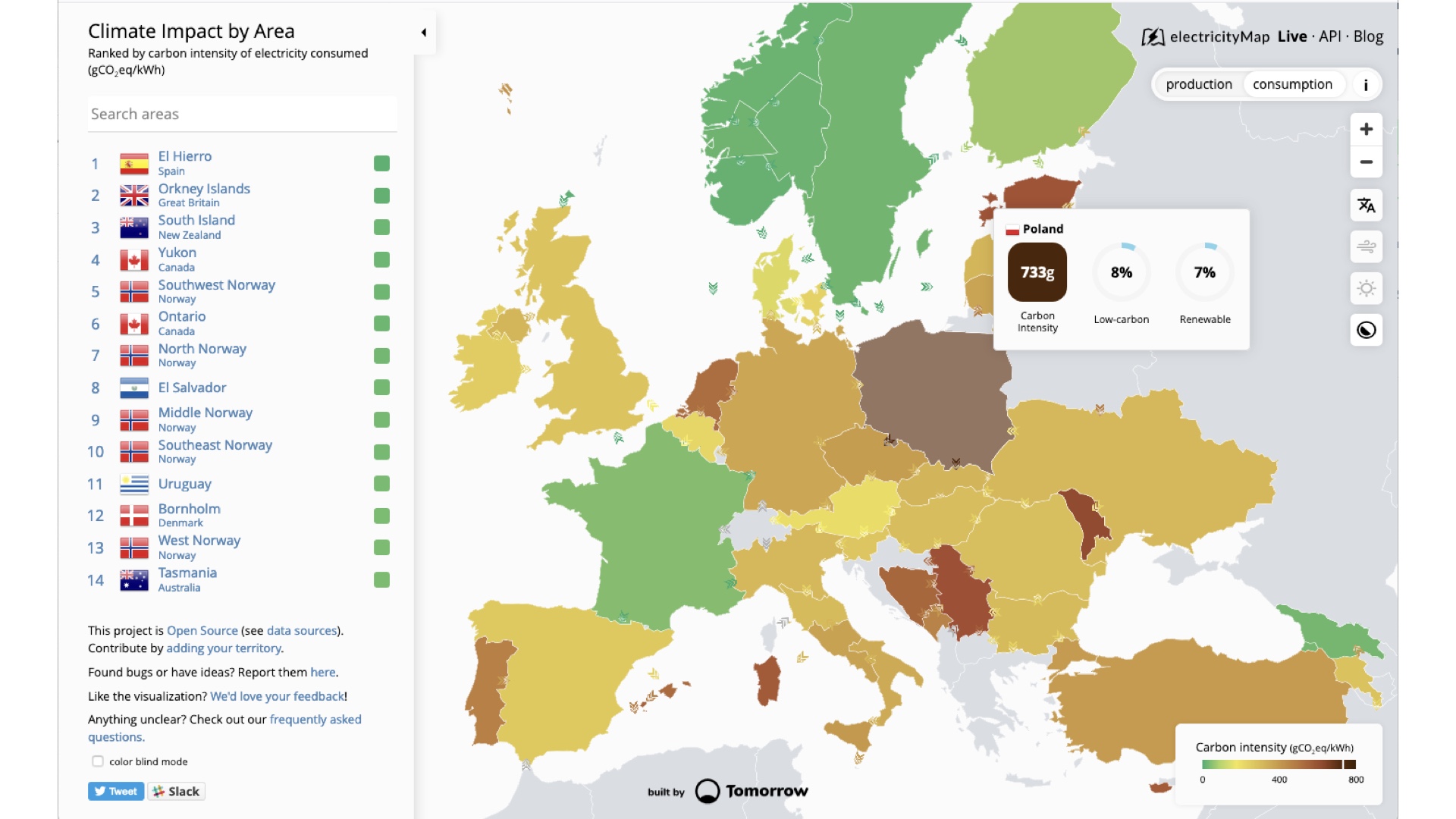
|
If you want to figure out what the greenest country is to run servers, you can look at electricity map, an open source project, to see. They show in real-time how green each grid is and they make this information available over an API. Google use this info to work out where to dispatch massive complicated computing jobs now for the lowest carbon footprint, and so can you. Electricity map: https://www.electricitymap.org/ # |
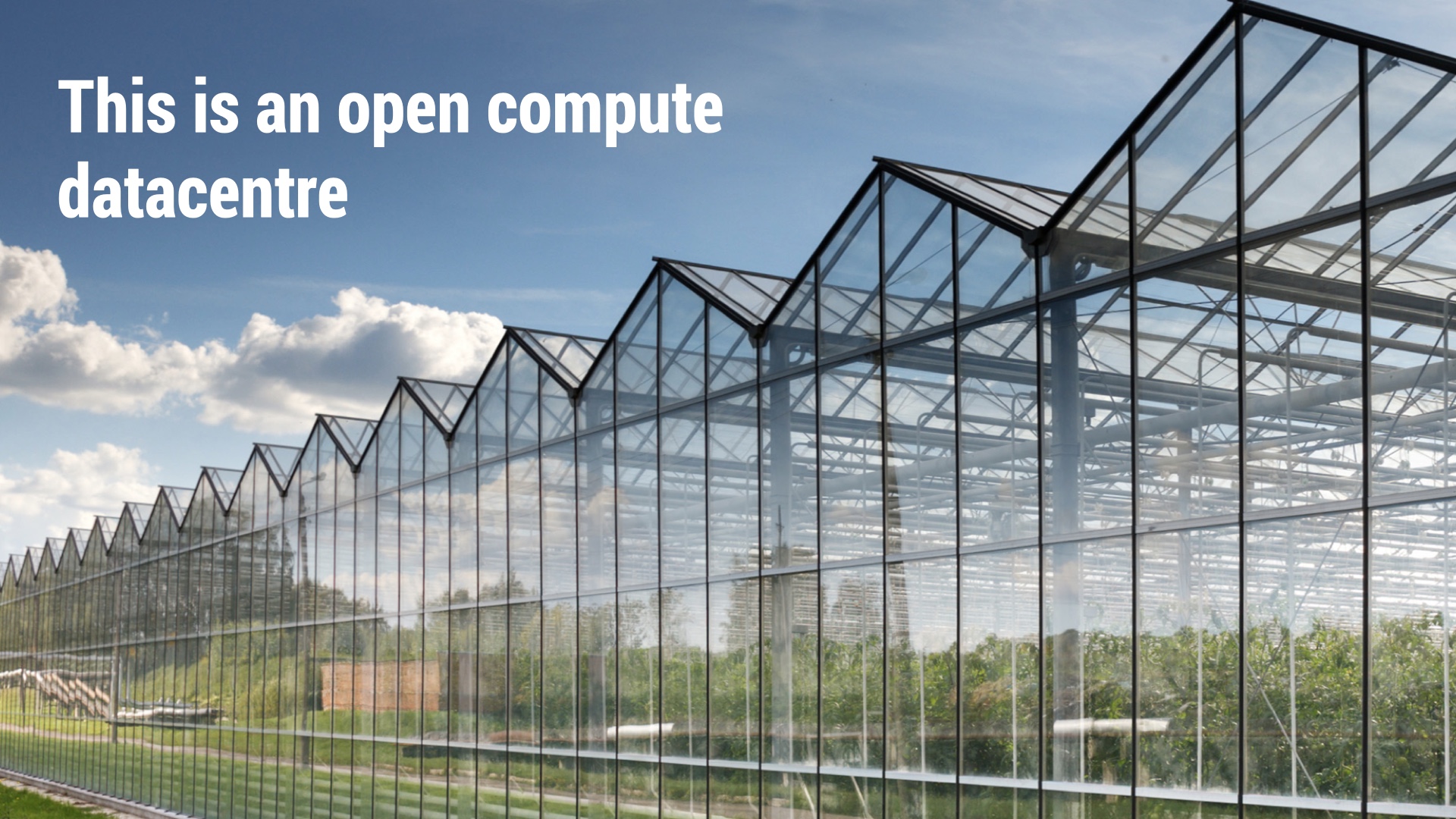
|
Open allows for new ways of thinking about digital infrastructure too. What you’re looking at here is the heat exchanging part of a new datacentre in the Netherlands, using open compute servers. The open compute project is an initiative by a number of big companies like Facebook and Microsoft to build open source server components, for a more efficient industry. But because they’re open, there are some cool ideas by start-ups in this field as well now. Open Compute: https://www.opencompute.org/wiki/Server/ODSA # |
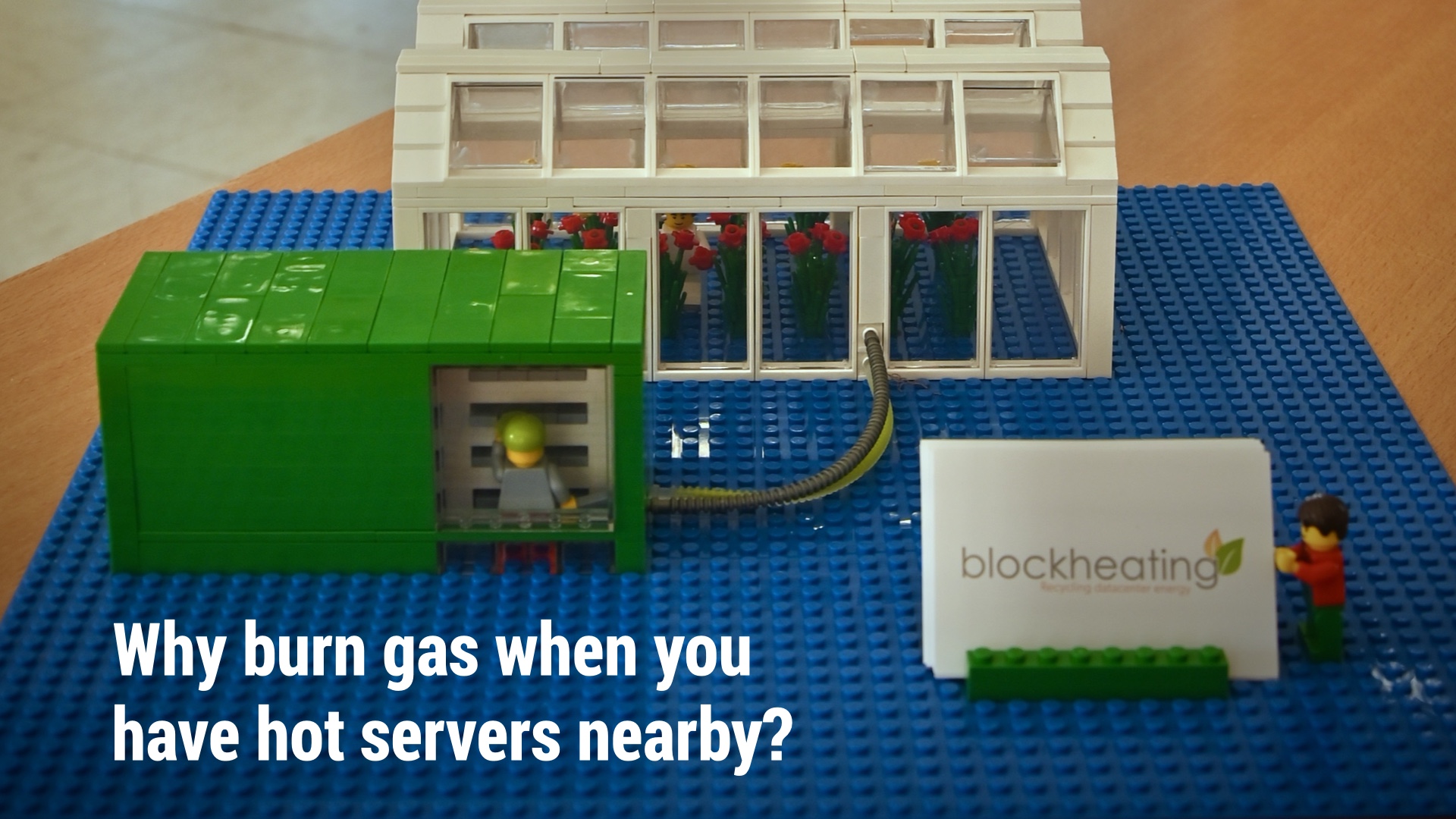
|
Block heating is one such company. Rather than having massive out of town datacentres where all the excess heat from running computers is wasted, and where loads of energy is spent trying to move the heat out and vent it into the sky, they do something different. Instead, they use end-of-life, recycled servers from the same big tech companies, put them in shipping containers, and then connect these shipping containers to green houses that grow crops like tomatoes and cucumbers. To get green houses hot enough for tomatoes to grow well, gardeners typically burn fossil fuels to heat them. This lets them use the heat from the computers instead. This is cool - it uses the waste heat from the servers productively, turning what was a problem, into something valuable for someone else. Also, using recycled servers saves them from landfill - and extends the useful life of hardware. Blockheating: https://www.blockheating.com/ # |
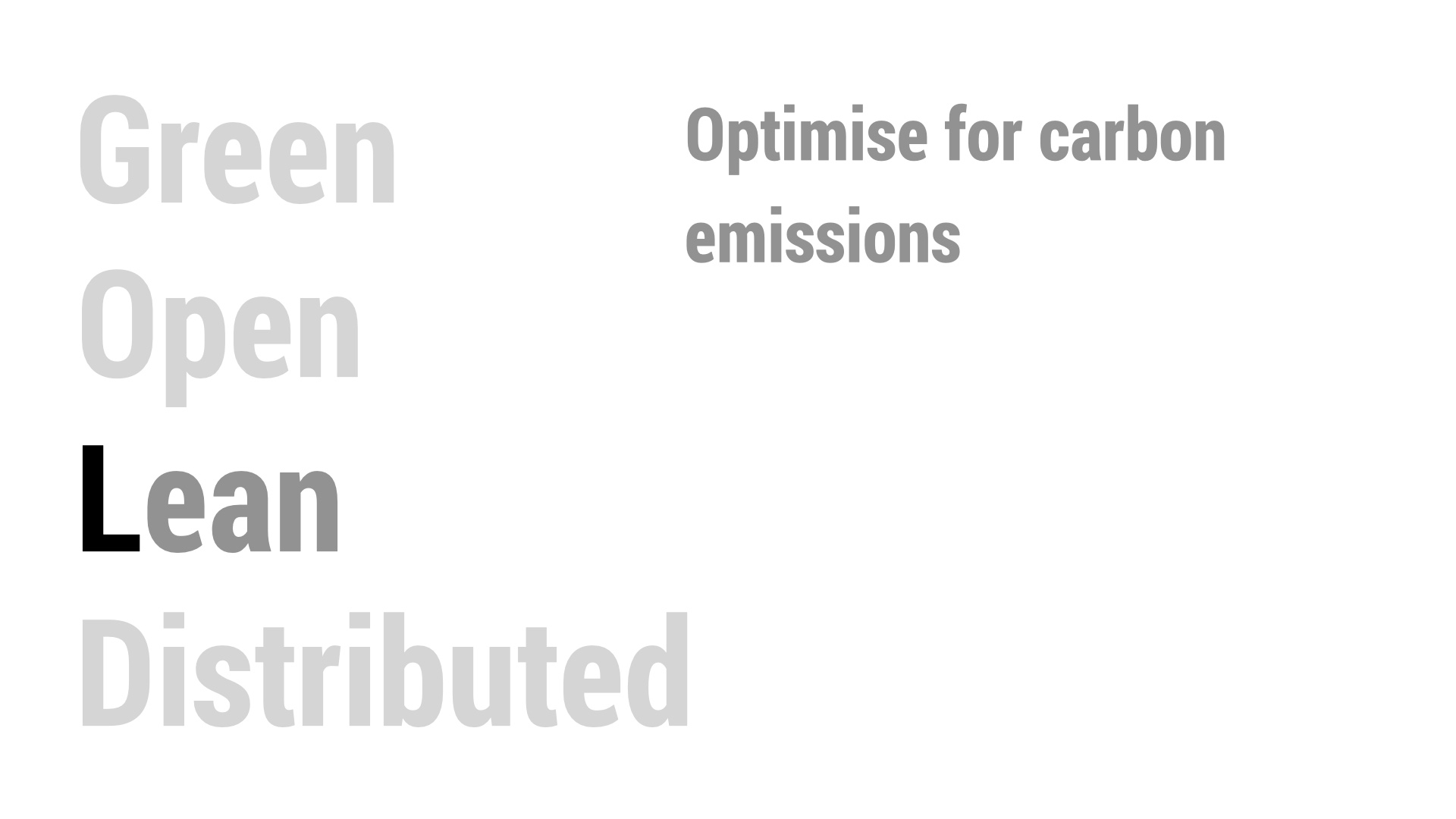
|
Lean is a recognition that all energy has a cost in terms for climate pollution, so efficiency is important. # |
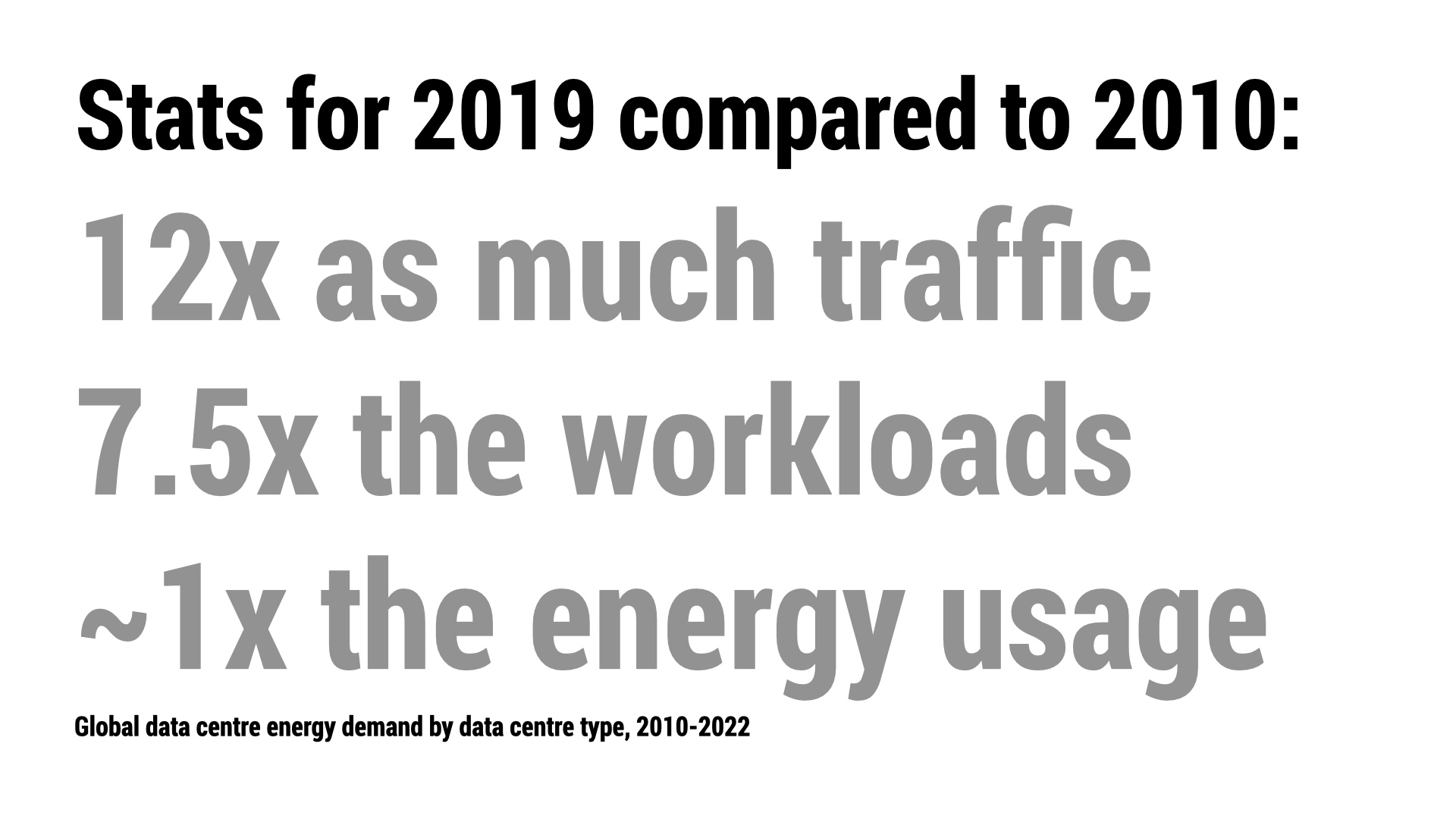
|
This is somewhere where we’ve seen some success already. Over the last ten years, if we look at the energy usage for what we might refer as the engines of the tech sector, the millions of servers in datacenter globally - you’ll see that it has as largely stayed the same, despite explosion in in use. Datacentre power usage: https://www.iea.org/data-and-statistics/charts/global-data-centre-energy-demand-by-data-centre-type-2010-2022 # |
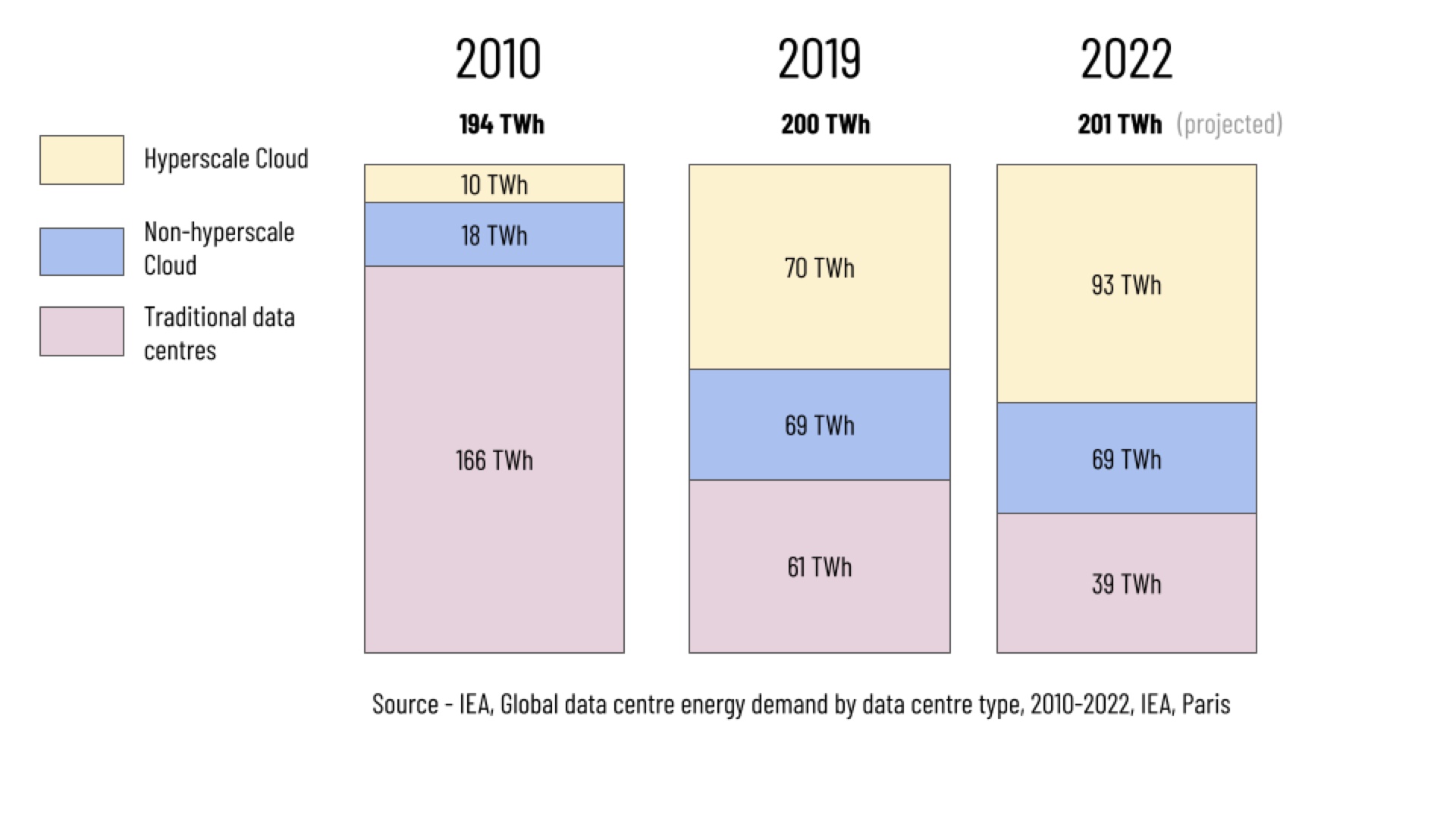
|
This is largely because we’ve been moving away from a large number of traditional datacentres, and towards smaller numbers of much more efficient, hyper scale style datacentres. These days, you can make the claim that the carbon footprint of the tech sector is roughly comparable to the entire shipping sector, or if you prefer, countries like Germany or Canada. Centralising the web like this has its own issues obviously, but from a climate point of view, having less climate pollution per unit of compute is largely a win. # |
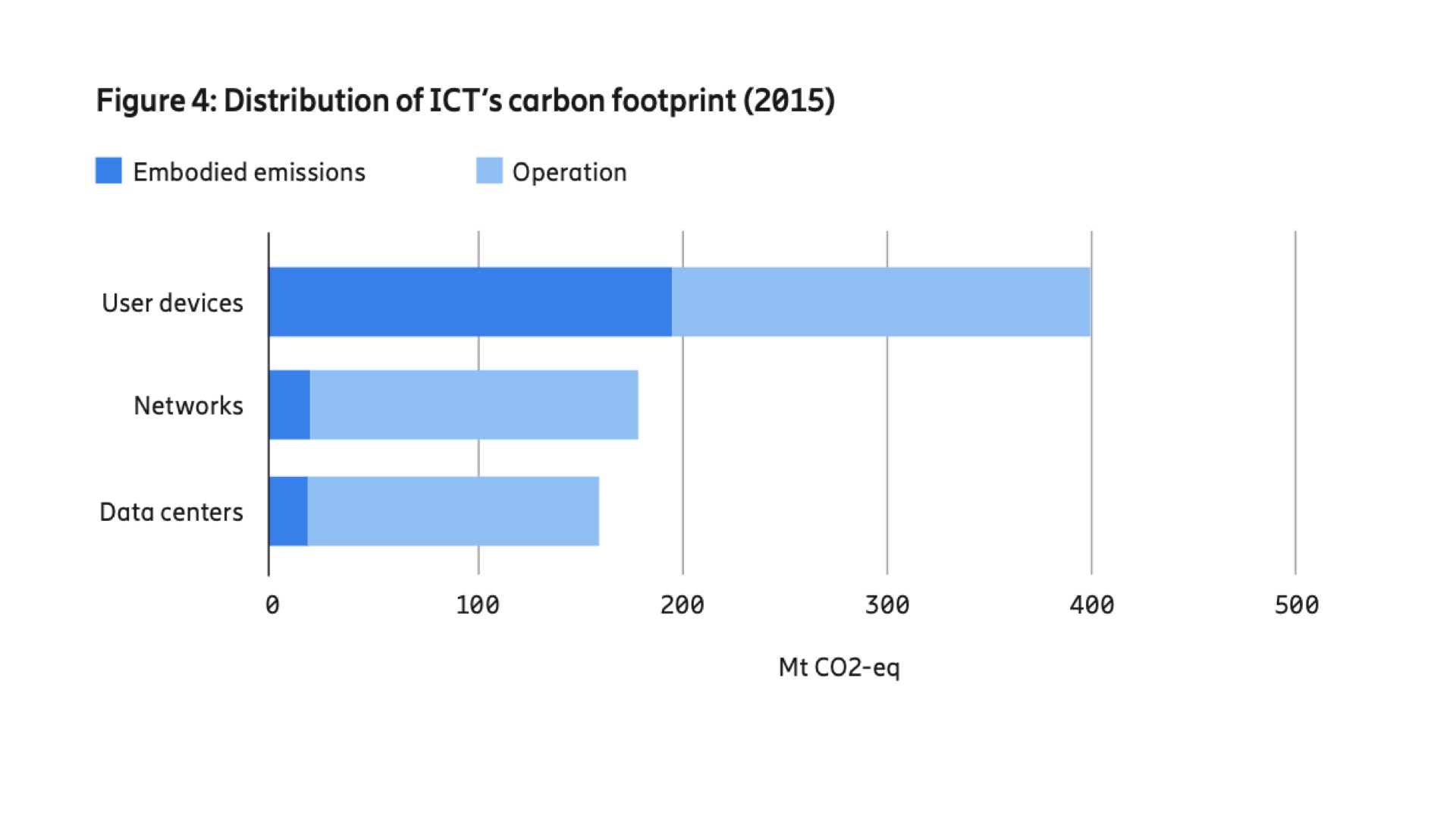
|
However, as we mentioned before it’s not just running computers that causes carbon emissions. Making computers involves turning sand into computer chips - a very energy intensive process, and we should be aware of these embodied emissions that come from making them. This chart here shows that because servers are running 24/7, their running costs make up a larger share of their footprint. But for user devices, it’s the other way around. Because making every new computer is so energy intensive, we care more about needing to make fewer computers, and make them live longer as a way to avoid climate pollution. ICT carbon footprint report from Nokia: https://www.ericsson.com/en/reports-and-papers/industrylab/reports/a-quick-guide-to-your-digital-carbon-footprint # |

|
This is why I’m quite excited about a new wave of laptops which are being designed from the outset of be repairable, like the framework laptop pictured here. It’s basically the fairphone of laptops - with an open design, and emphasis on user repair. Making a laptop last a couple of years longer can reduce the carbon footprint over it’s lifetime by around 25%, so this is a positive step. Framework: https://frame.work/laptop-diy-edition # |
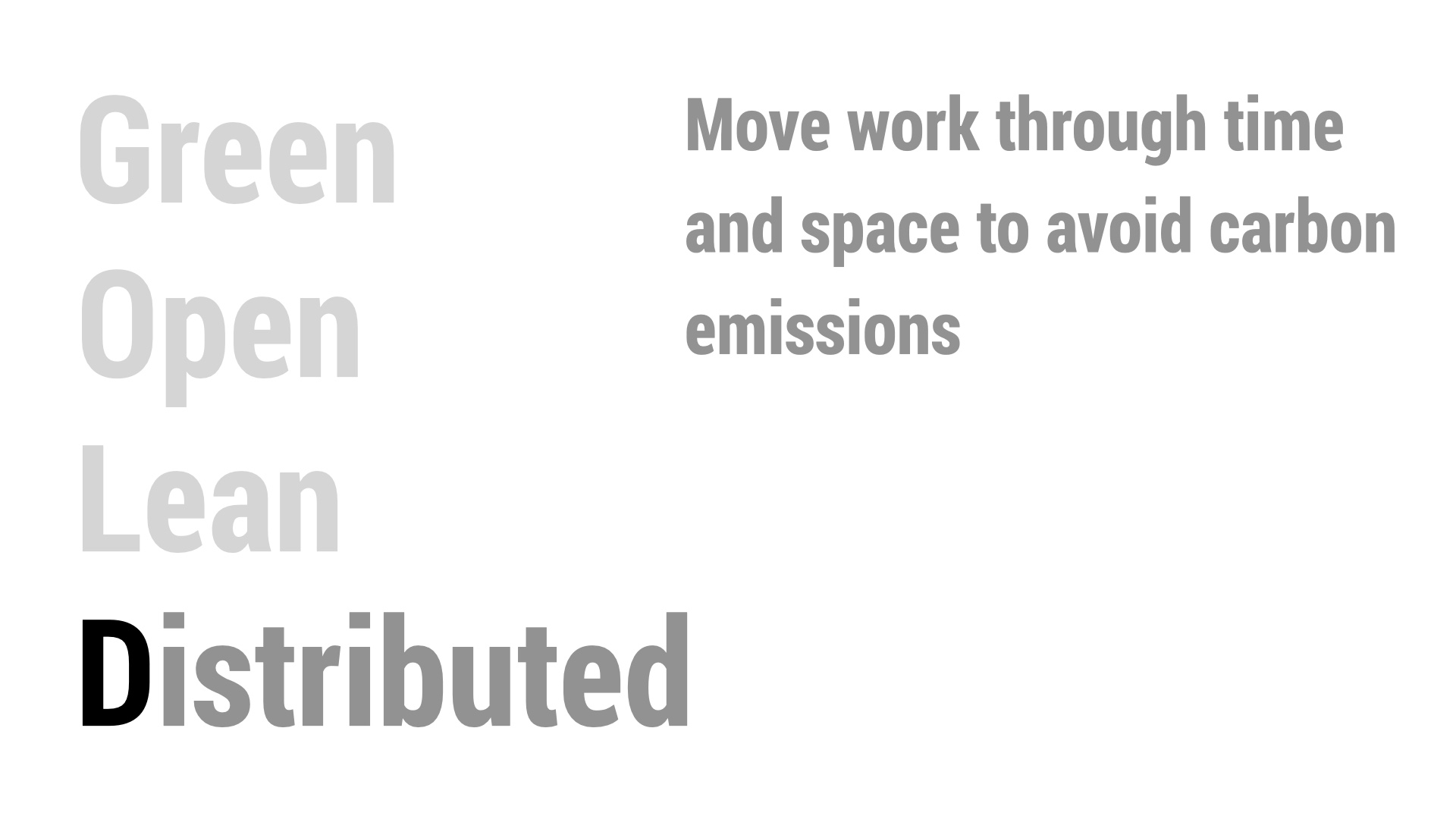
|
Finally, D stands for distributed. We can use the internet to move work through time and space to use avoid pollution. Let’s see how. # |
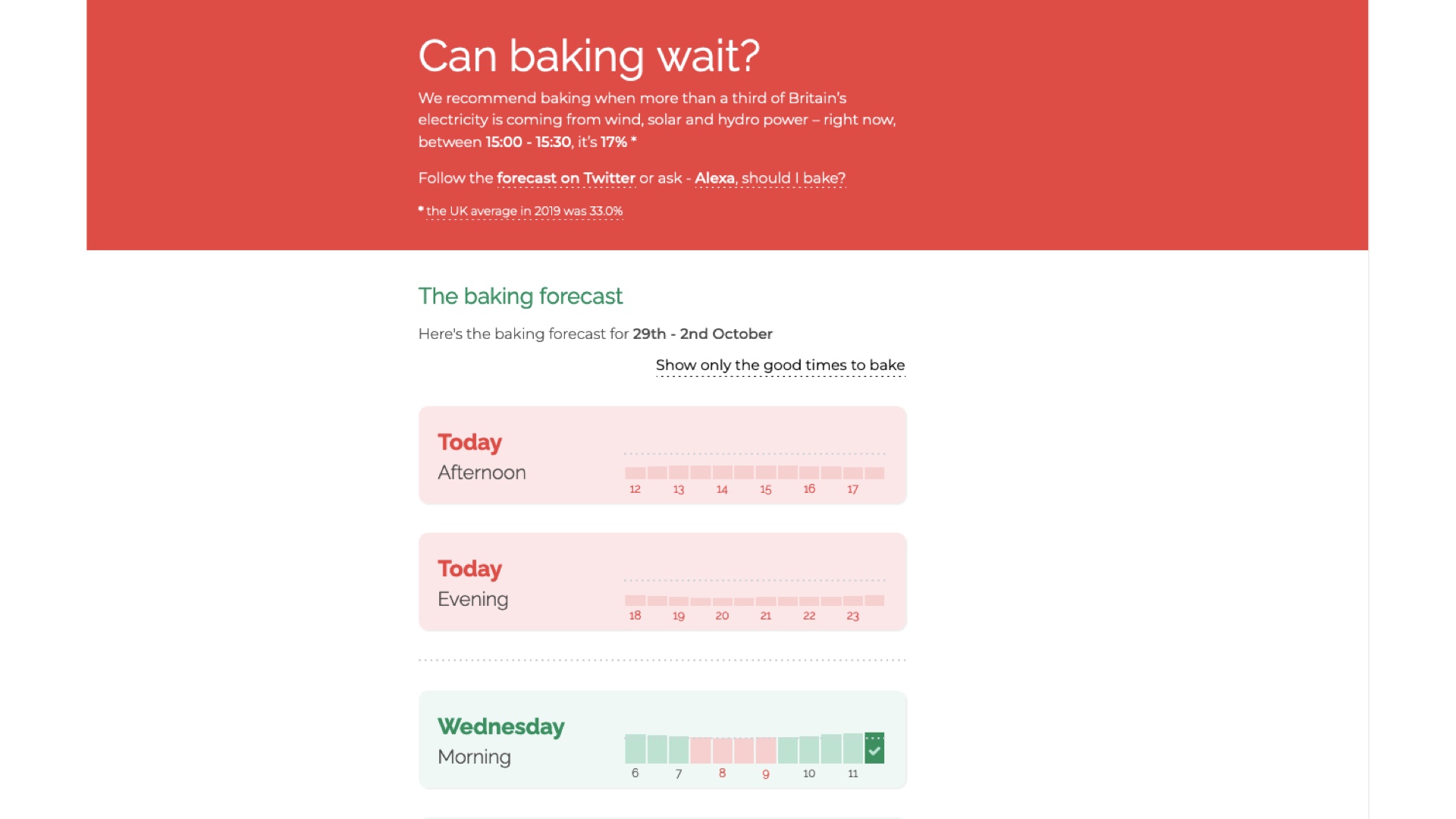
|
If you’re in the UK, you might have heard of the baking forecast. It’s a cool project that looks at how energy on the grid is being generated, and because baking uses loads of electricity, shows you how to bake greener. For example, it tells you when it’s a green time to bake, when loads of wind and solar is powering the grid, or when it’s not a good time to bake, when most of the power comes from fossil fuels. You can get a forecast to plan for the greenest delicious baked goods. Baking Forecast: https://twitter.com/baking4cast/ # |
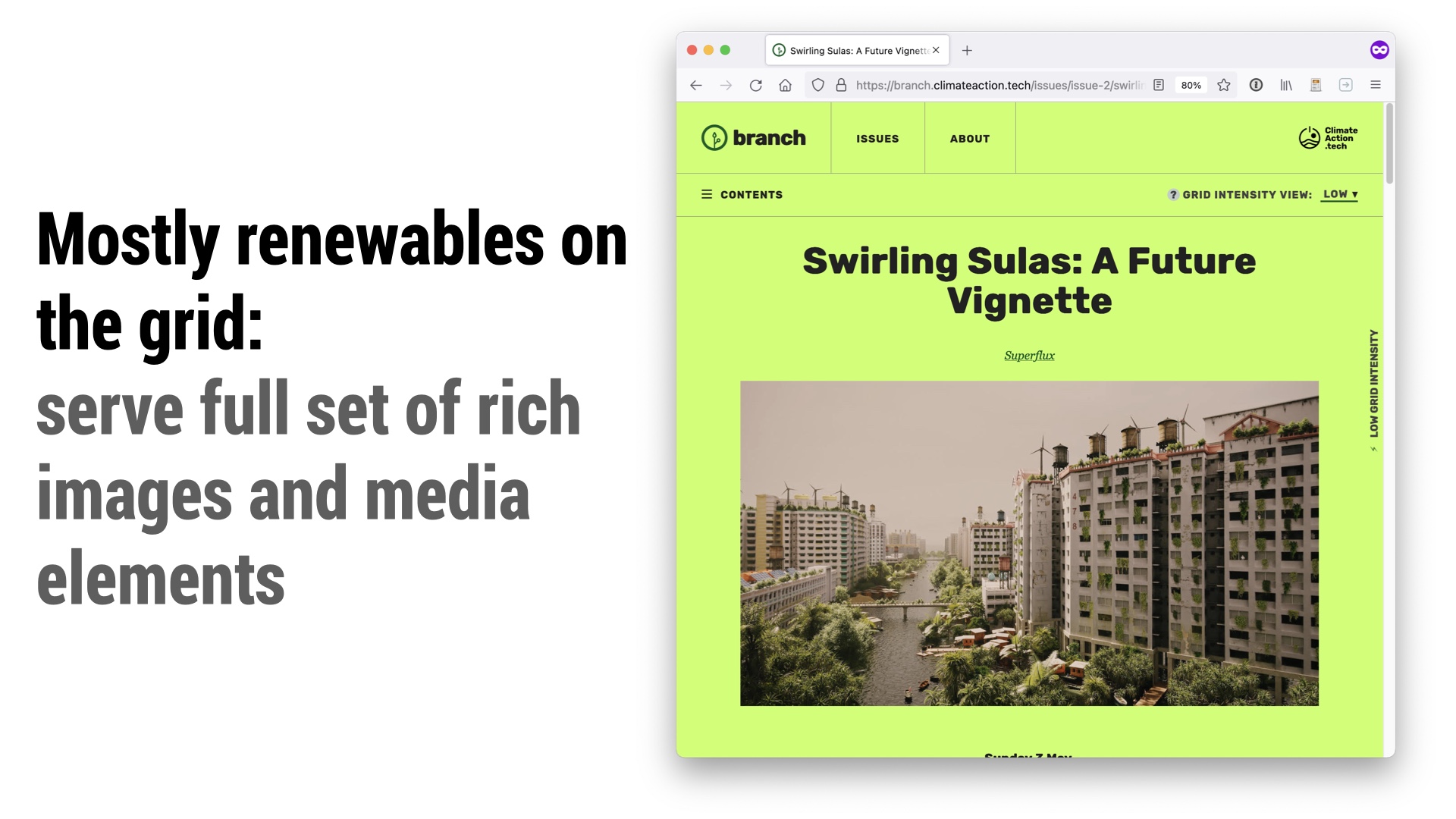
|
I’m one of the editors of branch magazine, and we do a similar thing with the web itself. When we know the grid powering our servers is green, and we think it’ll be a green time to serve webpages, we send our our full-fat, rich web experience down the pipe to our users. Branch: https://twitter.com/baking4cast/ # |
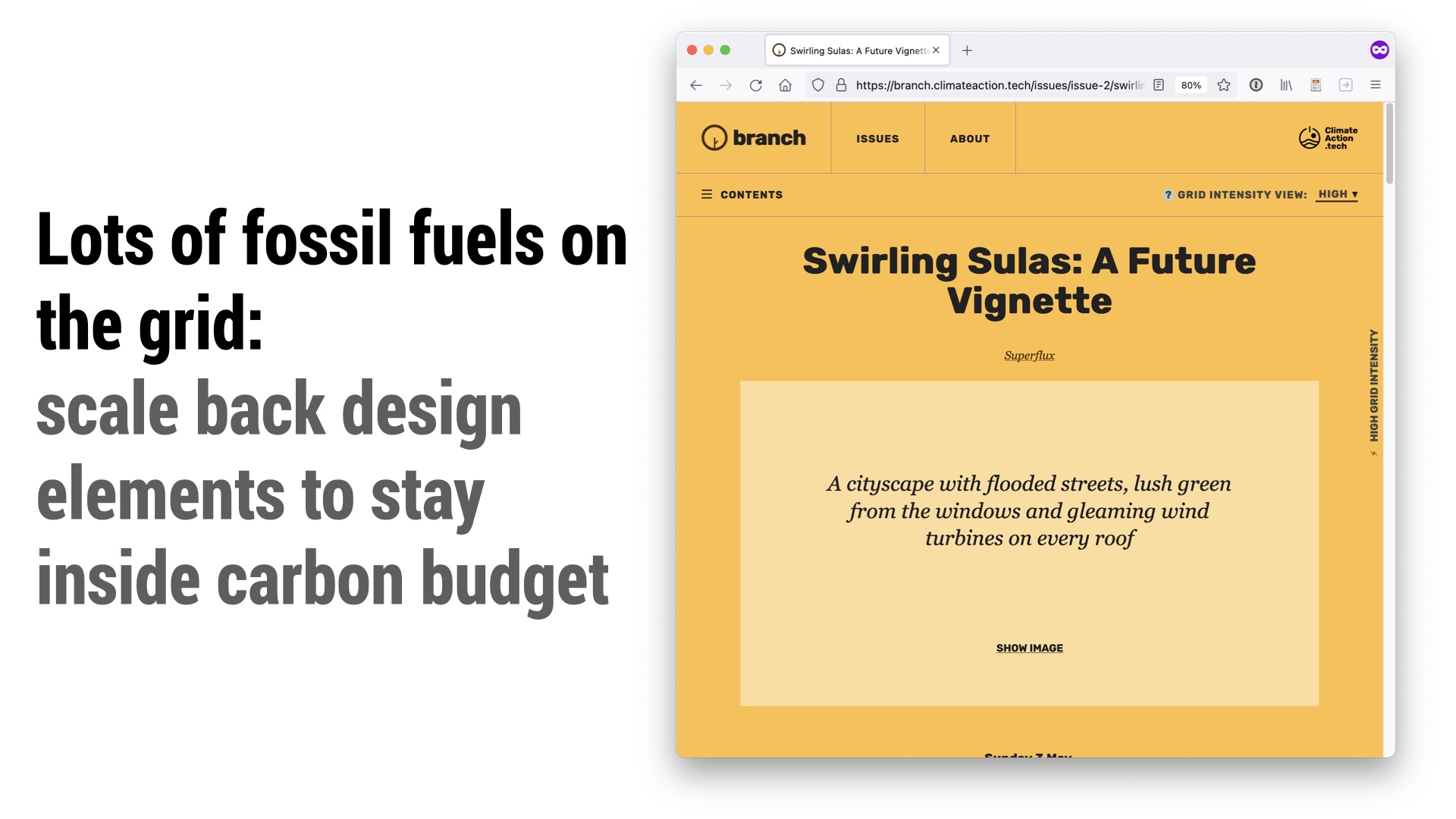
|
However, when we know there are lots of fossil fuels on the grid, we know doing that will result in higher carbon emissions from doing so. So, in addition to having a page weight budget to stay inside, we have a carbon budget for our pages too. We adapt the design to fall back to the lighter weight, images-free version. You can still access the same content, but we don’t default to showing it now. This also forces us to think about the alt text from the get go, which is good for accessibility anyway. In the next issue we want to experiment with web workers to pull down content when we know energy is cheap and green - this is an example of shifting work through time when working on the web. # |
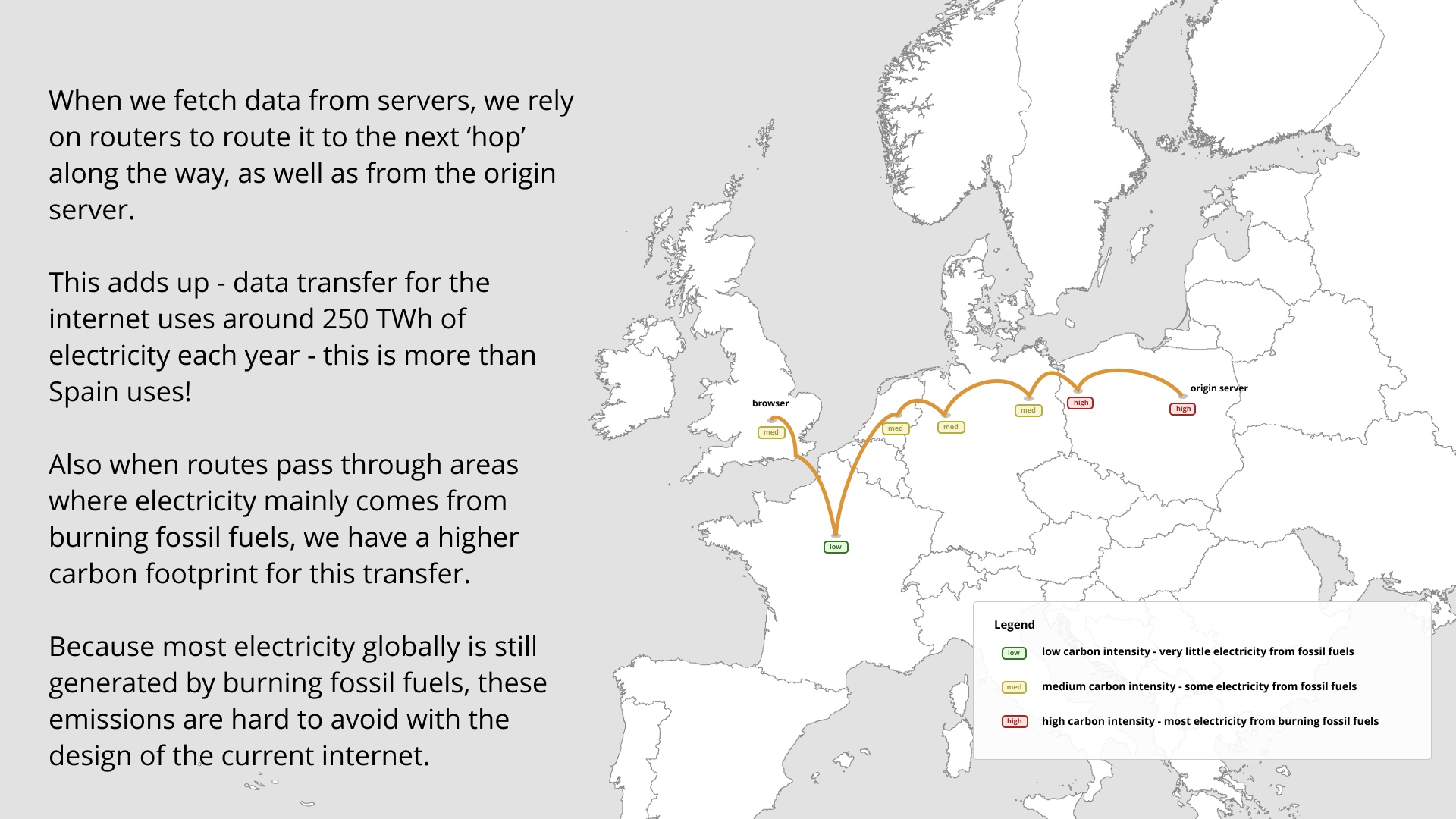
|
The example we just saw was showing how we can also move work through time. We also saw earlier with electricity map that we can move server workloads where they are greener - that’s a good example of moving work through space to another part of the world where energy is green. But you can move work through space AND time too with open source, next generation networking architecture like SCION. Let’s imagine we’re in London, connecting to a website in Poland. We have to hop across countries to make this connection. And every hop has a carbon footprint determined by how clean the grid is. France is full of nukes so it’s relatively green, low carbon electricity, but Poland has lots of coal and broadly speaking is less green. Germany and England about in the middle, depending on the time of day. # |
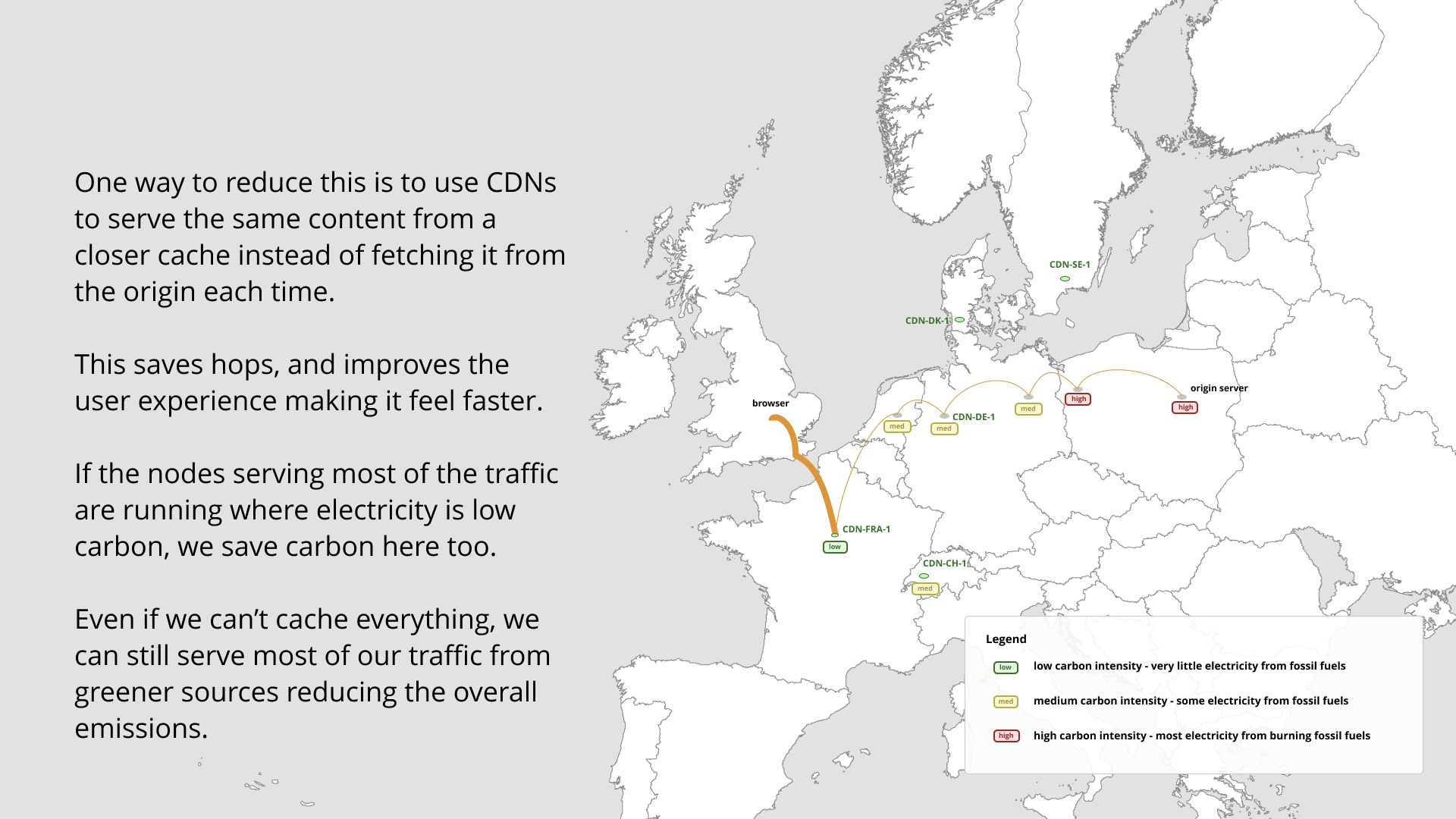
|
One thing we can do, if we have a CDN, is serve traffic where it is closer, and ideally greener. Let’s imagine we have a CDN node in France instead of relying just on our server in Poland. Doing this lets us serve more traffic from a green grid as opposed do a dirty one, and from servers optimised for the task. We might not be able to serve everything from France, but we can serve at least some of it, which means we only rely on going through the less green routes for a smaller amount of traffic. # |
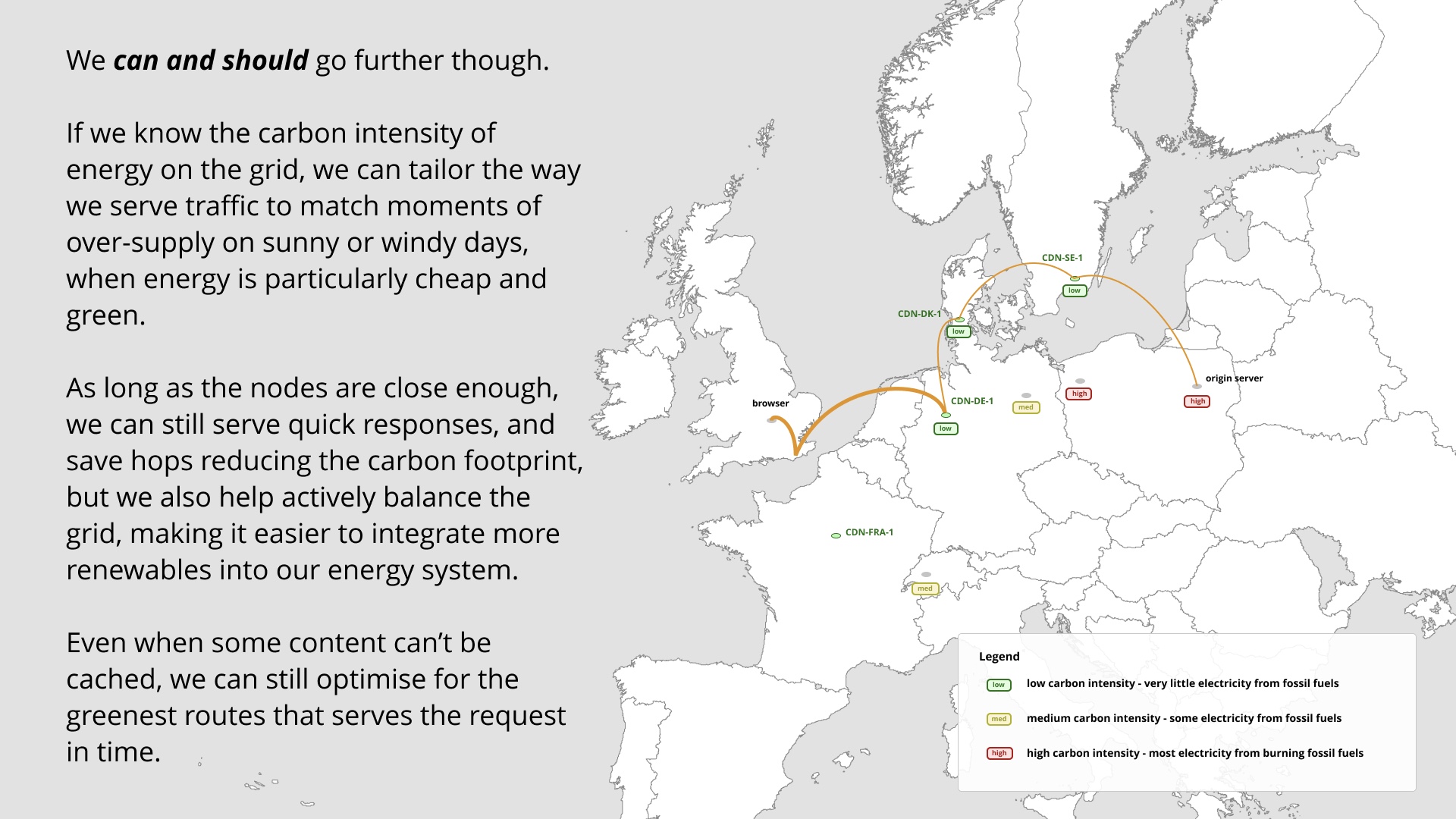
|
However, if we build an awareness of how green the grid is into the internet itself, then it’s possible to make routing decisions based on this information. Let’s assume that in the North of Europe, it’s particularly windy that day. We can design for that, and route accordingly, resulting in a greener routing - like doing some low-carbon network trick shot. This is not sci-fi, this is being worked on right now. SCION is an open source internet architecture, running in production around the world, that can support this kind of behaviour. It’s designed and developed in Switzerland, entirely open source and I’m super excited about it. SCION: https://www.scion-architecture.net/ # |
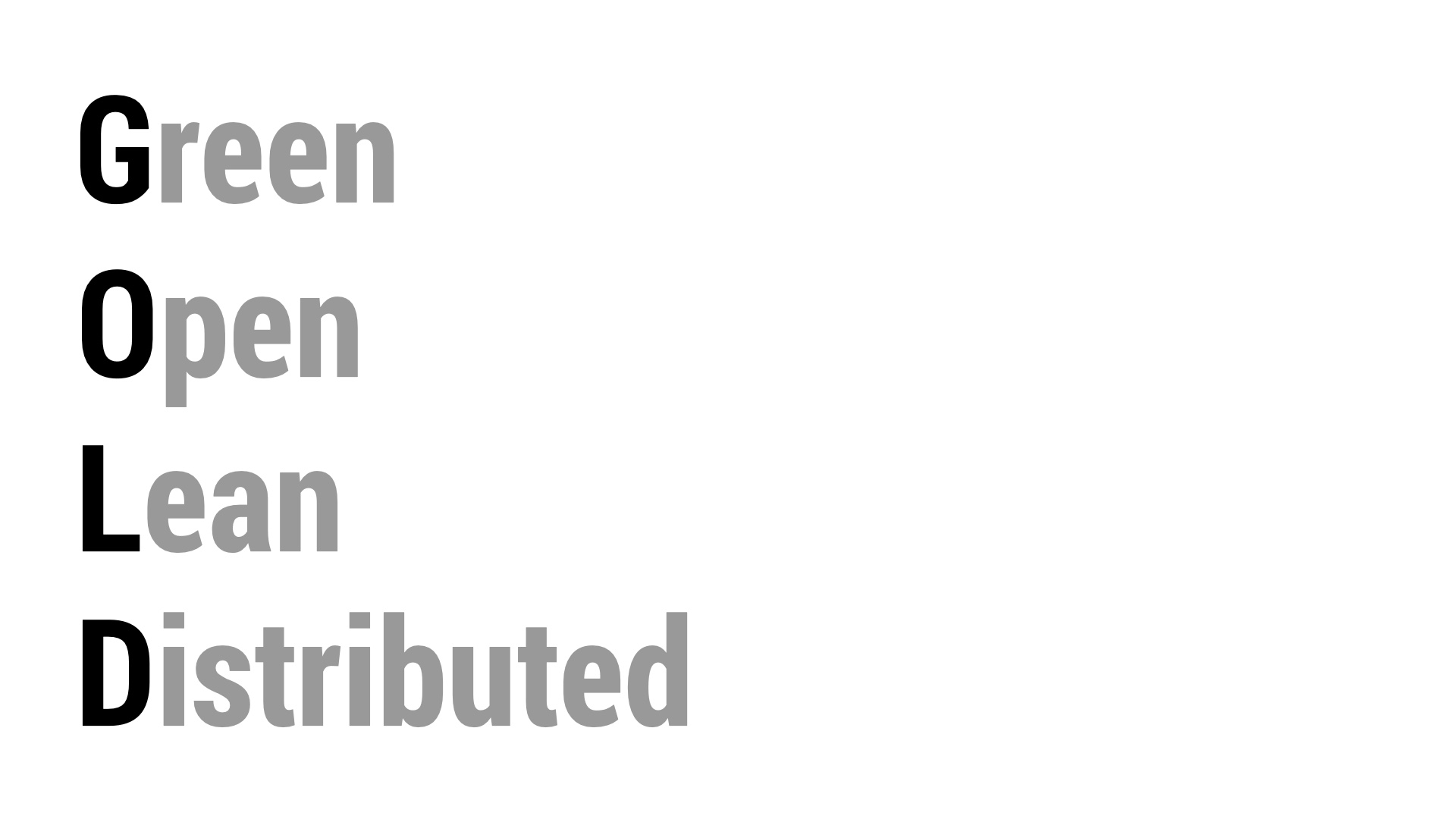
|
So that’s gold. Green Open Lean Distributed # |
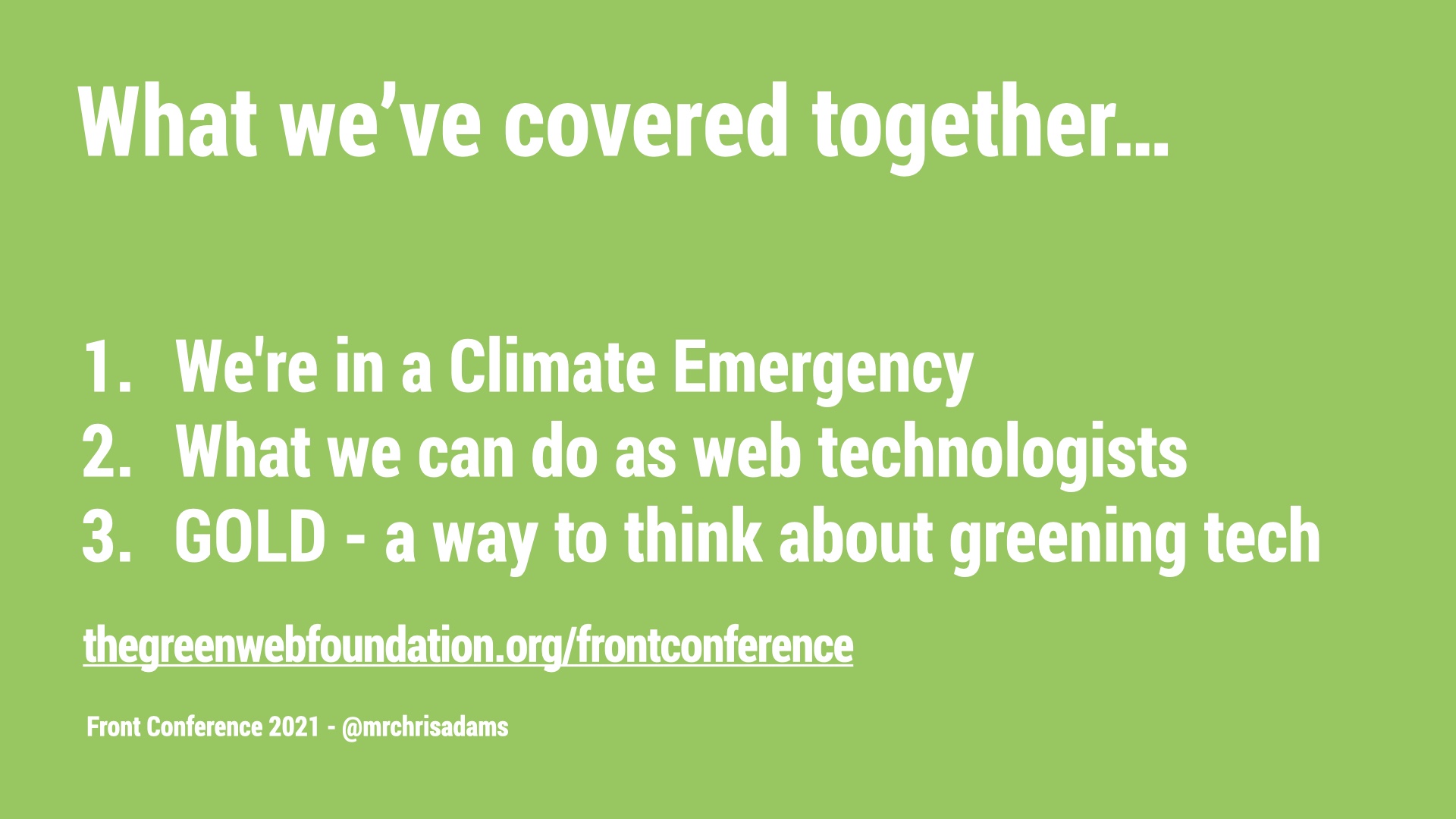
|
OK, so this is what we covered in the time we had together. I know it was fast, and there is a transcript of everything I said on the page at the link below, with a boat loads of references and further notes. # |
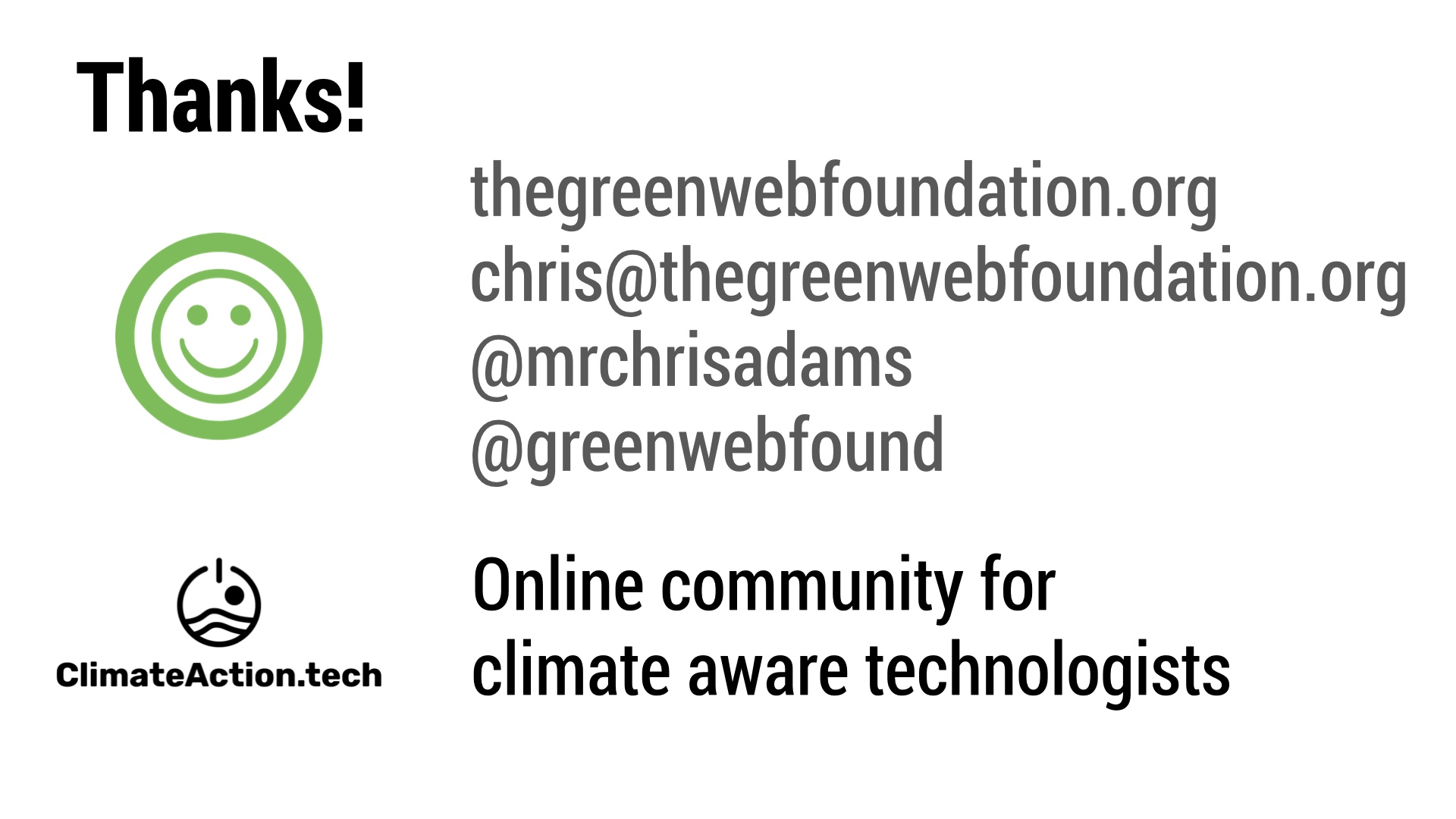
|
Finally, if this is interesting you, we’re running a fellowship to build a freely available syllabus for incorporating these ideas into how we work. Visit the site to learn more. This is how to stay in touch, and this is the online community I’m most active in. # |